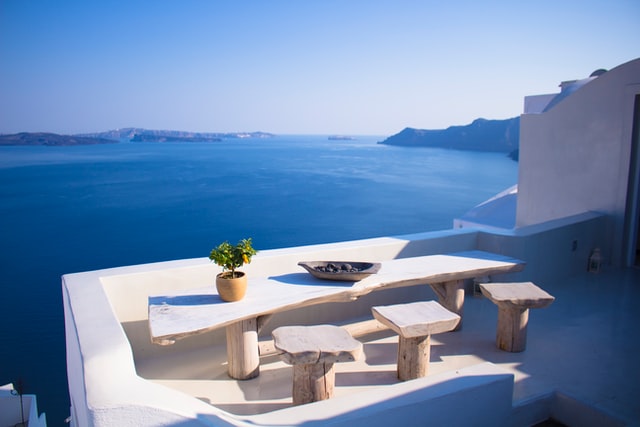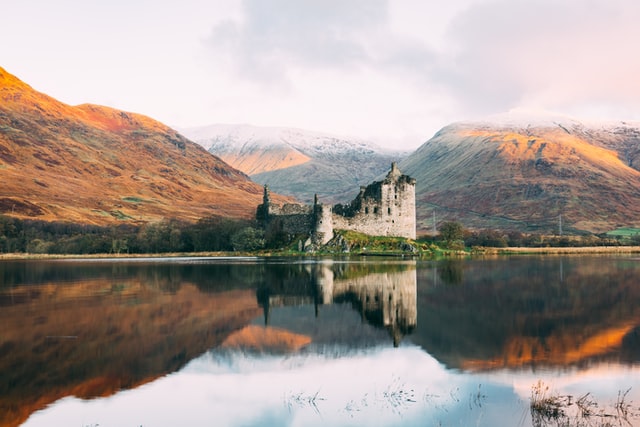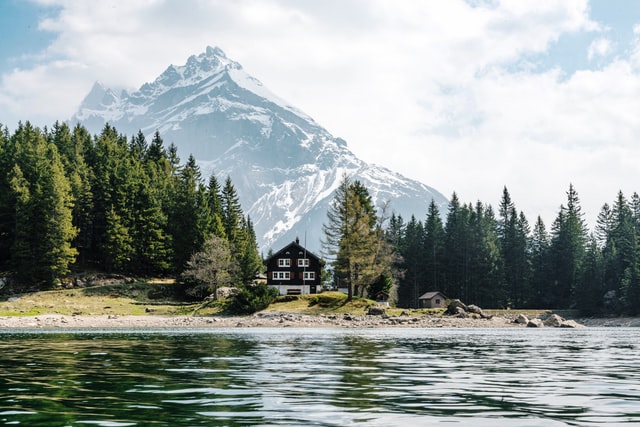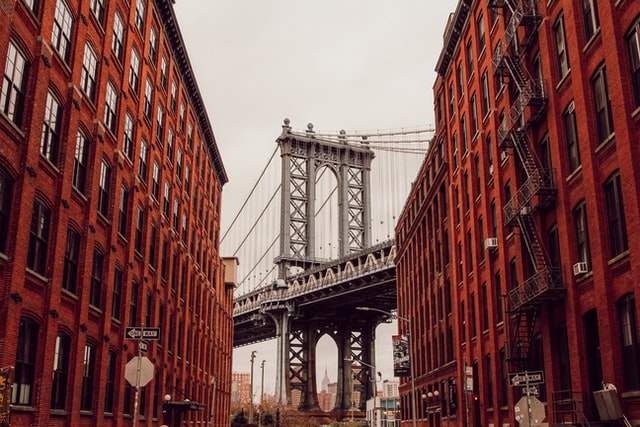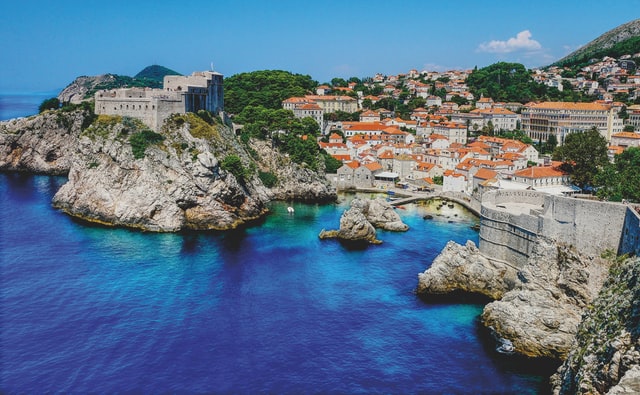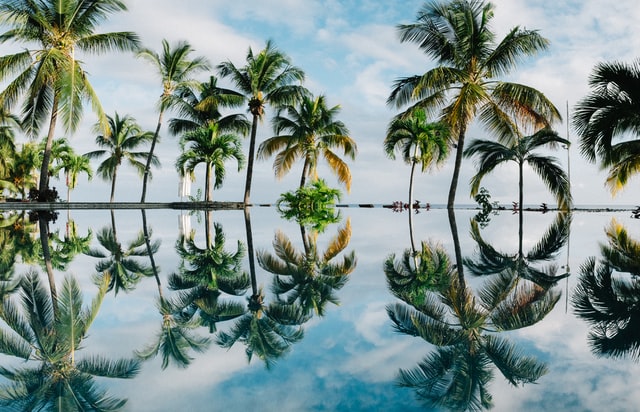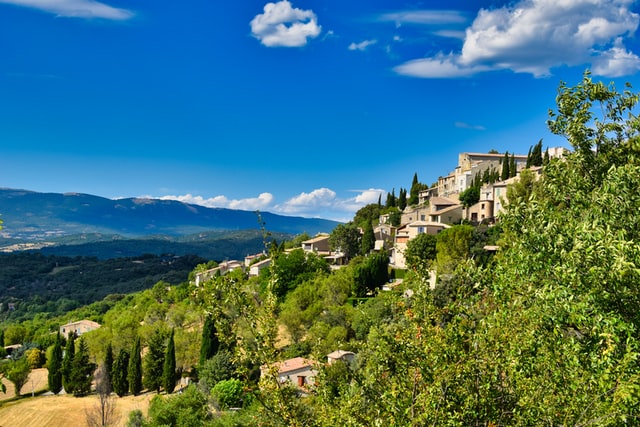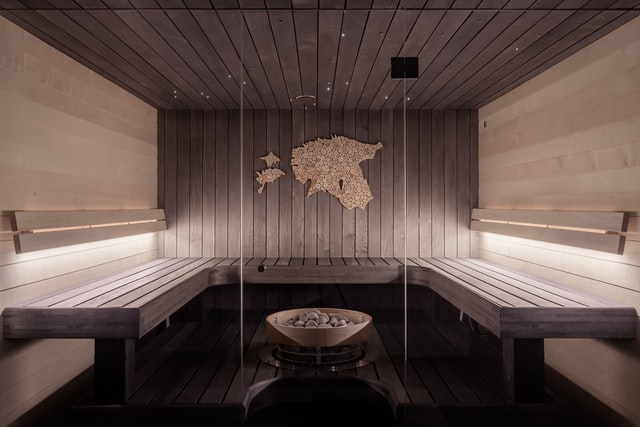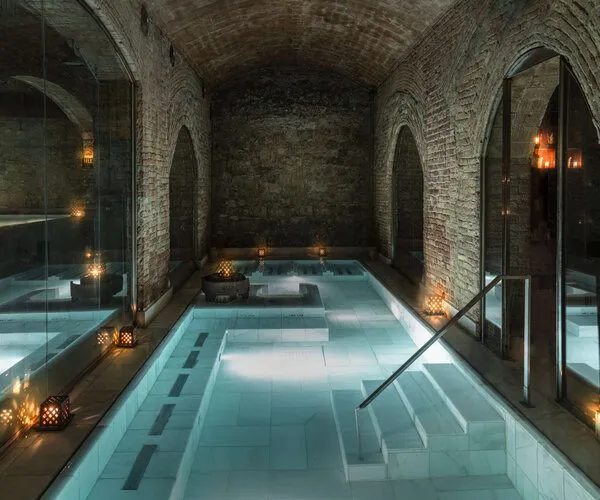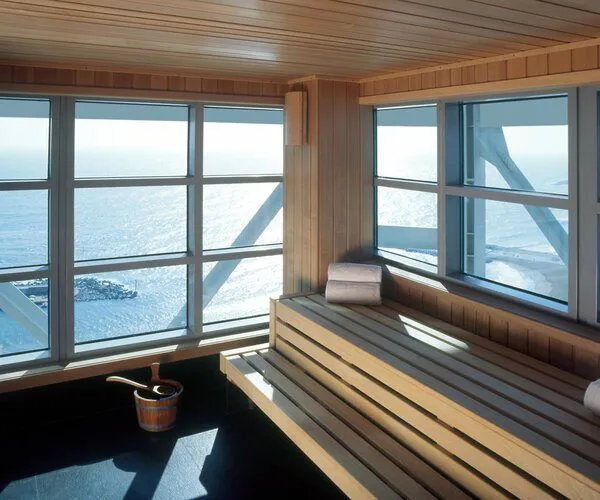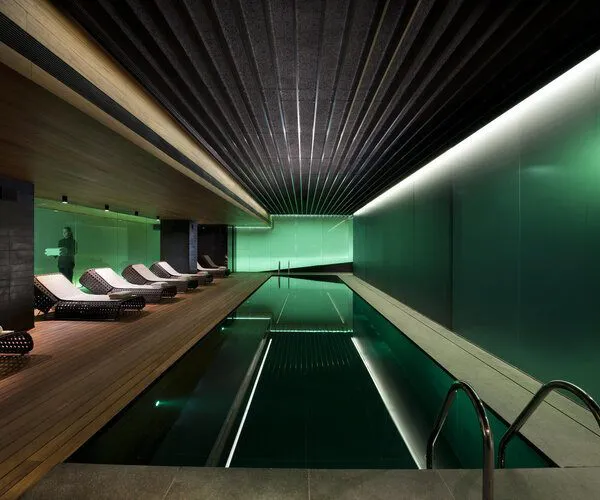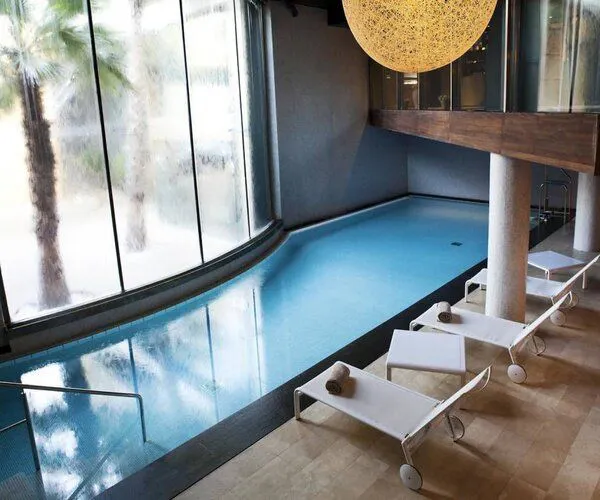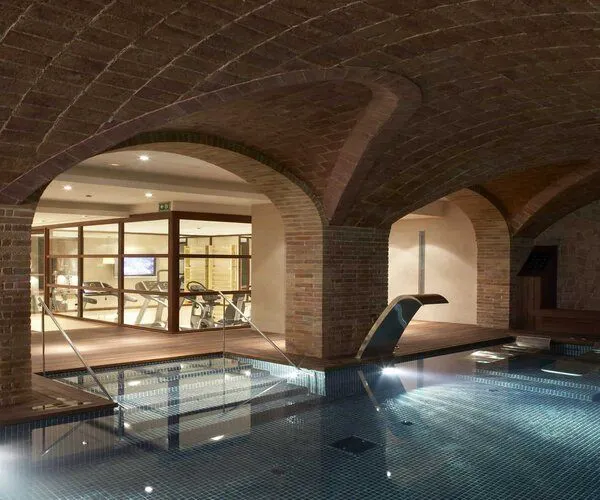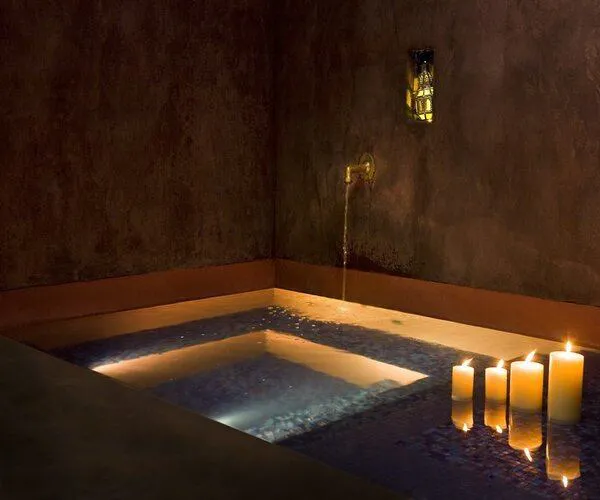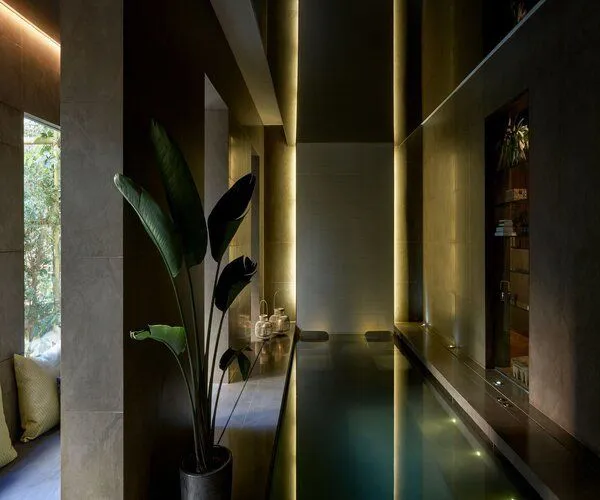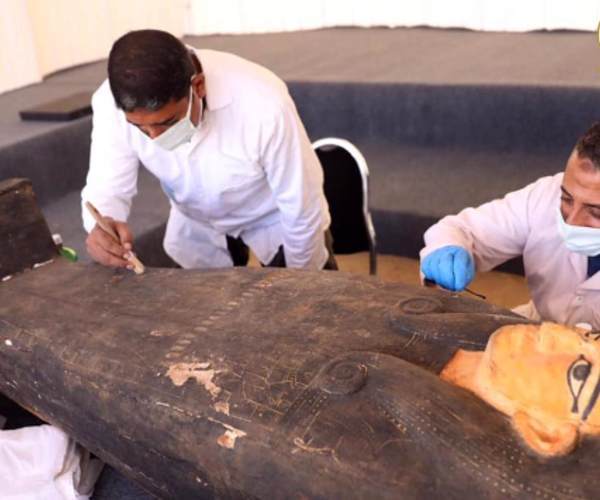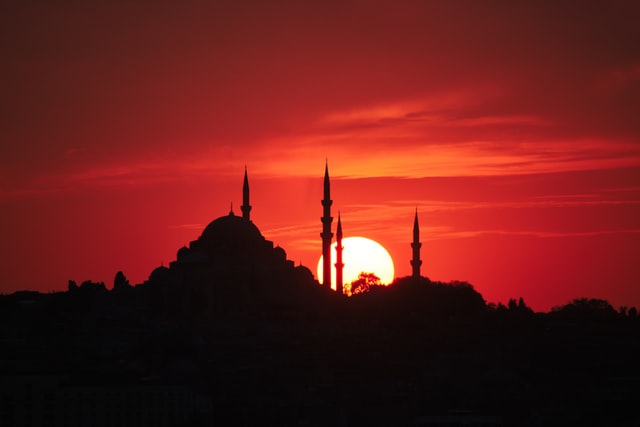Must-see places in North Wales
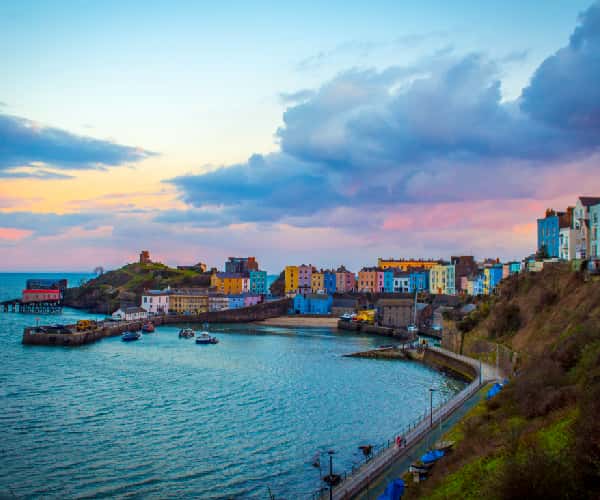
North Wales is a land of epic landscapes and changing environments. It is a place alive with action and a rich, distinctive culture of its own. Amongst the transient topography, you can find some real gems that make this place one of the most immersive places to explore in Europe.
Here you can find designated World Heritage sites, explore one of the world’s oldest living languages. Navigate your way around a land steeped in history and magic. Within the regions of Conwy, Denbighshire, Flintshire, Gwynedd, Ynys Môn (the Isle of Anglesey) & Wrexham – the counties that make up what we know as North Wales – you will find these amazing places and activities to lose yourself along the way.
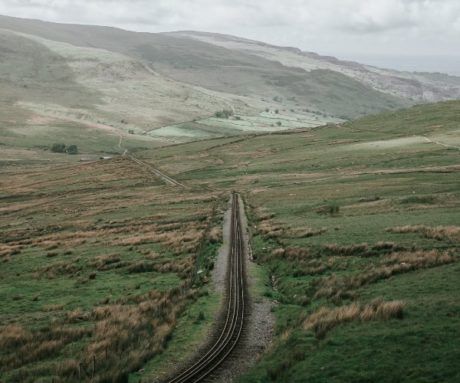
1. Snowdon: Find your way to the summit of the mountain, by foot or by rail
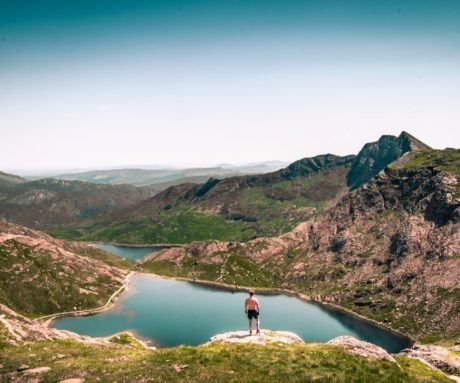
Snowdon is the highest mountain in Wales, found at an elevation of 1085 metres above sea level. It is the second-highest point in the British Isles behind the Scottish Highlands and Ben Nevis. Such is the awe of the mountain, it gives its name to the area that it touches: Snowdonia National Park.
There are many ways to climb Snowdon. Some argue that Snowdon, as an experience, is not limited to just the mountain itself. The act of reaching the summit is a prize that many aim for. And there are many routes to get there.
Many choose to walk the paths laid out. There are numerous routes around the climbs of Snowdonia. Whilst potentially countless ways to reach the summit, 6 designated and safe ways are more commonplace. These vary in the required expertise to navigate them. These would include the Llanberis Path, the Miners track, and the Pyg Track. Snowdonia is a walker’s paradise. But for the less able, there is the Snowdon Mountain Railway; a fantastic way to get to the summit and experience some history at the same time.
Trains depart from Llanberis station and begin their climb of the 1085m to the summit of Yr Wyddfa. This is a journey that over 12 million people have taken since 1896. No matter how you decide to scale the heights of Wales’ highest peak, the one thing that is for sure, and is the views will be amazing.
2. Discover the village of Portmeirion
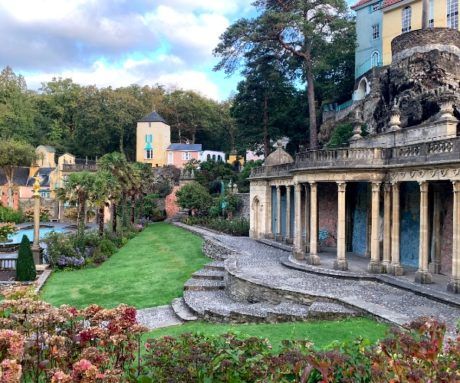
Portmeirion is a village in North Wales like no other. A village which itself is its own little peninsula in a corner of Snowdonia, near Porthmadog. A village that sits as a living and breathing monument and tribute to somewhere else. The village town was designed by Sir Clough Williams-Ellis in 1925. Portmerion was built in pure imitation of the rustic Italian village Portofino, to “demonstrate how a naturally beautiful place could be developed without spoiling it”. Due in no small manner to its truly unique charm, Portmeirion has carved a place in popular culture for itself.
Williams-Ellis’ muse for Portmeirion – Portofino – proves a fitting tribute to the atmosphere of the Mediterranean. The town has an iconic sense of nostalgia, and when you step into the colourful bricolage and veranda-led walls you will be instantly transported. It feels like nowhere else on earth. Nowhere, except maybe Portofino itself. Such is the beauty of the juxtaposition and the jarring architecture that engulfs this tourist hotspot.
In the 1960s, the spy drama ‘The Prisoner’ found its backdrop at Portmeirion. This led to a huge increase in visitor numbers which has stayed consistently high. Today, Portmeirion is a fixed spot on any tourist map of North Wales, whether its the first time you visit or the fiftieth. Make sure you don’t miss this quirky stop on your tour of this fantastic region.
3. Find a castle: Explore some history and take it home in your heart
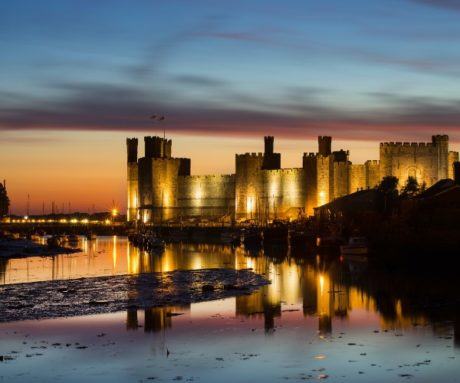
Wales is famous for its castles. There are more than 600 (six hundred) castles in Wales, more per square mile than anywhere in the world. For such a small country, we are a nation of castles. And North Wales has some of the finest examples. Some castles have been lived in continuously for well over a thousand years. Then there are those that are but ruins and remains. A lot of the castles are native to the Welsh landscape, but what most of them have in common is that they are usually always steeped in history.
Home to much noted of Welsh nobility or often outlying invader there are a stunning array of remaining examples of castles in North Wales. The mighty Caernarfon Castle, pictured, is just one example of the most visually alluring fortresses you’ll ever see. The castle is a 13th-century masterpiece and was built on a former Roman fort. Along with Edward I’s other castles at Beaumaris, Harlech, and Conwy, Caernarfon stands as a World Heritage Site.
No matter which castle you happen to visit, or even simply stumble across, you will find history in the stones and ruins. This history tells a story of Wales and it is one not to be missed. Make sure you pay attention.
4. Penrhyn Quarry: The fastest way to see some of North Wales
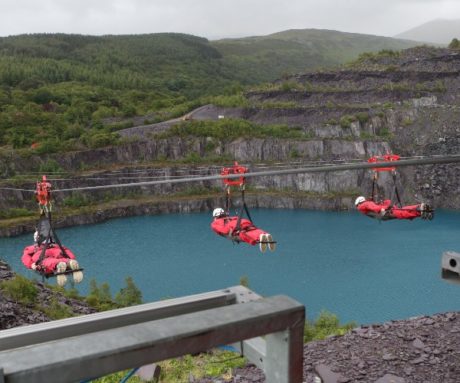
ZipWorld is located in the heart of the Snowdonia National Park and a ride on the zip lines will take you over the Penrhyn Quarry. It is home to an exhilarating adventure unlike any other. It showcases some of the most incredible views in North Wales and is a truly unique way to see some of the amazing landscape of Snowdonia.
ZipWorld is the world’s fastest zip line and Europe’s longest. Known as Velocity 2, it is Zip World’s best-known adventure. It features four parallel zip lines so that you can travel as a group and it spans one and a half kilometres over the beautiful blue water of Penrhyn Quarry lake. The beautiful waters underneath the lines is truly breathtaking. It is not uncommon to travel at speeds over the quarry of up to 100 mph. And afterwards, you can take in the scenery in a more relaxed setting in the boutique bistro setting which features local delicacies and food offerings.
It is a remarkable and unique experience in the heart of North Wales.
5. Drive through North Wales and experience the Great Orme
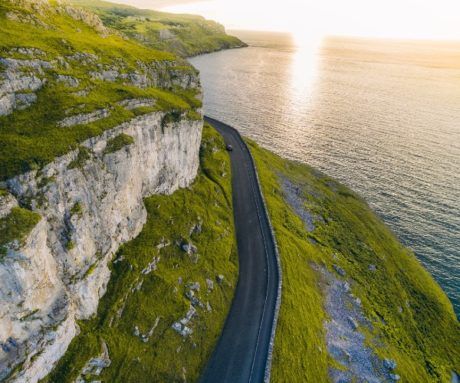
The Great Orme near Llandudno sets this part of the Welsh coastline aside from the rest. The coastal headland here has played an important part in Welsh coastal history.
The Great Orme headland in North Wales is a massive chunk of limestone – a mini-mountain that rises up alongside Llandudno – reaching a height of that rises 207m, coming straight out of the sea. The Vikings named it ‘The Great Orme’ which means ‘sea monster’.. mini-mountain and it’s rich in natural and man-made history.
There are a few ways in which to see The Great Orme, though it really can’t be missed. You can jump on the cable car and visit overhead, or there is also the Great Orme tramway. If you take the tram, you’ll soon find yourself at the top where you’ll find a lovely visitor centre in seasonal months. A walk is also possible, but such is the beauty and craft which has led man to build accessible roads onto it, many prefer to drive along it, taking in its beauty as they go.
Definitely one for the bucket list.
By Gareth Robinson
Yamabushi monks are Japan’s mountain ascetic hermits

For more than 1,400 years, Yamabushi monks have been walking Japan’s sacred mountains, believing that this harsh natural environment can bring enlightenment.
In an ancient forest of towering cedars, all was silence except for the chirping of unseen birds. Suddenly I heard the tinkling of a bell. Through the mist, a dozen figures emerged, walking in single file. Led by the Tolkienian figure of a man with a long grey beard, they looked like ghosts, dressed all in white.
They were Yamabushi: Japanese mountain worshippers. For more than 1,400 years, centuries before anyone spoke of “forest bathing”, Yamabushi monks have been walking the sacred mountains of Dewa Sanzan (literally, “the Three Mountains of Dewa Province”) in Yamagata Prefecture. But theirs is no pleasure hike. Through immersion in nature and rigorous self-discipline, the Yamabushi seek spiritual rebirth.
Yamagata lies in Tohoku, the northernmost region of Japan’s Honshu island. Much of Tohoku is isolated, mountainous and prone to some of Japan’s heaviest snowfalls. It is the land that haiku poet Matsuo Basho described in his book Narrow Road to the Deep North (1689).
The sacred status of the three mountains – Mount Haguro, Mount Gassan and Mount Yudono – dates to 593 AD when Prince Hachiko fled Japan’s then-capital Kyoto following the assassination of his father, Emperor Sushun. Prince Shotoku, the Emperor’s nephew, advised Hachiko to flee to Mount Haguro, where it was said he would encounter Kannon, the Goddess of Mercy. Prince Hachiko built shrines on each of the three peaks so that the mountain gods would remain there, thereby ensuring peace and prosperity for the region.
He established the mountains as a centre for Shugendo, a unique Japanese form of mountain worship that dates back to a time when mountains were considered to be deities. As it evolved, Shugendo incorporated elements of Shinto, Buddhism and Taoism.
Shugendo is the religion of the Yamabushi. “Historically, the Yamabushi lived on the higher mountains of Japan. They would spend years on end in the mountains,” explained Tim Bunting, Yamabushido Project Leader and Yamabushi Master Assistant. “For example, the Yamabushi who self-mummified to become Sokushinbutsu (Living Buddha) had to spend at least 1,000 days in the mountains.” The self-mummification process involved severe fasting over an extended period, and the practice was outlawed more than 100 years ago during the Meiji Era (1868-1912).

Today, there are some 6,000 Yamabushi in Japan. They believe that Shugendo’s ascetic training in the harsh natural environment of the mountains can bring enlightenment. To enter the “other world” of the mountains represents the death of their worldly self, “which is why they wear the white robes, or shiroshozoku, that are traditionally used to dress the dead,” explained Yamabushi Kazuhiro, a Yamabushi trainer and guide at Dewa Sanzan.
To become a certified Yamabushi, one must complete the week-long Akinomine Autumn Peak Ritual. The exact nature of the ritual is secret, but it is known to include activities like meditation under a waterfall, nightwalking and visiting places where the gods reside on the mountains and praying to them. After that, how long and how often they walk in the mountains is up to each individual. “Most Dewa Sanzan Yamabushi would at least repeat the Akinomine Autumn Peak Ritual every year. Some do their own training by themselves,” Bunting said.
Through this immersion in the mountains, they become one with the mountain’s spirit and re-emerge from the mountains enlightened. “In walking we are born again. We rejuvenate our life,” says Master Yoshino, a 13th-generation Yamabushi priest, now in his 70s, and head of the Haguro Yamabushi.
Dewa Sanzan became a popular place of pilgrimage some 1,400 years ago, according to Kazuhiro, “after Prince Hachiko helped bring an end to a plague that was decimating the local farming community”. After 100 days in seclusion praying for an end to the plague, the prince had a vision instructing him to make a huge fire. He shared his vision with the people, who then built a large effigy of a demon and burned it.
Miraculously, the plague ended.
During the Edo Era (1603-1868), pilgrimages to Dewa Sanzan gained popularity as a means of recovering one’s youthful vigour. Samurai warriors were among those who came to train here, and the climb became known as the Journey of Rebirth.

Prince Hachiko’s name is still invoked in times of crisis. In May 2020, a special fire festival was held at Dewa Sanzan shrine to pray for an end to the Covid-19 pandemic. “We hope to borrow the power of our founder Prince Hachiko and support the exhausted feelings of the people during the coronavirus pandemic,” a priest told the local Shonai Nippo newspaper.
Meanwhile, a growing number of people from around Japan and abroad are discovering the continuing relevance of Dewa Sanzan’s healing energy. Yamabushi training has changed little in the last 1,400 years. The difference is that now you too can join them. After some 30 years running courses in Japanese only, interest from abroad convinced Master Hoshino to start offering his courses in English too. “I live by the Yamabushi tradition and I teach others to do the same,” said Master Hoshino.
Several thousand people took the training course in 2019. “The course has been particularly popular with high-achiever Steve Jobs-types, overworked executives seeking to reconnect with themselves through a deep connection with nature,” said Hiroyuki Yoshizumi, a Yamabushi at Haguro Tourist Office, who arranges Yamabushi experiences for visitors. “Many return to take the course three or four times.”
There are various options, including one-day, two-day and four-day courses, with accommodation usually in Shukubo, or pilgrim’s lodges, dotted around Mount Haguro. Participants must walk in silence for the entire duration. Also, no phones, no watches, no brushing teeth, shaving, reading or writing are permitted.

Only one word is permitted to be spoken during the entire course. “When the Master Yamabushi gives you an instruction, you have to respond by saying ‘uketamou’ (I accept),” explained Tokyo-based PR consultant Yumiko Nishitani, after completing the one-day Mount Haguro hike. “Through this routine,” she added, “you learn to accept everything as it is. This way, participants are forced to live in the moment. So, Yamabushi training is for not only for enlightenment and self-discovery but also for mindfulness.” Challenging as this sounds, it helps you transcend your habitual ways of thinking and acting, and focus on the present moment rather than fretting about the future.
We want people to face themselves, to look at the feet they are standing on, and to feel a connection with nature, society, and the world,” said Maiko Ito, a Yamabushido Project Leader. “Once you know yourself, you start to think about what you want to do, and what you should do and how you can best participate in society.”
For the Yamabushi, each of the three mountains embodies a different deity and a different step on the road to rebirth. Mount Haguro represents the present, and people pray here for worldly happiness. Mount Gassan, the Mountain of the Moon, is the past, where the spirits of the ancestors rest. Here, people pray for a peaceful afterlife. Mount Yudono is the future, and the place of rebirth.
The trek begins at the great red torii or gateway at the foot of the mountain. Like all torii, it marks the entrance to sacred ground where deities dwell. Just 414m tall, Haguro is the only peak to remain open all year, while the other two taller montains spend winter snowbound.

Haguro is home to a splendid five-storey wooden pagoda that rises 30m high amid the trees like a natural part of the forest. A few metres away looms the equally marvellous Jiji-sugi or Grandpa Cedar. Believed to be more than 1,000 years old, this Designated Natural Monument wears a shimenawa rope around its trunk, indicating the tree’s sacred status (in both Shinto and Shugendo, trees, rocks, rivers and other natural phenomenon are believed to be inhabited by deities).
From here, a spectacular stairway of 2,446 stone steps (about 1.7km) leads to the summit. The path, dating from 1648, is lined with 580 cedar trees, some more than 600 years old. Immersed in utter silence among these magnificent trees, the niggling worries and noisy chatter that usually clutter your mind are replaced by a serene well-being, like when you meditate. As Master Yoshino said, “we leave ourselves in Nature, we make space in our minds.”
Finally, you arrive at the Sanjin Gosaiden shrine where the deities of all three mountains are enshrined, making it a major place of worship. Its thatched roof is more than 2m thick – the largest in Japan.
Mount Gassan, the second peak, is the highest and most imposing of the three mountains, standing at 1,984m. A long ridge connects Gassan to the other two peaks, offering superb vistas of the surrounding countryside. Gassan’s open pastures and fresh breezes contrast with the deep forests of Haguro. Your heart smiles at the sight of myriad alpine flowers around the wetlands of Midagahama Moor. As Gassan is the abode of the spirits of the ancestors, you are symbolically passing through the Land of the Dead on your way to rebirth.

The climax of the hike is Mount Yudono, the 1,504m mountain of the future, and holiest of the three peaks. Half way up is a copper-coloured boulder where hot spring waters gush out. This spot is so sacred that no photos are permitted. It is forbidden to even speak in detail of what you have seen at the shrine, said to be the point of rebirth. As Basho wrote:
I cannot speak of Yudono
But see how wet
My sleeve is with tears
What I can tell you is that Mount Yudono is also home to a spectacular dual waterfall that thunders into a rock pool below. Here participants are instructed to stand under the icy cascade while reciting a sutra for a teeth-chattering minute. With a hearty “Uketamo!” you stride into the pool. Unsurprisingly, this part of the programme is discontinued once summer passes, when it becomes too cold for all but the hardiest of ascetics.
But if cold showers and strenuous hiking are not for you, there are other less-demanding options, like the one-day Mount Haguro-only hike. As Kazuhiro explained, “That way, you still get to visit Dewa Sanzan shrine. The deities of all three mountains are enshrined there, so it’s the same as visiting all three peaks.”
Now anyone, regardless of age or fitness, can experience the therapeutic effects of Dewa Sanzan’s Journey of Rebirth. As the Yamabushi motto proclaims: “Back to Nature, back to yourself.”
By Steve John Powell & Angeles Marin Cabello www.bbc.com
Enjoying a “workoliday” in Portugal
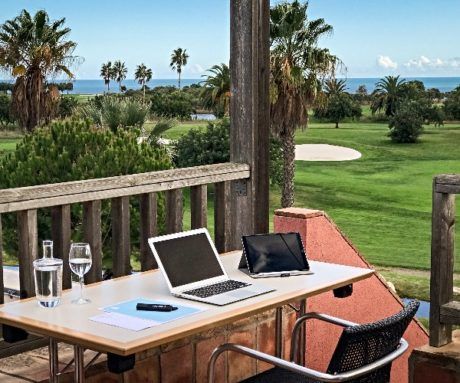
In time, lockdowns will come to an end and the pandemic will be under control. However, some trends we adapted as ‘the new normal’ in the past year may be here to stay, such as remote working. For those who can work from home, some may consider travelling to different locations and enjoying a “workoliday”.
Portugal airport guides: https://airguideonline.com/category/airport-guide/airports-europe/
Portugal is the ideal destination for remote working. Digital nomads can enjoy 300 days of sunshine a year, good value for money, delicious food and wine, great golf courses, over 3800km of certified walking and hiking trails and much more. Read on to learn more about working remotely from Portugal.
Working from Madeira
The Madeira Islands have the perfect conditions to attract digital nomads, from its natural beauty and endless activities, to it’s culture and year-round great weather.
Due to the increase in demand for remote working in Portugal, the Madeira Digital Nomads program was launched. This initiative was developed by the Regional Government of Madeira, through Startup Madeira, and aims to attract digital nomads from all over the world to come to work from Madeira.
The Madeira Digital Nomads program allows professionals from major companies and digital entrepreneurs to make Madeira their home for periods between 1 and 6 months, living as locals in communities around the island. The initiative’s pilot program will run February 1st – June 30th, 2021.
Workation packages in the Algarve
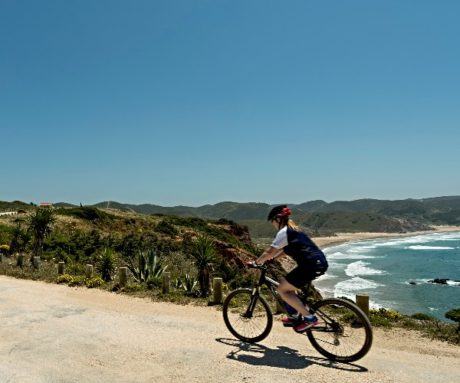
Home to incredible landscapes, beautiful beaches and fantastic weather conditions, it easy to see why Portugal’s Algarve region is quickly is attracting more and more remote workers from all over the world.
Once work is finished, visitors can enjoy a walk on the beach, a bike ride along the coast, or a round of golf. And at weekends, discover the beautiful towns of the Algarve. Explore authentic fishing villages like Olhão, historic towns such as Silves, or panoramic views from the mountains of Monchique.
João Fernandes, President of Algarve Tourism said “With first class healthcare and with English widely spoken, it is a perfect place to work from for an extended period”.
There are a diverse selection of long stay rental accommodation options available to guests, ranging from serviced apartments, vineyards, homes on golf resorts to boutique hotels and resorts. Read on to learn more…
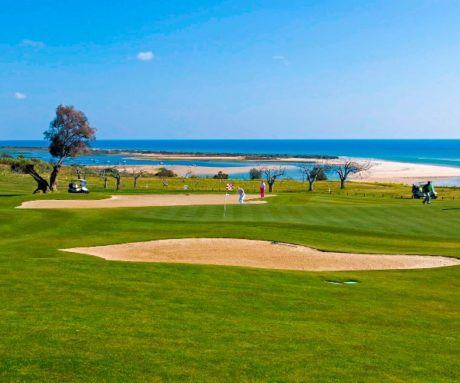
Hotel Faro, a four-star property overlooking the Ria Formossa natural park in Faro, is offering special rates for extended stays for digital nomads. Their remote working package includes high speed wi-fi, TV in the room with HDMI connection, second monitor and laptop support option, private meeting room options as well as access to the hotel’s coworking space.
Visitors can relax after work at the hotel’s rooftop bar and restaurant, boasting panoramic views over the nature reserve, or unwind in the heated outdoor pool, gym, sauna and Turkish bath. Long stays will also benefit from a 15% discount on food and drinks. Rates are €825 for 15 nights and €1500 for 30 nights Valid between October 2020 and May 2021.
Four Seasons Fairways, situated in Quinta do Lago and close to the Ria Formosa nature reserve is the ideal setting for a workation – combining blue skies, peaceful and private villa accommodation with hotel style facilities to cover everything you need for remote working and play. Between work commitments, the Clubhouse awaits – home to stunning heated indoor & outdoor pools, Kids’ Club, wine cellar, fully equipped gym and cleverly designed indoor-outdoor bar. Winter Offer: Four Seasons Fairways offer 7 nights in a two or three bed apartment with pool or jacuzzi on a self-catering basis from €600 travelling December 2020/January 2021
For a more rustic and countryside environment, one of the oldest vineyards in the Algarve, Morgado do Quintão, is offering extended farm stays for remote workers. The property has various houses to rent on the estate, each with its own swimming pool and outside area. The homes are centred around a large family property restored in the early 1800s. The vineyard is located between Silves, Monchique and Lagoa. They offer special rates for longer stays and provide artists and those working in the creative fields with special terms on bookings until May 2021.
ROBINSON, TUI’s premium club provider is also offering digital nomads the opportunity to work and live in paradise. The Workation @ ROBINSON is available at the ROBINSON Club Quinta da Ria from January 2021.
Workers are given rooms in a quiet location that are fully equipped to all their working needs, whether that’s fast and stable internet connection for video conferences or an ergonomic desk chair in a separate office. After work, visitors can enjoy the golf course, a relaxing massage or a tennis or a bike tour in the surrounding nature reserve. Prices start at €67 per person/night in a double room. For stays of over 15 nights a 30-minute spa treatment is included, and over 29 nights an additional private transfer from and to Faro is included.
Wyndham Grand Algarve has just released a unique and personalized package for ‘Digital Nomads’ for stays from 1st February until 1st April 2021, with bookings available until 15th March 2021. This package includes a very advantageous discounted rate for stays of 14 nights or more in a One Bedroom Suite, buffet breakfast, a daily late evening drink in the Lobby Bar, a complimentary nature experience in Ria Formosa Natural Park and transfers from/to Faro Airport. During the stay, guests will also have free access to the SPA, stay active in the state-of-the-art gym or swim in the indoor or outdoor swimming pools.
The five star Hilton Vilamoura is offering two new programs to facilitate remote workers:
HOMEinALGARVE is an extended stay package applicable to free upgraded suites and one- or two-bedroom, fully equipped apartments. Each comes with a comfortable well-lit work area with a desk and chair set in a spacious lounge, plus extras such as free tea & coffee. Rates for extended stays are from 90€/night for a minimum 15 consecutive nights booked.
Hilton Vilamoura Home Office offers additional ready-to use solutions in a private Business Floor where guests can work alone or opt for co-working. All options have access to free high-speed Wi-Fi, office support services plus the extensive resort facilities of swimming pools, gym, kids club, beach, golf and spa. Home Office rentals from 50€ /3 hours use.
Other workation packages are available from Cascade Wellness Resort, Cardeal Suites & Apartments, Portobay Falesia, Agua Hotels Alvor Jardim, Holiday Inn Algarve, Vidamar Hotel Resort, Monte Santo Resort, MGM Muthu Hotels Albufeira, Hotel Quinta do Marco, Burro Ville and Rocha Brava.
For further details on all these hotels visit www.algarvepromotion.pt
Work remotely in Lisbon

Lisbon, the capital of Portugal, is an authentic Portuguese city, where old meets new, known for its combination of ancient history, cultural entertainment and hi-tech innovation. The seaside capital is a great destination for remote workers interested in soaking in all the colour, culture and sunny weather that Portugal has to offer.
Hotel Roma has a great offer for remote workers visiting Lisbon. From €55/night, digital nomads will receive a free executive room upgrade, breakfast every morning, 15% discount in the hotel’s restaurant and wine bar, Wi-Fi and necessary cables as well as tea, coffee and water in your room each day.
The Corinthia Lisbon are dedicated to taking your work as seriously as they take your comfort. So, where better to work from when you need a change of scenery. Achieve your best working day yet, in a safe, flexible environment, with access to business facilities, a meeting room, refreshments, gym time and more, all included from €110/night.
If you’re longing for a luxurious work space in Lisbon, then the five-star Palácio Estoril Hotel Golf & Spa is the perfect option for you. The hotel’s long stay packages are designed so that you can work and live in Lisbon in comfort, security and with great service. Prices start from €1000/pp for 30 days and include your accommodation with breakfast, daily room cleaning, free parking, access to the Banyan Tree Spa, dynamic pool, jacuzzi, Turkish bath, sauna and gym. Guests will recieve a 25% discount on massages, 10% discount on Food & Beverages, free Wifi and 24h security.
The Corpo Santo Lisbon Historical Hotel is located in the historic district of Cais do Sodré, in the heart of the city of Lisbon and on the banks of the Tagus River. This hotel is offering long stay options for remote workers of up to 12 months. The hotel’s location makes it the prime spot to explore the beautiful city of Lisbon after your day’s work has ended. Walk to some of the most iconic tourist attractions in the city, such as Praça do Comércio, Chiado, Bairro Alto, the Santa Justa elevator, Lisbon Cathedral to name but a few. The Corpo Santo Lisbon packages start from €1000/month and include daily cleaning, free Wifi, gym access, 50% discount on laundry, 20% discount at the hotel’s Porter Bistro restaurant as well as 24/7 hotel support
Other long term accommodation options for remote workers in Lisbon include:
Tivoli Avenida Liberdade Lisboa
Pestana Palace Lisboa
Atlis Prime Hotel Lisbon
StayUpon Hospitality Group
Aldeia dos Capuchos
Four Seasons Hotel Ritz Lisbon
Farol Hotel
InterContinental, Lisbon
The One Palácio da Anunciada
Turim Av Liberdade Hotel
BessaHotel, Liberdade
Hotel My Story, Figueira
Lisbon Heritage Hotels
Hotel Holiday Inn Lisbon – Continental
B&B Hotel Sado Setúbal
Hotel Star Inn, Lisboa
Melia, Setubal
Mercure Lisboa Almada
Four Points by Sheraton Sesimbra
Hotel Cascais Miragem
VIP Executive Arts Lisboa
VIP Executive Santa Iria
VIP Executive Zurique
Iberostar Selection Lisboa
Hotel Bairro Alto, Lisbon
Arribas Sintra Hotel
The Beautique Hotels
Planning your stay for Autumn? This is perfect season for golfing in Lisbon. After finishing your days work, pick up your clubs and put your game face on in a beautiful golf course at one of city’s best golf hotels offering long stay packages, Choose from a number of accommodations including Montado Hotel & Golf Resort, Golf Aldeia dos Capuchos, Penha Longa Resort or Oitavos Dunes.
Other golf hotels in Lisbon offering long stay options for remote workers include Dolce CampoReal Lisboa, Guardian Bom Sucesso Golf, Quinta da Marinha Golf Club, Estoril Golf, Troia Golf and Orizonte Golf.
Work and surf in Santa Cruz
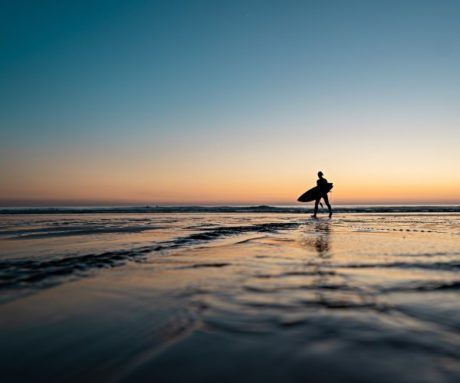
Noah Surf House, Portugal, is currently closed but it won’t be forever! So, if you are a lover of surfing, this may be the perfect option for you…
Located in Santa Cruz, just outside of Lisbon, Noah Surf House is just a two-minute walk from a beautiful beach, Praia de Fisica! The property consists of 8 rooms and 13 bungalows, all of which are decorated in an unique way. It also boasts an on-site restaurant with flavours from all over the world, a snack and bar service, a rooftop with an outdoor Jacuzzi and sunset deck, an ocean store, a meeting/leisure room, an outdoor swimming pool, an organic vegetable garden, a sport centre, a gym, a skate park and a fully equipped kitchen to share with other guests!
Noah Beach House is the hotel’s beach restaurant, located on Praia da Física in Santa Cruz. Separate to the on-site restaurant, the Beach House offers about 60 seats, a bar, beach concession and a surf school. It is also available to host private events. The restaurant’s menu is based on traditional Portuguese cuisine and uses mainly local products. Food and beverage suppliers are mostly local as well, representing 75% of total suppliers.
Both Noah Surf House and Beach House were built on five distinct values; Sustainability – economic, social and environmental. Originality in every initiative. Accuracy on each activity. Trust between employees and guests. Joy to promote moments of relaxation and happiness. Here, digital nomads can combine work with activities like surfing, yoga, stand up paddle boarding, walking or hiking.
By Paul Johnson
Safe destinations to explore in Latin America
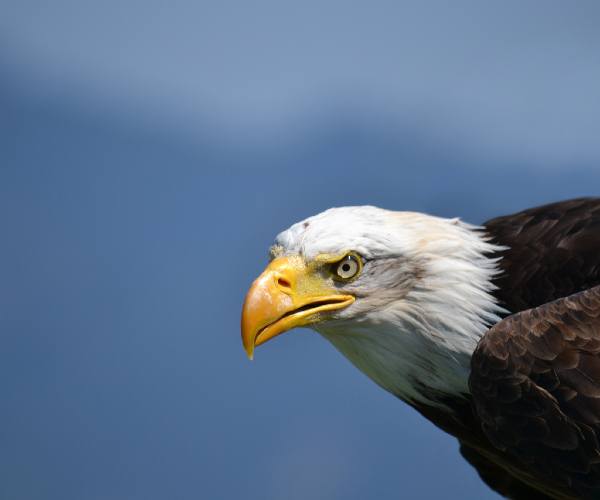
Pfizer’s COVID-19 vaccine has cleared its latest hurdle, with the FDA approving the vaccine for emergency use. This is clearly exciting, and good news for those eager to travel again. In the meantime, there are still restrictions on where Americans can travel.
But before you start planning your trip, it is important to ask yourself: “should I travel?” This is an individual decision, and some factors to take into account are:
- your age (if you are over 70, reconsider travel right now)
- your immunity levels and overall health
- the prevalence of COVID-19 in the areas you are traveling to
- the availability of travel insurance to cover you if you require hospitalization
Naturally, if you have COVID-19 you should not travel.
Before making any plans, check the U.S. State Department’s travel advisory page, which has links to country pages that explain restrictions. The countries on the following lists do not necessarily have low rates of COVID-19. The situation for each country can change rapidly, so always check for updates before you travel.
The following countries allow Americans to visit with no testing or quarantine, along with ways you can fulfil your New Year’s Resolutions and make a difference whilst there, in sustainable luxury:
Mexico
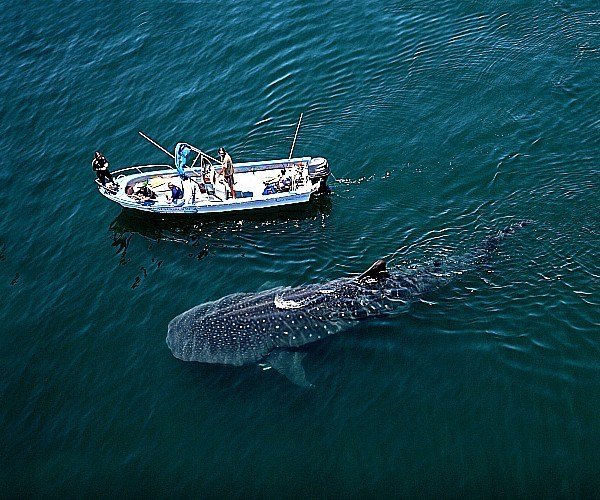
You can enter Mexico by plane (including private jet), and the Yucatan Peninsula is a fantastic choice for the Holidays. You can take a cooking class, relax on the beach, or get active and explore the Mayan ruins of Chitzen Itza and Tulum, swim in your own private cenote (freshwater sinkhole), snorkel, swim with Whale Sharks (seasonal), or discover the spectacular Sian Ka’an biosphere reserve. Whilst there, make your time in Mexico meaningful and teach at a school, sort donated clothes and food, renovate classrooms, or entertain the elderly at a Seniors Home, all in Cancun.
Costa Rica
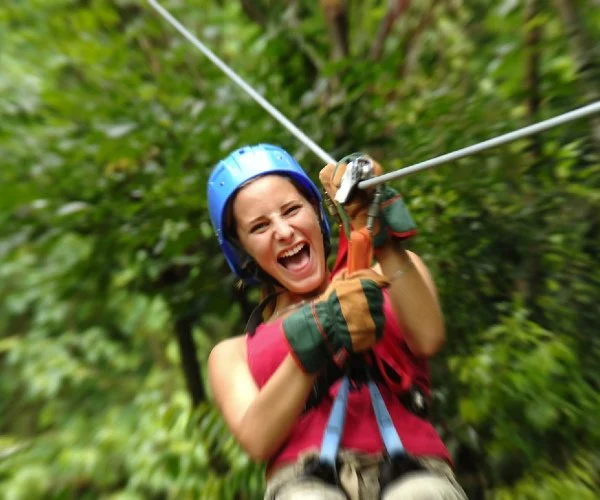
All Americans can now enter Costa Rica, and no test is required.
January is peak season in Costa Rica, and this is another destination is normally booked out many months ahead, so this is an excellent opportunity to stay in one or more of the fabulous eco-luxury lodges and hotels that Costa Rica does so well.
Another plus for Costa Rica is that it has a dazzling array of luxury villas where you can be more socially distanced.
Costa Rica is an enchanting, welcoming country where you can view volcanoes, zip-line, kayak, spot wildlife, surf, snorkel, and much more.
Give life to your New Year’s Resolutions by helping at a medical clinic caring for Nicaraguan refugees: take patient notes during consultations, enter patient data, dispense medications in the pharmacy, and help make patients feel comfortable.
Or, inspire your kids to be wildlife conservationists by helping at a wildlife rescue center or at a turtle protection site.
Peru
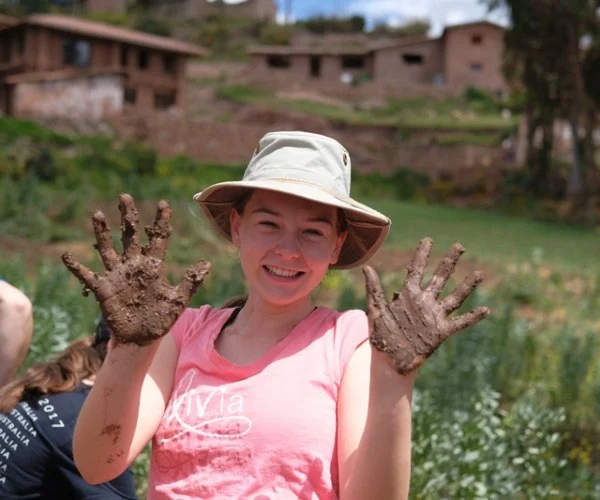
Peru has also announced that travelers can now enter, and commercial flights from the US are available.
The requirements are:
- Certificate of a negative RT-PCR or antigenic test result taken within 72 hours or less prior to arrival. You can also present a COVID-19 Discharge Certificate;
- A digital health affidavit and geolocalization authorization, issued within 72 hours or less prior to arrival;
- In the case of children under 12, they only require a “Good Health Certificate”. This is not an internationally standardized document, and I understand that a letter issued by a pediatrician attesting to the good state of health of the minor will suffice;
- Quarantine is not mandatory when entering Peru unless you present any contagion symptoms upon arrival;
- The Ministry of Health has imposed mandatory self-checkups.
Machu Pichu is open and ready for your visit; for now, only 75 visitors are allowed per hour on-site, which means a total of 675 passengers per day, so fewer crowds! However, strangely, children under 12 are currently not allowed to enter.
If time permits, I highly recommend the luxury lodge-based Salkantay Trek to Machu Picchu, complete with jacuzzis and massage treatments, and of course the views each day are spectacular.
Combine this with the delights of Cusco, Lima, Arequipa, Lake Titicaca, and the Amazon jungle, and make a difference in January by building a bathroom block in a Sacred Valley village that would appreciate your help.
Brazil
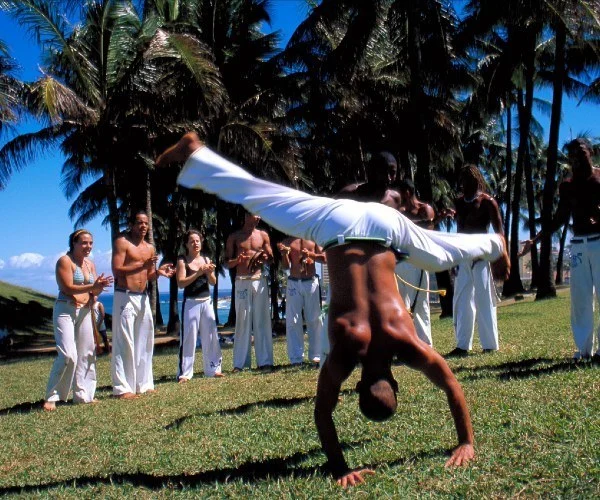
Health insurance covering COVID-19 is required for entry to Brazil. A good operator can assist you with this.
This vast, vibrant country has so much to explore, from the jungles and waterways of the Amazon to the spectacular wildlife in the Pantanal, from stunning Rio and culturally-rich Salvador, from the awe-inspiring Iguassu Falls and sand dunes of Lencois Maranhenses, to the gorgeous beaches of Paraty and Buzios for some serious relaxation time. You can help run sports clinics in Rio to get 2021 off to a positive start.
The Dominican Republic
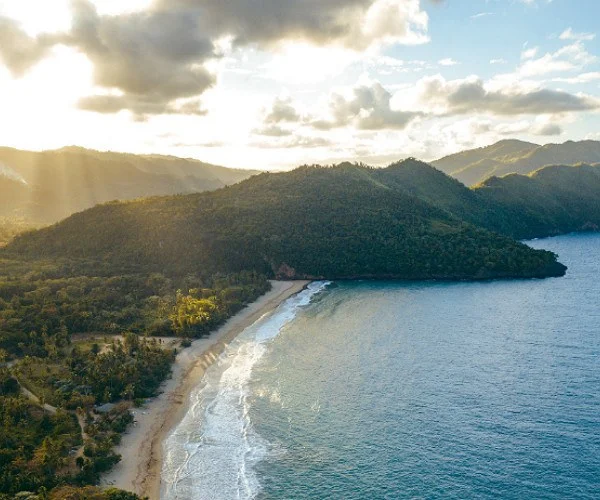
The Dominican Republic no longer requires COVID tests, so you can go there with ease.
In addition to relaxing on the beautiful beaches, take a walk through Santo Domingo’s Zona Central, the oldest European city in the Americas, descend the 27 waterfalls of Damajagua, white-water raft on the Caribbean’s only raftable river, and you can help create a basketball court or provide healthy meals to young Dominicans and make 2021 extra-special.
The following destinations allow Americans to enter, with some restrictions:
Belize

Taking a PCR test within 72 hours of your arrival date will help ‘fast track’ your arrival process. You may still be required to take a test on arrival. You must stay at Gold Standard approved hotels, and travel with Gold Standard approved guides and operators.
This small country, the only English speaking one in Central America, has packed in so much, from jungles to Mayan ruins, to chocolate making, wonderful beaches and of course the Barrier Reef – the 2nd longest in the world.
Make your time in Belize fulfilling and inspire your children to be world changers by building an eco-friendly stove for a Mayan family.
These stoves are fantastic in that:
- They replace open flames, so are much safer, especially with young children running around;
- They have a chimney to expel the smoke, reducing respiratory problems such as asthma and lung cancer;
- They are much more fuel-efficient, so are better for the environment than burning on an open stove.
Ecuador
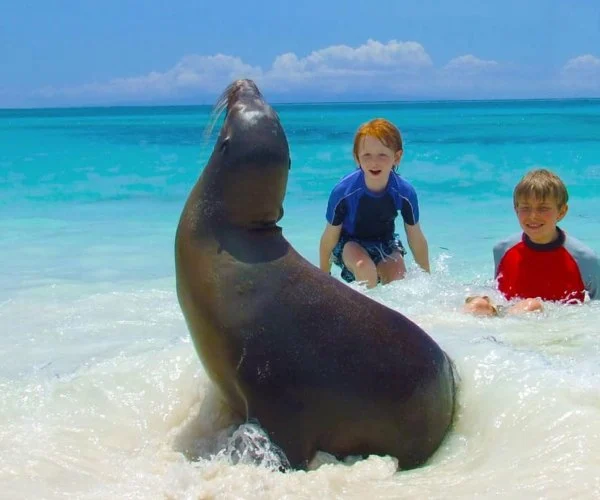
A COVID-19 test is required, and if you pass, the rare opportunity to discover the wildlife on the Galapagos Islands with few tourists awaits. Other parts of Ecuador, including the Amazon, Quito, Mindo Cloud Forest, Otavalo Markets, colonial Cuenca, and more are all well worth exploring.
Show your children that 2021 will be a positive year by renovating a low-income daycare center or caring for the children in the center.
This is a fluid situation so the status of the destination you are interested in may have changed by the time you read this.
By Christopher Hill
Experiences on a yacht charter in the Bahamas
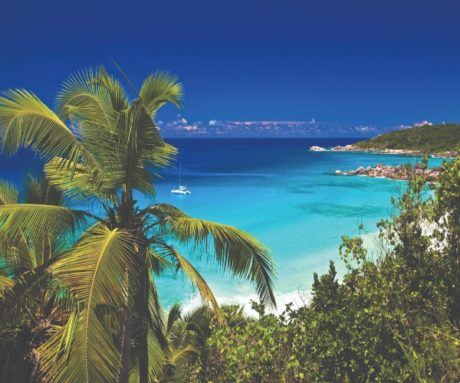
An unsurpassed destination south of Florida, the beautiful islands of the Bahamas are easily accessed and perfect for a yachting voyage of discovery. It is surprising how truly uncrowded and unspoiled these islands are, considering how close they are to the mainland. A yachting haven offering sheltered harbors, diverse sailing grounds and deserted islands, this archipelago also has many protected territories where flora, fauna and marine life flourish.
Boasting almost a quarter of the earth’s coral, this is a diving and snorkelling destination with an underwater world like no other. Sprinkled like jewels across the ocean, the plethora of islands and cays deliver endless possibilities for relaxed navigation, with gentle trade winds and year-round summery temperatures. It is no wonder that seeing the world from your own private yacht in the Bahamas is an extraordinary experience.
Andros
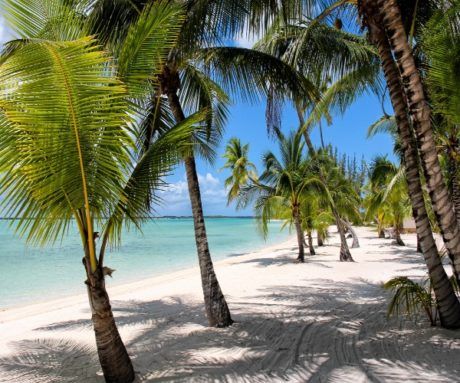
Andros is the largest island of the Bahamas chain. Lush and green, there are numerous adventures for outdoor lovers with excellent dive sites, plus deep-sea and fly-fishing opportunities. Divided into North, Central, South Andros and Mangrove Cay, the island’s vast landmass is intersected by creeks, making travel from one end to the other only achievable by yacht, or air. The National Park system in Andros makes this an ecotourism hotspot, with both pristine beauty and endangered species protected by the Bahamas National Trust.
The Bahamas are blessed with a record number of blue holes, both ocean and inland, and many of these mysterious and enchanting geological wonders are located in the waters around Andros. Of great interest due to their uniqueness, it is thought that only 1% have been fully explored. Scuba divers can sink through vertical caverns and be led into underwater passageways meandering through caves hundreds of feet below the ocean’s surface. Legends say that a sea monster called the Lusca dwells in the dark blue holes – so divers beware! As well as these rare underwater opportunities, there is also a multitude of marine life to be found in numerous sites across the island, especially as it hosts the second-largest coral barrier reef in the western hemisphere.
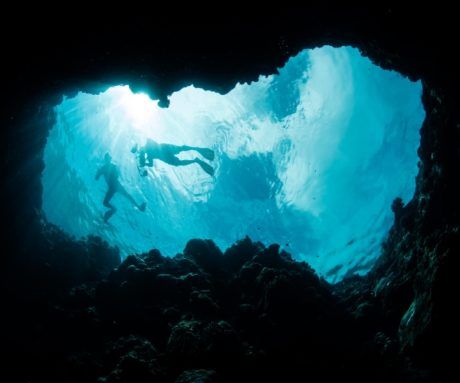
Andros specialises in producing the nation’s traditional, colourful fabric called Androsia. It is created in the Androsia Batik Factory in Fresh Creek and the island is extremely proud of this delicately handmade craft. The shades and design of the fabric are based on the beautiful Bahamian land and typically boast lush hot pinks and purples, decorated with pretty white prints. You can purchase these goods at a variety of shops and markets across the island, however if you purchase them directly from the Androsia Batik Factory, visitors can receive a free tour which is well worth doing. Another interesting craft to look out for are waterproof straw baskets which are also constructed by the locals.
Eating out means traditional Bahamian dishes, specifically the must-try land crabs that are prepared to perfection in Andros. Referred to as the ‘land of crabs’ due to the island’s harvesting success, the Bahamas National Trust have established a 4,000-acre land crab reserve in Andros to ensure populations continue to thrive while meeting demand. With great importance bestowed on this national dish, Crab Fest is celebrated annually and attracts thousands of visitors who come to the island to enjoy festivities centred around the heritage and culture of the crabbing industry together with a fabulous culinary experience.
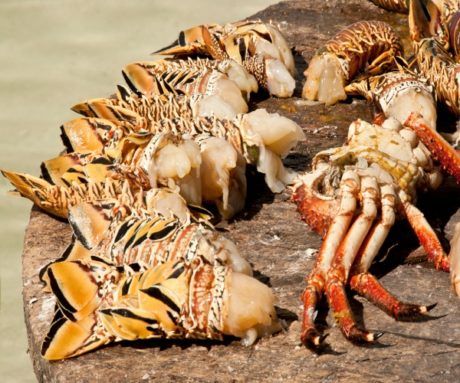
Eleuthera and Harbour Island
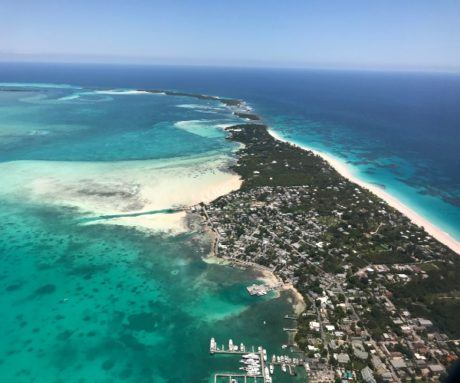
A tale of two islands, Eleuthera and Harbour Island are surrounded by clusters of gorgeous cays and sandbars. While once the capital of the Bahamas, Harbour Island is now home to a tranquil seaside town dotted with new-England-style architecture and 3 miles of stunning powdery pink sand beaches. Attracting a list of sophisticated visitors, Harbour Island has earned the title of ‘St Barts of the Bahamas’ with celebrities and fashionistas making this their chosen getaway. Known by locals as ‘Briland’, the lush palm trees and flower lined streets together with exhilarating high current dives and pink flamingos just add to the appeal. Offering small town charm set against a stunning oceanscape, take a fascinating tour around the narrow streets of Dunmore, originally created as the first capital town by Lord Dunmore in the 18th century.
In contrast, Eleuthera is a pencil thin island with 210 miles of coast. Thanks to three airports serving this rambling stretch of natural beauty, it offers a gateway for travellers to the islands beyond. Just a short sail to St George’s Cay takes you to the quiet town of Spanish Wells with the charming vibe of a New England fishing village. On the busy dockside watch resident fishermen haul in the daily catch of lobster, known locally as crawfish. Visit the Glass Window Bridge where blue fluorescent Atlantic waves roll into the opening underneath the Queen’s Highway and magically become crystal clear as they appear on the Caribbean side. Climb up the coral rocks to get a view of both sides, taking in both power and calm, plus the sporadic blowhole spout at the south end of the bridge is quite spectacular.
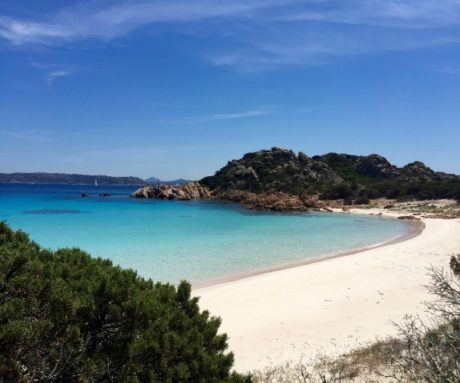
The Exumas
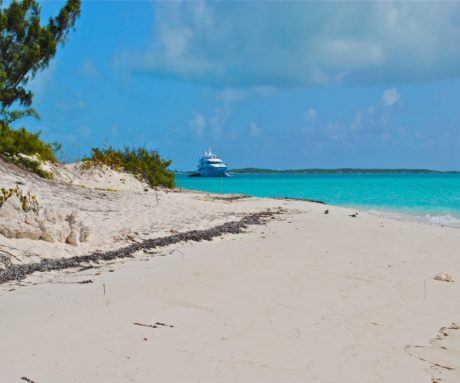
The picture-perfect Exumas are ideal for those seeking secluded tranquillity, where pristine beaches are the order of the day, and not a beach bar in sight. This is certainly not an area for anyone looking for nightlife ashore, as only a handful of bars are found within the whole 95-mile-long chain and the pace is delightfully slow. The Bahamian government has created a large National Park in the centre of the Exumas, covering 176 square miles, and so the incredible scenery above and below the water remains untouched.
A must-see is Thunderball Grotto, an underground cave where the James Bond movie ‘Thunderball’ was filmed. At high tide the entrance to the cave is underwater, but snorkel through the opening during low tide, and the cave opens up dramatically, with a myriad of light shafts entering from the roof and a welcome in the water from hundreds of colourful fish. This is a truly unparalleled experience. Another natural wonder awaits at Blow Hole Beach where an amazing phenomenon can be seen from the calm lagoon. Hidden by the limestone hills, on the other side of the island, a stream of seawater rises up created by the wave energy from a hidden blowhole.
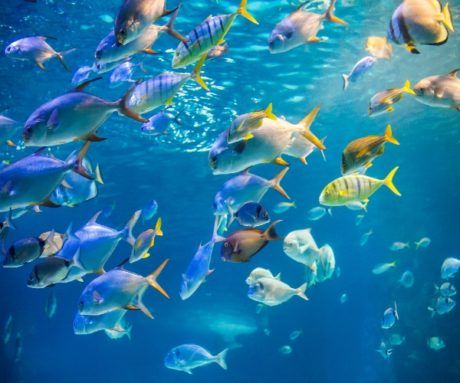
Norman Island is a gem; avoid the bustle of the main harbour and instead opt for an anchorage on the east side where the beaches are out of this world and snorkelling for sand dollars is a perfect pastime. At the southern tip of the island an airplane wreck makes for an exciting diving adventure where corals and marine life thrive. Sail to nearby Shroud Cay, home to a huge expanse of mangroves, that can be explored at high tide alongside two superb white sandy beaches that are often deserted.
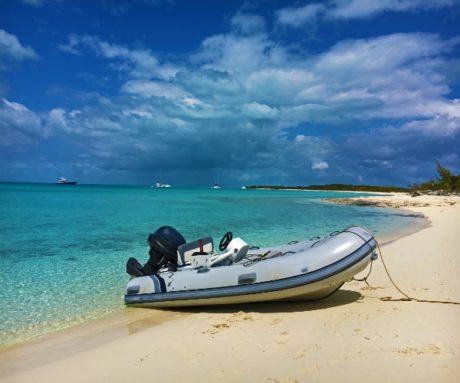
Warderick Wells Cay, home to the Exuma Land and Sea Park HQ, is an ideal place for children to chat to the onsite warden who has some fascinating stories to tell. See a real whale skeleton on the beach, enjoy the walking trails, feed local birds or launch the water sports toys from your yacht to while away the hours in the picture-perfect bay. Snorkelling along the reef here is sublime.
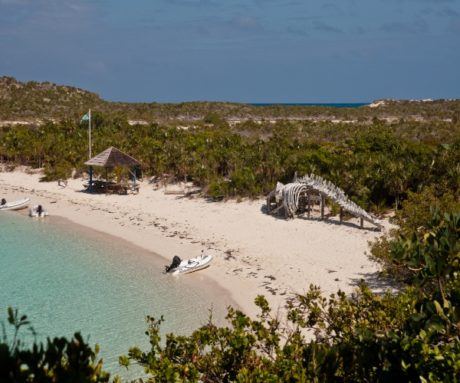
The Exumas are home to a variety of wildlife, offering the chance to get up close and personal. Pet the docile nurse sharks who swim up to the dock during high tide at Compass Cay, and make friends with the endangered and friendly Bahamian Rock Iguanas at Allen Cays. Small and narrow Stocking Island is a great spot to swim with wild, gentle stingrays and, at the aptly named Starfish Beach, you can snorkel above an abundance of colourful starfish on the sandy floor.
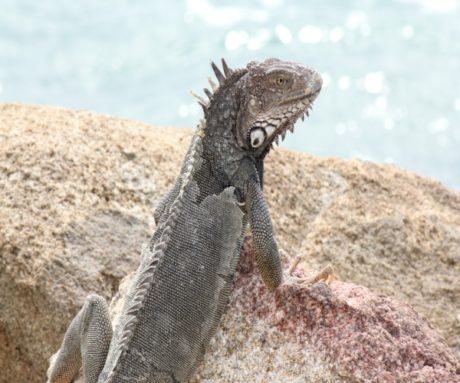
The swimming pigs at Big Major Cay have become an iconic Bahamian emblem, however it is true to say that seeing these creatures in the crystalline waters is quite a spectacle! How they arrived is still a mystery; some think sailors in the past dropped them with the intention of returning and eating them and some believe they survived a shipwreck many years ago and swam to shore. No matter their origin, the friendly pigs are now considered island inhabitants, enjoying being fed by locals and visitors whilst always seeming comfortable to pose for photos!
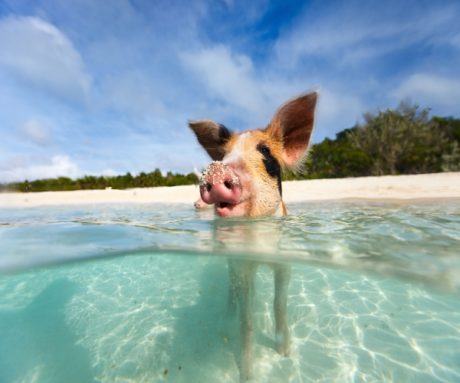
A visit to the Exumas would not be complete without a stop at the boutique resort of Staniel Cay Yacht Club, where their conch fritters, rum punch and cay lime pie are renowned. Anchor in the lee of Big Majors between Sampson Cay and Staniel Cay to soak up the scenery in paradise. The small uninhabited island at the edge of the Great Bahama Bank is Soldier Cay where you can enjoy the comfort of your own private sandbar. Take time to explore the little rock pools, snorkel one of the most beautiful coral gardens in this archipelago and then enjoy a rum punch while watching the fabulous sunset.
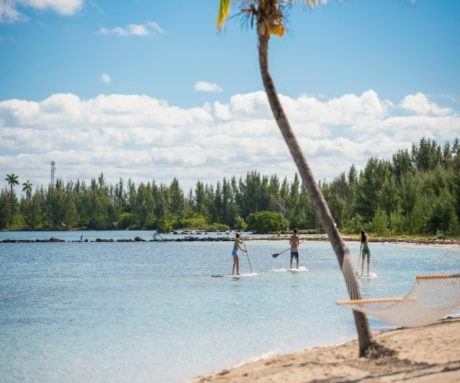
A small and tempting taste of the blissed-out experiences that can be enjoyed when on a yacht charter in the Bahamas, it is no surprise that this destination is a popular hideaway. Whether you are looking to soak up the charm of seaside towns or unwind on heavenly beaches in seclusion, the Bahamas deliver an idyllic getaway. Relaxation comes easy on board a superyacht, island-hopping amidst spectacular scenery on crystal clear water – it’s time to drop anchor and embrace island time.
By Nicholas Dean
Spooky deep sea fish washes up on California beach

A Pacific football fish, a spooky looking creature similar to that featured in the film Finding Nemo, has washed up on a beach in California.
It’s a species of anglerfish that somehow found its way from ocean depths to the shores of Newport Beach.
They are known to lurk in waters up to 3,000 ft (914m) deep.
“To see an actual anglerfish intact is very rare and it is unknown how or why the fish ended up on the shore,” the Crystal Cove State Park said.
“Their teeth, like pointed shards of glass, are transparent and their large mouth is capable of sucking up and swallowing prey the size of their own body,” it added.
Davey’s Locker Sportfishing & Whale Watching, which is based in the area, said that state park rangers and lifeguards were alerted to a “weird looking fish”.
Although the fish itself is not rare, “it is extremely rare to see one this intact along a beach” in southern California, it said in a post.
The California Department of Fish & Wildlife has taken possession of the fish.
By ankush.veer10 www.bbc.com
Alaska’s Dalton Highway Express is the world’s loneliest bus route
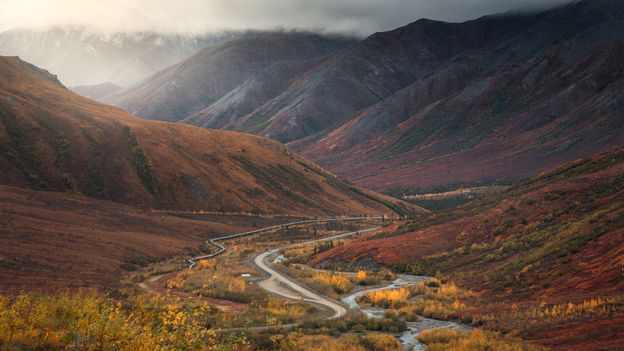
North America’s most northerly bus service, the Dalton Highway Express covers a rugged 500 miles from Fairbanks, Alaska, to the ominously named settlement of Deadhorse.
Outside the window the frigid tundra stretched away to meet the horizon; vast, treeless and unnerving. I was the sole passenger on North America’s most northerly bus service, the Dalton Highway Express, as it bumped its way along Alaska’s notorious haul road towards the ominously named settlement of Deadhorse near the Arctic Ocean. The only other traveller, a laconic Canadian, had disembarked several hours previously at a desolate truck stop called Coldfoot. Since then, the driver and I had been motoring north past the road’s last campground, its last outhouse and its last tree (a forlorn looking spruce with a “do not cut” sign). It was as if I was experiencing an extreme form of social distancing before Covid-19 made it de rigueur.
Extending 414 miles from Livengood just north of Fairbanks to the rugged Prudhoe Bay oilfield in Deadhorse, the Dalton Highway is America’s most northerly interconnecting road. It’s also, arguably, its most dangerous. Huge 18-wheel trucks hog the centre of the unpaved thoroughfare; arctic storms can reduce visibility to practically zero; and the weather can be deathly cold. In 1971, Cat Prospect Camp just south of Coldfoot recorded the US’ lowest-ever temperature, a bone-chilling -80F (-62C).
The Trans-Alaska pipeline is one of the only constants along the 414-mile Dalton Highway (Credit: Piriya Photography/Getty Images)The Dalton Highway was built in 1974 to serve the Prudhoe Bay oil patch, Alaska’s economic lifeblood and supplier of nearly 85% of the state’s budget. In its early days, it was purely a haul road for trucks. Then, in 1994, the state opened the highway to private vehicles. With 100,000lb juggernauts thundering full throttle over loose gravel, don’t expect an easy ride.
“Driving the Dalton Highway can be extreme in summer or winter,” said John Rapphahn, park ranger and manager of the Arctic Interagency Visitor Center in Coldfoot. “In summer, trucks throw up dust and muddy roads can make surfaces slippery. Winter brings icy conditions and avalanches. With only about one quarter of the road paved, motorists should be prepared for a flat tyre or two.”
Breakdowns can be costly. “I once found a couple stuck in a ditch in the wintertime at -30F,” recounted Rapphahn. “I couldn’t get their vehicle out, so I gave them a ride to Yukon River Camp where they called for a tow truck. It cost them around $1,200.”
If you’re driving, he recommends equipping yourself with a radio. “It’s worth investing in a handheld CB tuned to Channel 19. In this way, approaching truckers and pilot cars can notify you of an oversize load when they see you on the road. You will also have the added benefit of being able to communicate with other vehicles if a problem occurs.”
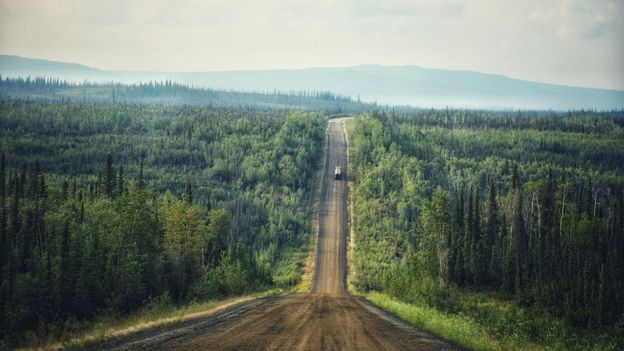
The Dalton Highway was built in 1974 as a haul road for trucks (Credit: Elena Pavlichenko/Getty Images)
Lacking a car or radio, I needed help to reach Deadhorse via terra firma and fulfil my ambition of crossing the Arctic Circle by land. Hitching a lift with a truck wasn’t an option as commercial trucks are prohibited from taking hitchhikers on the Dalton for liability reasons. Instead, I booked a ticket with America’s unlikeliest bus service.
The Dalton Highway Express was launched more than 20 years ago to meet a small but growing demand for ground transportation on the road.
“Our guests come from all over, although the majority are US travellers,” explained the company’s marketing coordinator, Kathy Hedges. “Some are looking for low-cost transportation to get to or from Deadhorse on a scenic route; others are trying to get to a good starting point to hike into the Gates of the Arctic National Park or take a canoe out at the Yukon River bridge. A growing number of travellers are biking one way and looking for a ride in the other direction.”
Between the beginning of June and the end of August, the company runs a twice-weekly return service between Fairbanks and Deadhorse covering a rugged 500 miles in just 16 hours.
Short on time but intrigued to experience what promised to be one of the world’s most surreal bus rides, I booked the Express one-way to Deadhorse with the intention of flying back. I chose 21 June as my departure date. With 24-hour daylight north of the Arctic Circle, I wanted to witness the ethereal midnight sun.
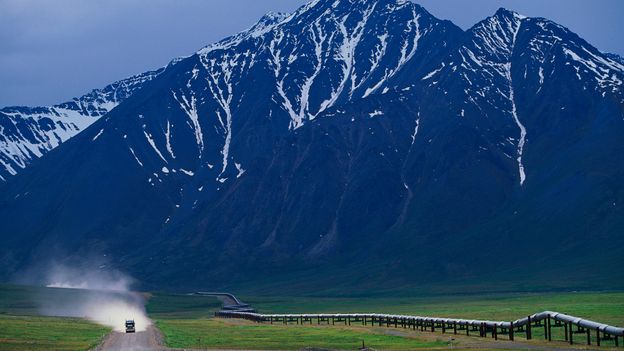
The Brooks Range looms over sections of the loose-gravel highway (Credit: Paul A Souders/Getty Images)
With little in the way of settlements along the road’s course, the Dalton Highway Express doesn’t operate a spontaneous request-stop service. You book in advance and arrange your itinerary. Some people like to camp overnight and reboard the bus on its return leg; others plan ambitious hiking excursions with survival gear across Alaska’s trail-less wilderness.
“We like to think we are a service people can rely on,” said Hedges, “If customers get dropped off on one day and make a reservation to be picked up, they can count on us being there for them.”
Reliability is essential. The Dalton is an intensely lonely road. There are no medical services, little mobile-phone coverage and only two pinprick settlements en route: Coldfoot (population: 10) and the subsistence hunting community of Wiseman (population: 14).
With the bus, I felt in safe hands. The company’s drivers are experienced and subject to professional in-house training. “Usually, people get into trouble on the highway either because their vehicle isn’t meant to go on gravel roads or they themselves are not prepared,” Hedges revealed. “They go too fast for the conditions or make poor turning and lane placement decisions.
Leaving Fairbanks promptly at 06:00, our durable Ford Econoline van motored past spindly spruce and paper birch trees to the start of the road proper at Livengood. With just myself and the Canadian on board, there was plenty of space. Eight hours later, after crossing the mighty Yukon River and the Arctic Circle, we grabbed a quick lunch at the Trucker’s Café in Coldfoot, the last refreshments for 240 miles and the disembarkation point for my fellow passenger.
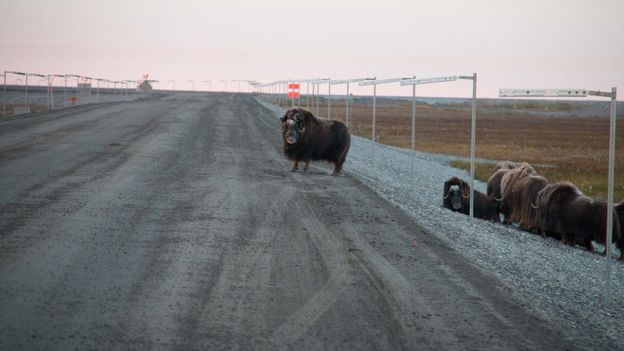
Musk oxen, as well as moose, wolves, caribou and bears, live along the Dalton Highway (Credit: bsrieth/Getty Images)
Beyond Coldfoot, the Dalton climbed the remote Brooks Range before summiting the 4,739ft Atigun Pass and descending onto the eerie North Slope, one of the most isolated stretches of road on Earth. The scenery – vast intact ecosystems barely touched by humans – was unlike anything I’d ever seen. Cleaver-shaped mountains were slowly replaced by a barren tundra of shallow lakes, frost mounds and ice-wedge polygons sculpted by the extreme arctic weather. As a visitor from lower latitudes, I felt as if I was transiting a strange new universe. Even the bus driver seemed to be silently awe-struck as he skilfully negotiated the steep grades and sharp curves.
“What isn’t a highlight on the Dalton Highway?” Hedges agreed, acknowledging the road’s unique allure, even to hardened regulars. “Travelling it even once a week, our drivers notice the differences. It seems overnight to make changes. It is amazing what 24-hour daylight will do for the vegetation.”
In the south, aspen, birch and spruce trees are interspersed with cottongrass and sedge meadows. Further north, the flat monotony of the tundra is broken by willow shrubs, reindeer lichen, pink lousewort and blue anemone. The wildlife is legion and varied. Moose, lynx, beavers, wolves and grizzly bears inhabit the boreal and mountain regions, while on the bleak North Slope, musk oxen and caribou can be seen by the herd. Ironically, my most memorable “wildlife” encounter happened when we made an obligatory photo stop at the Arctic Circle and a swarm of mosquitos literally ate me for lunch.
The only constant on the road is the Trans-Alaska pipeline. Carried above ground in these high northern latitudes due to permafrost, the pipeline pumps out nearly 500,000 barrels of oil a day. As we approached Deadhorse, with 500 miles of empty tundra stretching out on either side of the road, it was one of the few visible features, aside from pingos (ice-cored hills) and musk oxen.
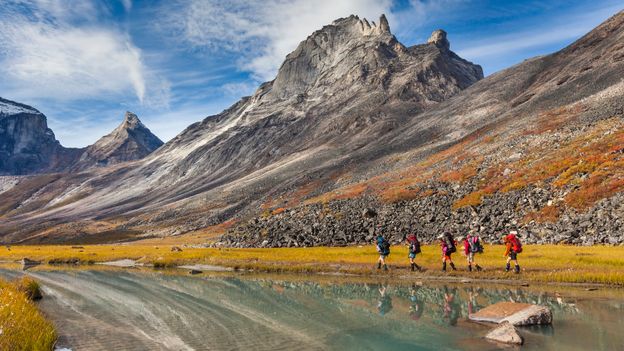
Some Dalton Express passengers come to hike Gates of the Arctic National Park (Credit: Patrick J Endres/Getty Images)
Even though I’d played no role in driving or navigation, reaching Deadhorse after 16 hours of loose stones and half-frozen mud felt like crossing the finish line at the Dakar Rally. I wanted to give the driver a trophy as well as a tip.
Huddled eight miles south of the Arctic Ocean, the drab, utilitarian Prudhoe Bay oil-camp resembled a dystopian movie set. With brutal winds whipping across the coastal plains, getting here was more about the journey than the destination.
I’d prebooked a room in the Prudhoe Bay Hotel, an industrial work-camp with 24/7 canteen food, a ban on booze and a sign on the door that read, “Everyone must take their boots off”. Full of ruddy-faced oil-workers counting the days to their next vacation (and drink), this was an integral part of the Dalton Highway experience.
After a celebratory sandwich, I stepped outside for a night-time walk. It was midnight and still light. Across a lake, half-hidden behind low clouds, the midnight sun did its best to emit a weak, paltry radiance. I had reached the top of the continent, the last stop on the line for the Dalton’s only means of scheduled land transport. For one day at least, I could enjoy the unique honour of being the most northerly bus passenger in the Americas.

The North Slope is one of the most isolated stretches of highway on Earth (Credit: Gerhard Kraus/Getty Images)
By Brendan Sainsbury www.bbc.com
San Diego has a rich heritage and culture with a vibrant history
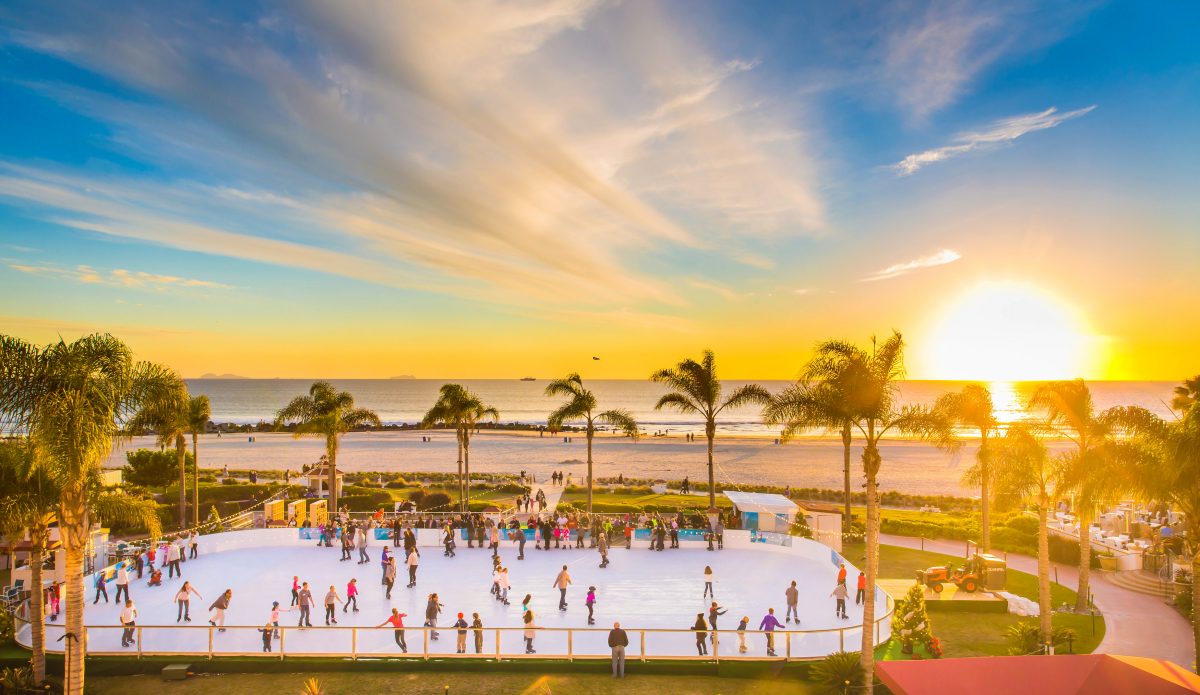
San Diego is a city rich in heritage and culture with a vibrant history that’s largely unknown to the masses. Most commonly recognized for its sandy beaches and wealth of entertainment options such as Sea World and the world-renowned San Diego Zoo, the area was instrumental in forming the early foundation for the state of California.
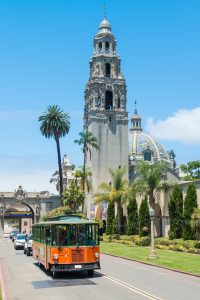
Originally discovered by Spanish explorer Juan Rodriquez Cabrillo in 1542, San Diego Bay still plays a significant role in both the archeological history and ecological sustainability of the western United States. The coastal town is home to Cabrillo National Monument, the historic Gaslamp Quarter, and Old Town State Park, the latter of which is often credited as the birthplace of California. The area also encompasses dozens of museums and historical sites (including 17 in Balboa Park alone), and San Diego’s colorful origins can be seen from a variety of unique vantage points that enhance the area’s standing as a top travel destination for the discerning adventurer.
The sunny seaside city boasts a number of other important cultural landmarks, including everything from several of the state’s twenty-one Spanish missions that date back as far as the 1700’s, to the cozy mountain community of Julian, known for its vast apple orchards, which once served as a popular stagecoach stop and gold mining destination.
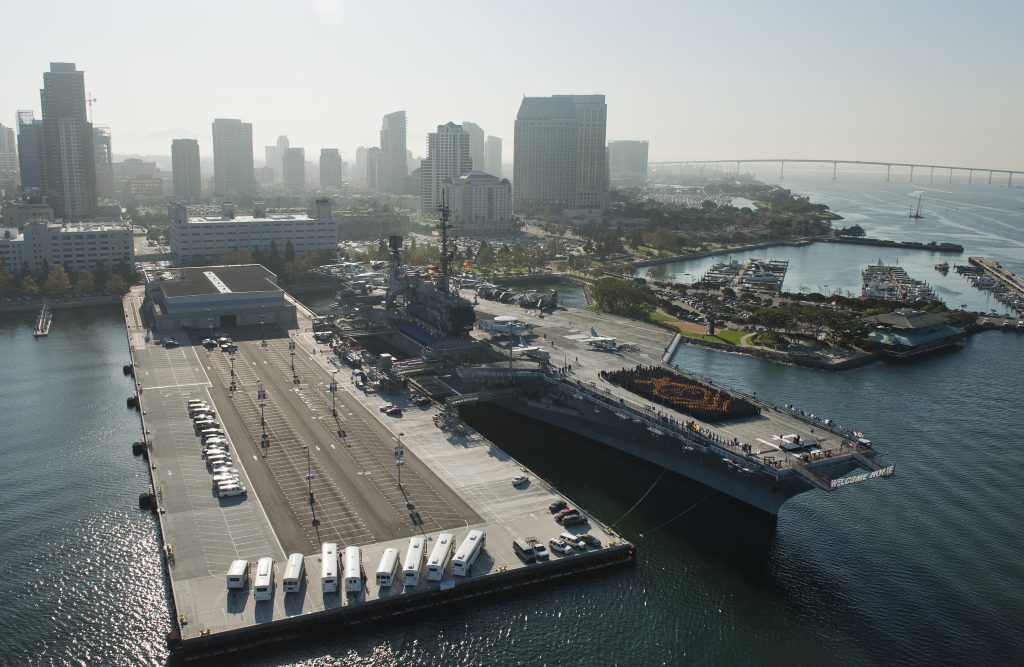
For an unprecedented look at the U.S. military’s essential role in the history of San Diego, look no further than USS Midway Museum which offers guests a chance to experience what life was like for the more than 200,000 sailors who called the aircraft carrier home. Or, if aviation is more up your alley (being a Jetset reader and all), be sure to check out the Flying Leatherneck Aviation Museum which features more than thirty historic aircraft ranging from World War II to the present day. The museum’s close proximity to both San Diego’s Marine Corps Air Station and Coronado Island’s Naval Air Station might even offer a glimpse of one of today’s most advanced modern-day aircraft as jets can often be seen flying overhead during regular training exercises.
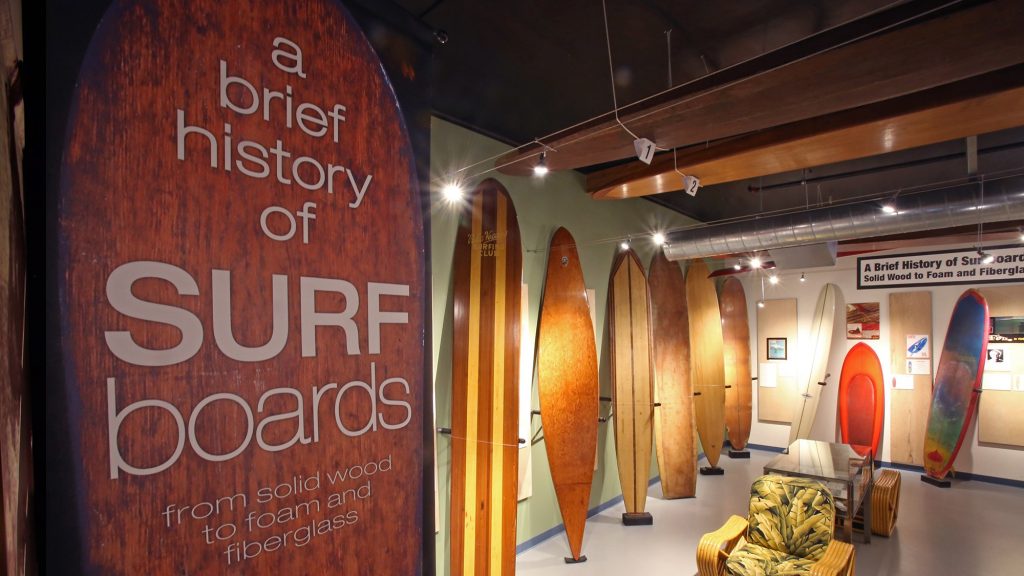
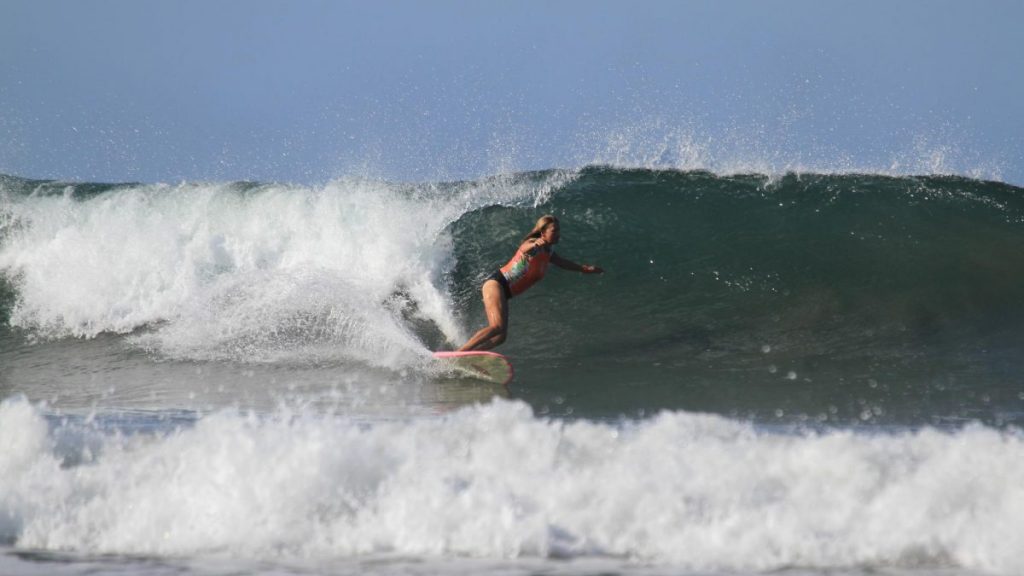
For the sports enthusiast, San Diego offers a number of watersport activities such as paddle boarding, kayaking, and of course a number of popular surfing options. Just a quick drive up the coast from the city, the California Surf Museum in Oceanside gives visitors the opportunity to learn more about the history of surfing in SoCal and how the ever-growing fascination with the sport continues to shape the local California culture and lifestyle.
If swinging a club is more your cup of “tee,” look no further than the top-tier Torrey Pines Golf Course located in the beautiful town of La Jolla. The property is the home of two iconic 18-hole courses (North and South) and provides impressive views of the Pacific Ocean and neighboring area. Unbeknownst to most, Torrey Pines was named after the rare tree by the same name which grows in only a few places on earth and is indigenous to the San Diego County area to this day. The course also hosts the PGA Tour’s Farmers Insurance Open and appears on nearly every aspiring pro golfer’s bucket list.
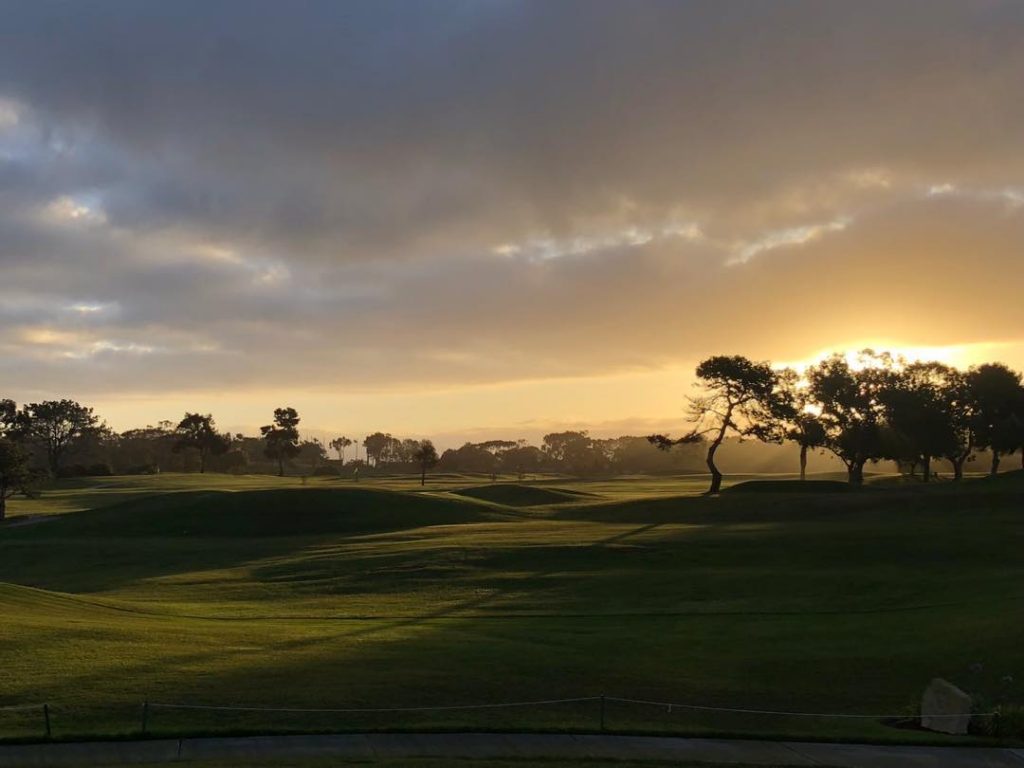
Finally, while dining options in the area are certainly abundant, no visit to San Diego would be complete without a visit to the renowned Marine Room. Regularly patronized by a plethora of celebrities, athletes, and high-profile public figures, the Marine Room has been a staple in the San Diego area for more than 75 years, thanks in part to its stunning panoramic views of the ocean landscape and its highly-touted gourmet cuisine. Diners at this famed eatery can often be found enjoying the scenic display of cascading surf from nearly any seat in the restaurant. Whether sitting window-side or in one of the establishment’s elevated booths, the views of the nearby shoreline are so close that guests feel practically within arm’s reach of the approaching water, a feeling that’s further intensified during high tide.
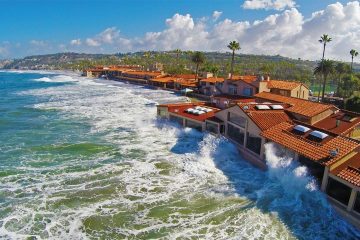
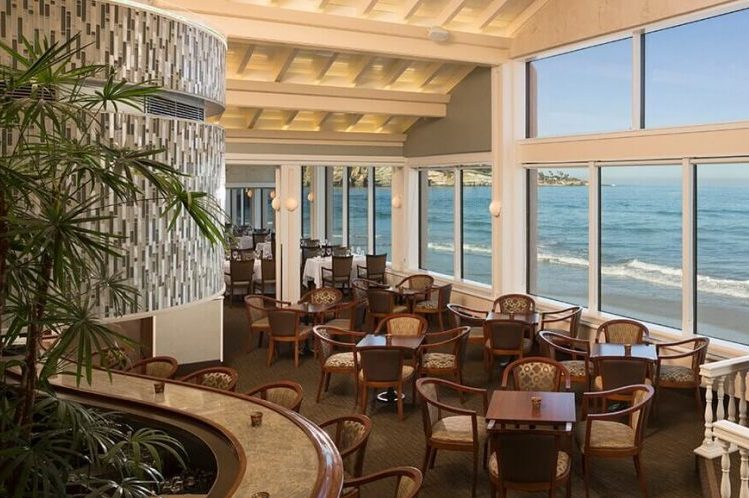
No matter how you choose to spend your time in this emblematic seaside escape, one thing is certain: your time in sunny San Diego will leave you yearning for more, with an undeniable longing to return to this one-of-a-kind coastal paradise.
By David Haraldsen
Experiences not to miss in Rio de Janeiro

Ask any global explorer what the world’s sexiest city is and the likelihood is that Rio de Janeiro is near the top of the list. Its radiant beaches are a social gathering of all classes drawing in visiting sun-worshipers who ascend upon Cidade Maravilhosa, aptly named Marvelous City. The locals are known as cariocas which is also synonymous with all things Rio.
The cities pulse begins on its golden sand beaches. Rio oozes a sexy vibe dating back to the 1960s when bossa nova artists Tom Jobim and Vinicius de Moraes introduced the world to the alluring “Girl from Ipanema.” Hardly a single day passes when beachcombers are not forming a volleyball game or gathering a group for a football match. While surfers ride neatly formed swells, or others glide along the promenade by bike, stopping off at the small food shacks to grab a bite or drink while soaking in the assembly of all humanity is the liberated seafront metropolis.
Music is Rio’s vital spark. Amid all of the cacophony of sounds of its vibrant music scene, from old-schoolbossa nova to hip hop and rock to immerse into the marvellous city and discover the city’s pulse, one must unite with the seductive African-influenced quick-fire Samba dancing.
Rio knows how to party like no other city on the planet. Its music-buzz and joie de vivre leads to the world’s largest outdoor party held each year before lent the all-inclusive Rio Carnival; the city embraces all takers who grace its presence. As in all of Rio, football (soccer) looms large into the cultural landscape.
The cosmopolitan metropolis boasts the world’s largest urban jungle. The Tijuca Forest covers over 12 miles of tropical rainforest. Within the cinematic backdrop’s lush confines lies the cities crown jewel Corcovado (Christ the Redemer), a statue perched high above Rio with sweeping Sugarloaf Mountain views radiant beaches and tiny dotted islands off the coastline.
Don’t miss these highlights of Rio de Janeiro.
Rio by Bike
I’m fond of mentioning that the best way to see a city is by bicycle, and Rio de Janeiro is an easy to maneuver urban area. Having a bike to ride around town gives you the flexibility to explore off the beaten areas and sets up serendipitous encounters with locals and new venues that you probably might have missed. You’ll find Tembici bike stations scattered throughout Rio where you can grab a bike or drop one-off.
If you prefer to ride on a guided tour with experts and fellow enthusiasts, Rio by bike offers three-hour rides along the beaches to a seven-hour time that showcases most of the Carioca city’s highlights. Along the routes, there are plenty of excellent vantage points for photos.
See www.riobybike.com for more details.
Free walking tour of downtown Rio and Lapa

Walking tours are a stellar way to get acquainted with your new surroundings and tips on other things to do in a city. Take a step back in time, discovering Rio’s cultural city centre downtown and colonial Lapa district. Led by passionate storytellers, you’ll experience its fascinating history along with Brazilian culture brought to life through the eyes of a local.
After you’ve completed the downtown sights, you’ll visit Rio’s most dynamic neighbourhood with its bohemian feel. The highlight being the Selaron Stairs and painted murals. The steps 200 steps contain ceramic tiles sent to Rio from 60 countries around the world.
Best of all, this is a free walking tour with no set price. Each participant pays the value that they deem the tour to be worth or what they can afford.
See www.freewalkingtours.com for more details.
Hiking and adventure tours
Rio is a city within a tropical rainforest and one of the world’s most spellbinding urban landscapes. See nature up close. The Tijuca forested hills of Rio are a must-visit to the Carioca city. Climbing near Rio’s grand dame, Corcovado, is an unforgettable experience. Since 1999, the adventure travel company Rio Hiking offers has been offering multi-day hiking, backpacking, and private tours in and around the city.
Beyond hiking, the company adds adventure to any trip to Rio, specializing in multi-sport outdoor activities, including biking, ocean kayaking, surfing, scuba diving, hang-gliding, rafting, and cultural attractions. We operate in the city of Rio and nearby destinations: Ilha Grande, Paraty, Serra dos Órgãos, Bocaina, Itatiaia, Buzios, Arraial do Cabo, Minas Gerais and othe National and State Parks. Purposeful tours, creating unforgettable connections with nature, local people, and culture.
See www.riohiking.com.br for more details.
Carnival Experience (behind the scenes)
What is linked more to Rio more than Carnival? Suppose you miss immersing with the crowds of two million revelers per day, walking and partying in the streets, and entering the Sambadrome. In that case, you can take a glimpse behind the scenes of the biggest show on earth by spending an afternoon with the passionate Carnival and Samba school authority at Carnival Experience.
Preparation for Rio’s main event is an arduous task, including thousands of people behind the scenes beginning up to a year in advance. You’ll delve right into the creation of floats, costumes, dance troops, musicians, and choreographers. You’ll be fitted and dress in costume for the ultimate photoshoot at the end of the tour.
See www.canivalexperience.com for more details.
Cooking in Rio (prepare a meal with a local chef)
Learn the intricacies of the Brazilian kitchen with passionate, joyful, and witty star-chef Simone Almeida. Begin your culinary journey with a quintessential sugar cane Caipirinha cocktail. You’ll feel right at home assisting Chef Almeida, preparing Brazilian culinary comforting meals in small groups in the cozy Copacobana kitchen created for intimate guest gatherings.
Taking the trip upon arrival or early in your holiday allows you to delve into Carioca culture with a greater understanding of the melting pot of cultures in this incredible seaside metropolis. Simone’s passion for her environment is a highlight of any trip to Rio. You enter the class with a group of strangers before the cooking course, and as the lesson culminates, you’ll depart, having made friends for life.
See www.cookinginrio.com for more details.
Discover Urca and Sugarloaf Mountain
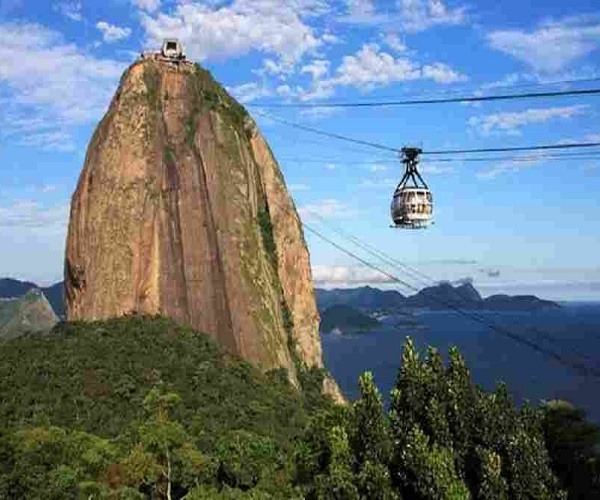
Escape the fast pace of Rio for a tranquil visit to Rio’s founding neighborhood. On the hump of Pao de Azucar or Sugarloaf Mountain is Rio’s oldest settlement of Urca. The community consists of less than 20 streets and is amidst sweeping Guanabara Bay.
Urban Adventures offers a four-hour journey that included a taste of Rio’s famous empadinhas (savory and sweet stuffed turnovers) and quench your thirst with a cold beer while blending into Carioca-life at “mureta da Urca.”
From the base of Urca, Praia Vermelha on the fast-moving cable car is making the stratospheric ascent from the bottom of the Urca Sugarloaf summit. The mesmerizing far-reaching views from the top of the rock engulfs Guanabara Bay, Copacabana, and downtown Rio. Savor Embrace the laid-back Carioca lifestyle.
See www.urbanadventures.com for more details.
Corcovado by train and the Maracana stadium

Take a four tour of two of Rio’s unmissable attractions Corcovado, Christ the Redeemer statue hovering over the city, in the dense Tijuca National Park. The group tour begins at the cogwheel railway for a stairway to heaven journey through the thick forest. Upon reaching the summit, you’ll be mesmerized by the 2,329 feet (710-meter) granite giant statue of Jesus.
Later the tour heads back downtown to one of the most famous stadiums in the world. Passionate futebol fanatics know that soccer is a way of life in Brazil, and in the Marvelous City, matches are held at its crown jewel Maracana Stadium. You’ll receive a behind-the-scenes glance of where some of the world’s greatest matches transpired. You’ll sit on the team bench imagining Pele’s 1,000th career goal and World Cup moments.
See www.aventuradobrazil.com for more details.
Visit Rio’s favelas
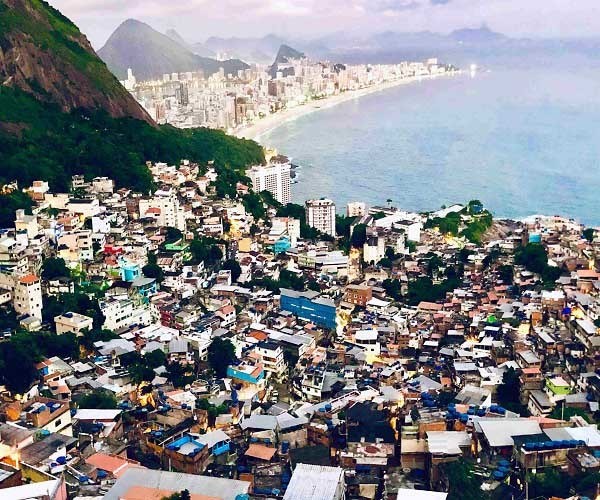
To immerse Rio’s heart and soul, one must visit Rio’s low-income shantytowns located high above the city in the mountains known as favelas. The colourful buildings are a patchwork of the cities low-income communities. The hillside communities date back to the 19th century, occupied by fugitives and later slaves who were set free. Rocinha Favela is the largest in Latin America.
While many times affiliated with the drug trade and violence, nearly a quarter of Rio’s inhabitants live in favelas. Samba, Rio’s native dance, is a product of the favela lifestyle. Favelas come with a wealth of art and culture. Contrary to the myths created by the media, favelas are not constant warzones, and the proper guidance is an essential glimpse into understanding economic and political factors.
See www.nowinrio.com for more details.
Soar high above Rio on a tandem hang glider
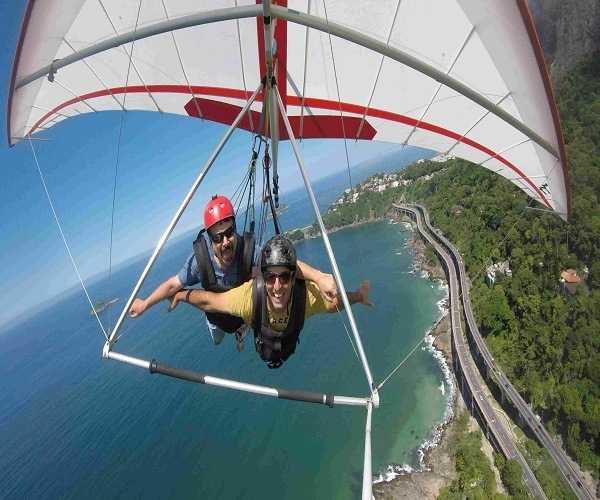
Rio is one of the top destinations for adventure sports. If your a thrill seeker and hang gliding have eluded you but remains high on your adrenaline bucket list, few backdrops are as astonishing as Rio’s verdant mountain cliffs. On the southside of Sao Conrado Beach, you can’t miss the soaring pterodactyl-like giant gliders who gracefully land in the golden sand.
As Fabio, my instructor, mentioned, almost anyone can tandem hang glide. There is no unique skill set involved. You have to be able to run about 20 feet off the mountain then settle in as your instructor takes over. Wind determines the length of the flight, but 10 to 20 minutes is the average time. The journey begins as you soar over rainforest-clad mountains. Photographers meet you at the beach landing, flight school office hut on Sao Conrado to preserve a most likely once-in-a-lifetime experience in photos.
See www.rioasadelta.com.br for more details.
Stay on a plantation farm (fazendas)
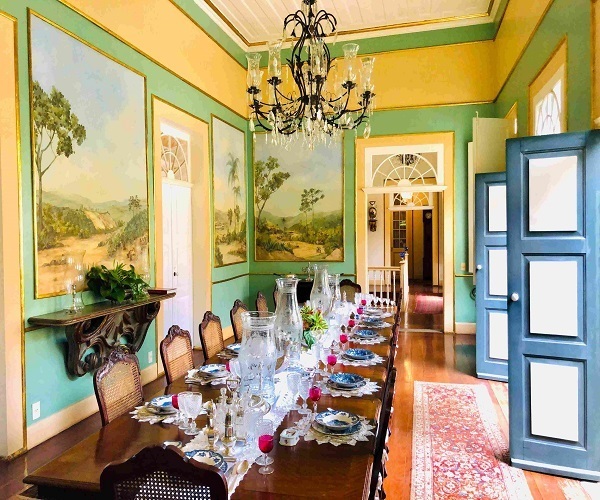
A bit of a stretch from the big city, but well worth the visit. The Vale do Cafe is an agri-tourism region located three hours north of the Rio city centre, most noted for its wealthy restored plantation houses known as fazendas. You can book a room in a handful of grand farmsteads, which date back to the colonial period of the 18th and 19th centuries—the decorated estates akin to the American south showcase an era when coffee and sugar cane fields were the main crops.
Sao Luiz de Boa Sorte and Fazenda Las Palmas are two of the fazendas where guests can spend the night. Most include breakfast, and some also serve dinner. These renovated manor houses are a step back in time and mix styles of stately decor—an educational journey into the lives of the Portuguese aristocrats who settled on these massive homesteads.
See www.valedocafeturismo.br for more details.
By Nick Kontis
A luxurious weekend getaway in Muskoka Lakes, Ontario, Canada

I think we can all agree that we have been faced with many challenges in the year 2020, and that travelling plans have been affected tremendously. As residents of Niagara Falls Canada, my husband and I have had to limit our travel and in order to cure the “travel bug” within us we have decided to stay in province and take a few little mini-vacations within a few hours drive from home.
One of these mini-vacations took us to the Muskoka Lakes Region of Ontario, Canada; a very popular tourist destination most especially in the summer months but we ventured out in late November.
The Muskoka Lakes Region is a chain of lakes, Muskoka District, in southeastern Ontario, Canada. They are located about 130 km north of the city of Toronto. They consist of a chain of freshwater lakes drained by the Muskoka River into Georgian Bay, and these lakes are simply stunning; surrounded by beautiful trees and rocks of the Canadian Shield it offers some of the most picturesque views of Ontario.
Located on one of these beautiful lakes, Lake Rosseau to be exact; is a beautiful luxury resort and spa, and this is where my husband and I decided we would stay. The name of the resort is JW Marriott The Rosseau Muskoka Resort & Spa, and I am delighted to tell you that it is absolutely beautiful.
We decided that we would leave on a Friday morning and that on our way to the resort we would stop and tour a Cranberry Farm and do some wine tasting at Muskoka Lakes Farm & Winery. I personally had never heard of a cranberry farm in Ontario and the idea was fascinating; I was looking forward to experiencing the tour. When we arrived we parked and made our way to the winery building to check in for our tour. Looking around we could already see the red colours surrounding us in the bogs, and we were excited to learn more about this unique place.

We waited for a few minutes and then one of the ladies came out to take us on our tour of the farm. We learned that it was a family business and that they had been growing cranberries for three generations in Muskoka. As Ontario’s oldest cranberry farm, they believe great fruit starts with caring about the environment that supports it and farming responsibly is very important to them. As we proceeded along the walking tour we were told more about the farm and the cranberry growing process, we learned that they grow Vaccinium macrocarpon cranberries; the only cranberry native to North America. There are over 150 commercial varieties of Vaccinium macrocarpon, and on this farm they grow five different varieties. We had no idea there were so many varieties of cranberries and found all the information we were given to be fascinating.
When the tour was completed we headed back to the winery and were welcomed into the tasting room in order to complete our wine tasting experience.
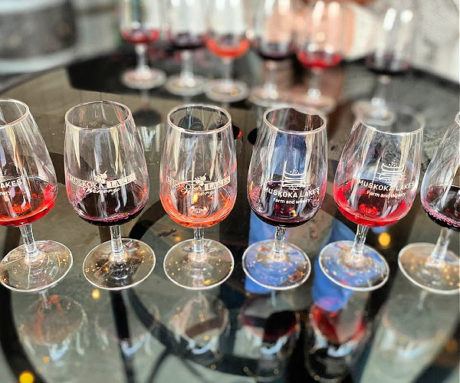
The verdict on the wine? Delicious! We had no idea that cranberries could make such a lovely tasting wine; they have several varieties ranging from dry to sweet, and they even make a cider. We did learn that the cranberries were often mixed with other ingredients in order to acquire a pleasant taste, and our favourite one was the Cranberry/Blueberry Blend. I highly recommend you visit this beautiful farm and winery if you have the opportunity to do so!
As it was now late afternoon it was time to make our way to the resort to settle in; it was a fairly mild day for November, the temperature was around 12C so we decided to take a walk around the grounds of the resort and found it to be very appealing. The view of the lake was stunning, they had an outdoor pool and hot tub, an indoor/outdoor pool, a beach for summer and it appeared there were lots of outdoor activities available at any season of the year. One of our favourite features of the hotel were the outdoor firepits, several were located on property complete with lovely Muskoka chairs where you could sit by the fire and get cozy.
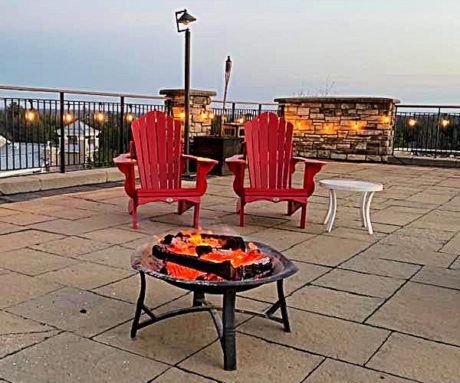
Inside the resort was also very beautiful, there were several cozy seating areas with fireplaces, a bar where you could obtain a cocktail and a very large seating area that also appeared to serve light fare.
We sat and enjoyed a lovely pre-dinner cocktail in the beautiful seating area and when it was time we made our way to the restaurant for our dinner reservation. There were 2 fine dining choices at the resort and we had chosen the Muskoka Chophouse. I have only good things to say about this restaurant, even during a pandemic it appeared they were taking the appropriate precautions to keep everyone safe, they had a wonderful wine menu to accompany the delicious dinner options and we thoroughly enjoyed our dinner.

We settled in for the evening in our room which also had a lovely fireplace and a view of beautiful Lake Rosseau.
The next day we decided to do some exploring; there are several quaint small towns in this area of the Muskoka Lakes, we decided to go for a drive and see Bala and Port Carling. One of my favourite things to see in this area is so much evidence of the Canadian Shield, and in Bala Ontario there are some beautiful waterfall formations to see together with the rock from the Canadian Shield. If you are unfamiliar with what the Canadian Shield is, it is a “large area of exposed Precambrian igneous and high-grade metamorphic rocks that forms the ancient geologic core of the North American continent” according to Wikipedia.
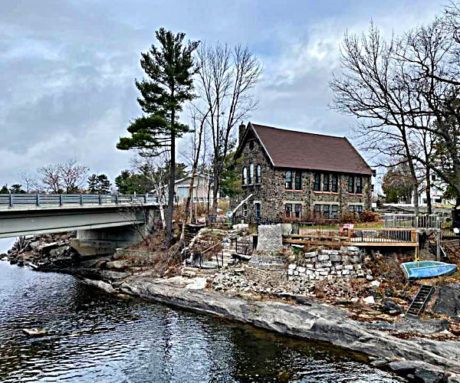
Next we headed to Port Carling, we had lunch at a lovely little restaurant called Portside Fusion. I recommend this as a lunch stop, we enjoyed the quaintness and the food was lovely as well. Port Carling is a very small community, and I think my favourite thing about it is the little shops and beautiful water areas. One of the ones we found particularly pretty was Mirror Lake, which even in late November cold still looked absolutely beautiful!
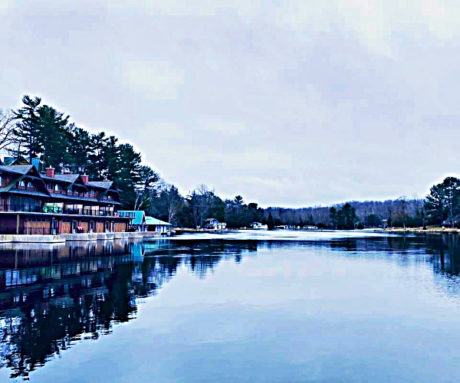
After enjoying a lovely day in the area and exploring the local shops, we headed back to the resort to relax and unwind; we decided on a late dinner in our room with a bottle of wine to toast to our wonderful weekend away. The next morning we headed back home but we will certainly be back again.
By Lisa Mallett
Wonderful Greek islands to visit this summer
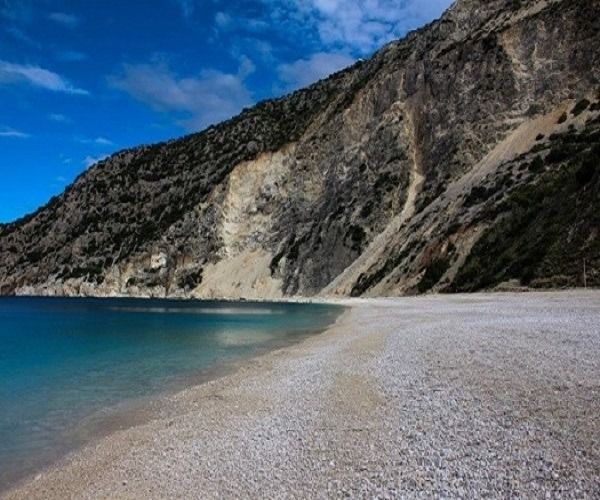
Now that summer travel is approaching, here are five Greek Islands to vacation to when it is safe to flock to Greece.
Kefalonia
Unblemished Kefalonia is Greece’s fifth-largest island. Until the mid-nineties, it remained concealed in the lesser-traveled Ionian Sea. It became romanticized in 1994 novel by Britsh author Louis de Bernieres – Captain Corelli’s Mandolin, about Italian soldiers invading Greece during the second world war—later showcased in the silver screen adaptation starring Nicolas Cage and Penelope Cruz.
Its seaside mesmerizes travelers. Its crown-jewel beach is the turquoise- aquamarine-colored waters of Myrtos regularly lauded as a top 10 beach in the world. The seductive stretch of sand flanked by high limestone walls shimmers as the sun radiates off its translucent waters.
Cave excavators marvel at Melissani Cave and lake combining freshwater and sea-water. It’s two caves in one. While one remains lit by the sun, the other darkened, mysterious, and covered in stalagmites. During mid-day, when the sun shines directly above, letting direct light creates a glowing illusion in its turquoise waters.
Picturesque harbor front villages of Fiscardo, Assos with its Venetian Castle of Agios Georgios, and Sami overlook quaint fishing trolleys and lined with seaside dining captivate all who delve to Greece’s less-traveled Ionian islands.
Despite the bustle of summer sojourners, the lush and mountain island is plenty big for exploration. The best way to traverse the varied island is by renting a car in the vibrant capital of Argostoli Town.
No boats depart from the Athens port of Piraeus. Most visitors to the island arrive by daily ferries from the Peloponnese city of Patras to the port of Poros. Ferries connect neighboring Ionian islands of Zakynthos, Ithaca, Killini, and Lefkada to Kefalonia. In the summertime, ships also operate from Brindisi in Italy. Its international airport accommodates daily flights from Athens and charter flights from European capitals.
Kimolos
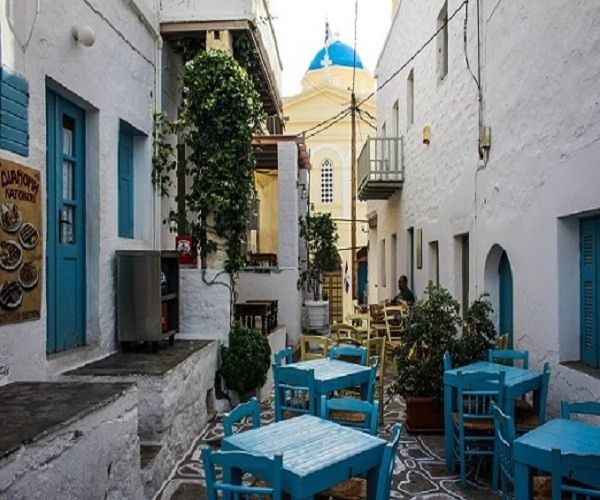
The allure of Kimolos Island is that time appears to be frozen. It feels like Kimolians live like the way the Cyclades were 30 years ago. Although a stone’s throw from much grander Milos, few vacationers escape to the road less traveled island. Today, the snail-pace land remains one of the Aegean’s most undiscovered treasures.
Kimolos is the polar opposite of raucous Mykonos or the hordes of caldera gawking tourists who swarm upon overrun Santorini. Greek Island-hoppers come to this lovely island sanctuary to immerse with locals whose genuine-quaint hospitality is apparent from the moment you depart the ferry at the port of Psathi. There are at least 15 lovely beaches to bathe some sounded by sequestered coves. See local life in picturesque fishing villages, where tiny boats dot the bay, while time-honored locals discuss the days catch.
Getting too far away or lost is not an option. All roads eventually lead back to the one village and capital of Chorio, pronounced “Horio” and the Kastro or Castle, a fortress within the confines of the island’s enclave.
Yet, the island of 38 Kilometers (around 23 miles to circumnavigate the tiny island), holds impressive peaks and valleys perfect for hiking.
There are enough beaches to suit all tastes. Another highlight is the Gerakias cave. Dive into the sparkling waters, and walk its shallow waters inside the cave.
For the perfect ending to any day on Kimolos Island, take a drive to Ellinika Beach for its impressive sunsets, and marvel at the spellbinding rock formations straight out at the sea of Aspragremna there are remains and wreckages of the ancient city of Kimolos as well as the ancient tombs. Hike to Skiadi rock, a peculiar boulder shaped in the form of a giant mushroom.
Kimolos, located in the southwest Cyclades chain of stellar islands, is around 90 miles due south of Athens. Boats leave from Athens port of Piraeus for the longer 7-8 hour journey as the ferries stop along the way at other islands. The 20-minute short crossing from Milos operates 5-7 times per day. Besides service from Milos, well-traveled islands of Kythnos, Serifos, and Sifnos. As Milos has an airport, you can fly into Milos and catch the launch over to Kimolos.
Milos
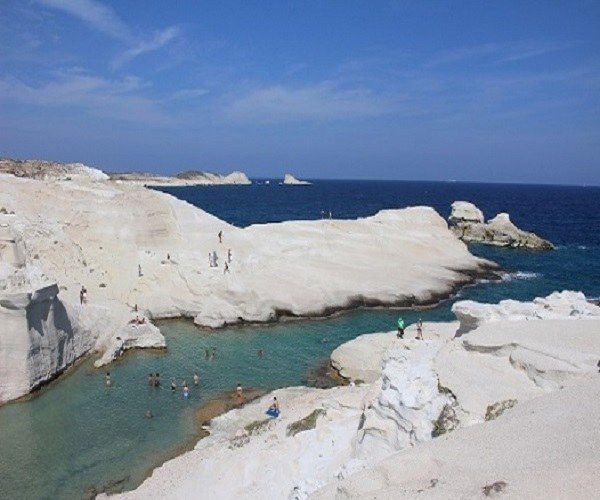
It’s mind-boggling that volcanic Milos has remained on the road less traveled, far-flung from the hordes of sunseekers that flock it’s fashionable Cyclades neighbors attract.
The flawless irregular formed gem of Milos is a geological marvel sculpted from years of eruptions at sea three million years ago, rain, and wind. Its rock formations are out of this world. It contains vast mineral deposits, including the clay types of bentonite and kaolin. The private hideaway has plenty of watering holes with over 70 beaches.
Each nook and crazy on Milos has a beach. Highlights include the alabaster lunarscape rocks of Sarakiniko, which gives the appearance of walking on the moon. Sit’s an ideal stop for kayaking and cave exploration.
The scorching multi-colored sand of Paleochori lined with beach bars and tavernas is a lazy way to spend a day. Papafragas, submerged in a cave enclosed by soft white rocks in deep blue waters, is another oddly formed swimming spot. To arrive at
hidden Tsigrado, you must climb down a ladder or swim in.
Beachgoers should seek Paliochori, with its crystal-clear waters, multi-colored sand and shiny pebbles, and Papafragas, submerged in a cave enclosed by soft white rocks in deep blue waters.
The best way to catch a glimpse of life on the rocks is by boat excursions that depart out of the port of Adamas. Among the most impressive highlights of a day sailing trip are the towering rock slabs at the ex-pirate den of Kleftiko, where you spend an hour for lunch and snorkeling. The brightly colored fisherman cottages in Klima is another magnificent spot on Milos.
There are daily flights in the high season from Athens to Milos Airport, and year-round ferry service from the port of Piraeus. The journey takes four hours on the high-speed boats or up to eight hours and regular ferries that make stopovers at other islands. Milos has excellent connections from most neighboring islands in the Cyclades.
Serifos
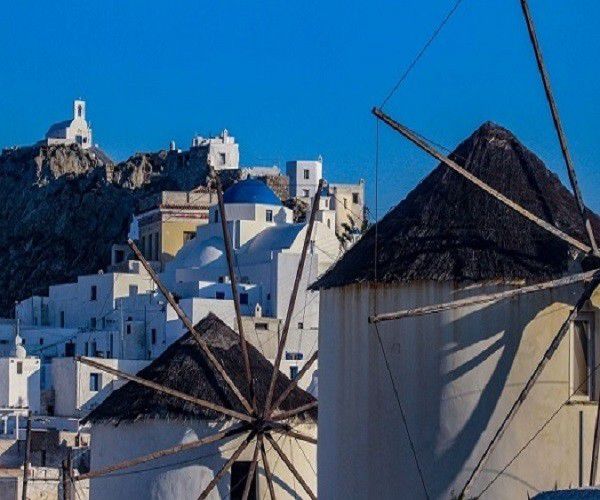
The island of Serifos is as far from the glitz and glamour of Santorini and Mykonos as possible. Entering the picturesque port of Livadi dotted with rows of irresistible fish tavernas sitting in the sand is taking a step back to undisturbed tranquil times of the Cyclades in the 70s or 80s when the island was off the grid to ferry-hoppers. The pier faces the chiseled mountaintop glancing at the capital of Hora. The enclave bustles in the summer.
From the mesmerizing cobblestone streets of Chora town’s precipitous towering mountainous backdrop, the aquamarine port and bay below shimmer in the radiant sunlight. In the prominent hamlet, the stellar Venitian Castle looms extensive offer eye-popping views of the Aegean Sea, and a kaleidoscope of colors burst into the evening during sunset.
Today, Serifos’ languid pace lures its fair amount of Cylade explorers. Yet, the Serifians have managed to keep their culture intact, and thus, draw visitors seeking an unhurried Greek escape.
Its undiscovered rugged beauty and open spaces likened to California’s central coast, or perhaps the Ventura Highway contains many jaw-dropping vistas leading to pebble beaches. It’s bluffs, peaks, and cliffs make the Aegean.
Located in the northern center of the island is the divine fortress-like Monastery of Taxiarches. Built-in 1572, the men’s monastery assigned to the island patron saints are Gabriel, and Michael is a must-visit. The sleepy beach of Mega Livadi sits in the shade under tamarisk trees. The shallow bay and cove perfect for families with small children.
Strolling the Serifos harbor at night is the quintessential Cyclades exposure.
Serifos is a comfortable two-hour ferry ride from the Piraeus port of Athens. Due to its growing popularity, the island connected to neighboring Kythnos, Milos, and Sifnos is optimum for a 3-4 island journey.
Sifnos
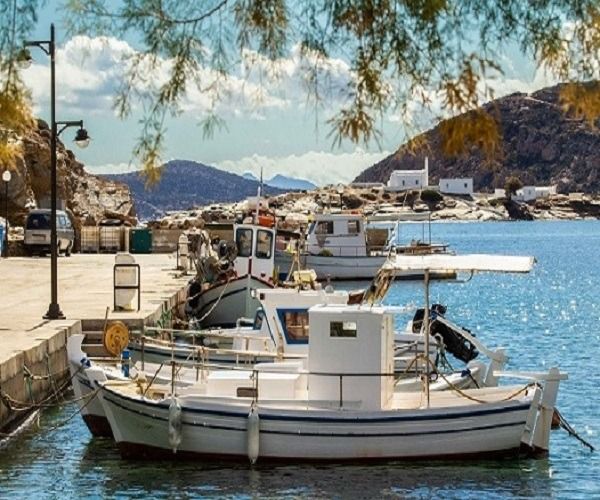
The chiseled masterpiece of Sifnos, brimming with olive trees, fragrant capers creeping out from rock beds, wild sage, oregano, and thyme, which grows throughout the mountainous isle and its fertile valleys has astounded Greek-Island hoppers for decades. The time-honored Greek Orthodox religion found at nearly 400 churches that dot the landscape.
The island crowning monument is the beautifully preserved mountain top ruins of the Agios Andreas Acropolis & Museum and adjacent church. Although newly excavated in the early 20th century, it’s inception dates back to the 13th century. The stunning Church of the Seven Martyrs reaches to the edge of the Aegean Sea.
The islands’ time-honored craft of pottery making dates back to the Cycladic period, and there are currently 19 pottery workshops on the island.
While no longer a best-kept secret, the island home of native son, poet, and culinary icon Nikos Tselementes and other master chefs are renowned throughout Greece for its gastronomy. Aromatic whiffs of mastelo, the customary dish of lamb cooked in red wine and dill baked in clay ovens, is a Sifnos delicacy.
The modest island of countless hidden churches and over 50 ancient towers is a hikers paradise. The old town of Kastro is a well-preserved treasure and a step back in time inhabited for more than 3,000 years. The ancient settlement filled with antiquities allows no cars inside the village maze.
Sifnos is under three hours from Athens by high-speed ferry and offers an enticing blend of traditional Greek life, combined with some of the best sun-splashed beaches in all of Greece.
By Nick Kontis
Exploring the Isle of Skye in Scotland
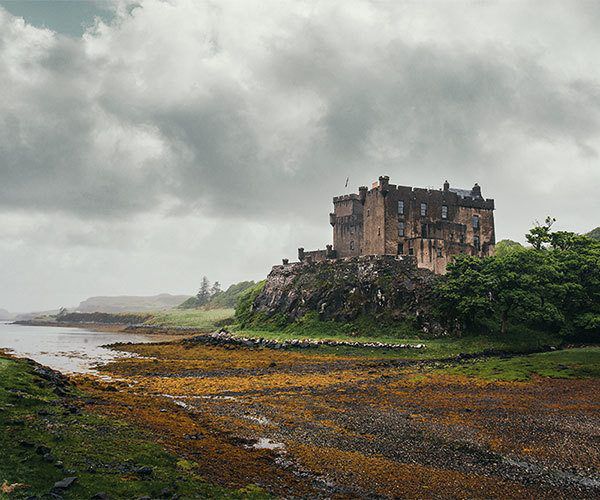
No visit to Scotland can be complete without a few days in the Highlands. A place of rare beauty, the Scottish Highlands are famous as the home of Loch Ness and the Isle of Skye. However, getting to Loch Ness and Skye from major cities such as Edinburgh can be complicated. Although some public transportation options are available to get to Skye, exploring the Isle requires renting a vehicle. While on the Isle, you would need to navigate narrow one-lane, two-directional roads. These roads can wash out in inclement weather – a common occurrence on Skye. With these logistical difficulties in mind, many travelers choose to take a luxury 3 day Isle of Skye and the Highlands tour instead. One of the most luxurious options for a 3 day Skye and the Highlands tour is the Heart of Scotland tour company.
Day 1
Although you can explore Skye on a larger tour bus, better to opt for the more luxurious 16 seater van option with the Heart of Scotland. “The wee red bus” is more intimate and flexible. You can make unscheduled stops and drive to places larger buses can’t. This added flexibility is important on an island where most roads are only one lane but the traffic goes two ways.
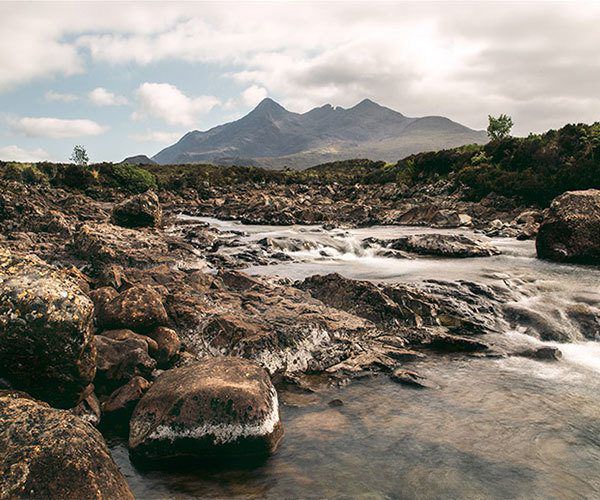
Scotland is divided into two parts, The Highlands and the Lowlands. These two areas are different geographically and culturally. In fact, they were always different because the country of Scotland was formed when two ancient continents collided millions of years ago. One continent became the highlands – the other, the lowlands. This explains the change in topography and nature.
Queensferry
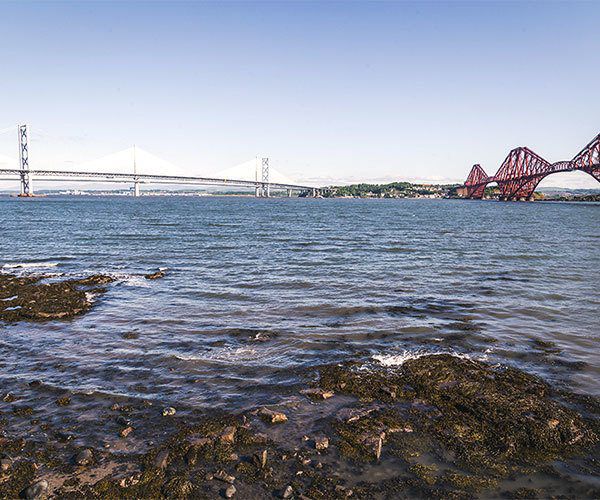
On the tour, first you will stop at the small town of Queensferry. Here, you’ll see three bridges, built in the 19th, 20th and the 21st centuries respectively. Each a marvel of engineering, in their day.” Established in the 11th century, the first crossing here served to connect the lowlands to the kingdom of Fife. One of the bridges, called the Forth Bridge, was built 125 years ago and today is a UNESCO heritage site. We drive over the middle bridge, open only to buses and vans.
Dunkeld Cathedral and town
Next, you approach the picturesque village of Dunkeld. Centered around Cathedral Church of Dunkeld, this 8th-century village is the first official stop of the day. The Cathedral, constructed in a mixture of Gothic and Norman styles and build over three centuries in the middle ages. The town, totally charming is exactly what you might picture when you hear the phrase “traditional Scottish village.” Afterward, you proceed further into the highlands over narrow lanes into the Cairngorms National Park. You will drive along the giant Loch Laggan and pause for lunch.
Eilean Donan Castle
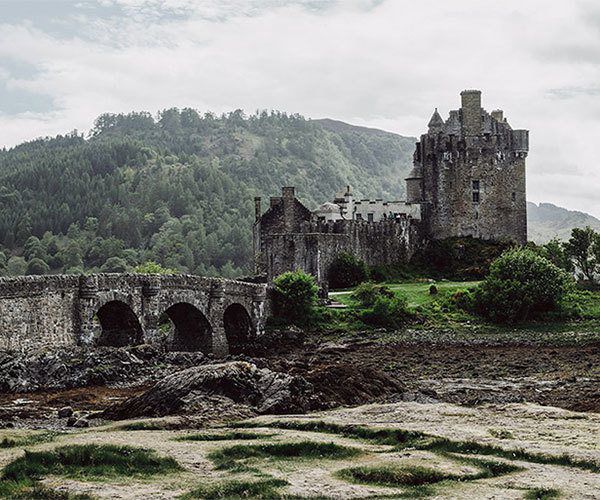
As you approach Eilean Donan Castle, the imposing structure towers over the landscape around it. Build on a site of a medieval castle, this is a clever one-hundred-year-old reconstruction. Castles that were continuously occupied were continuously updated. But Eilean Donan is frozen in time – around the 13th century. Clever it is indeed. The Castle is also famous. Used as a backdrop for many famous movies – from Elizabeth to the Highlander, the Eilean Donon Castle may be one of the most famous images in Scotland. And touring Elean Donan is like stepping back in time. You will find it very different from the modern luxury you will experience in the Dunfield Castle on Day 2 of the Heart of Scotland Isle of Skye tour.
Portree
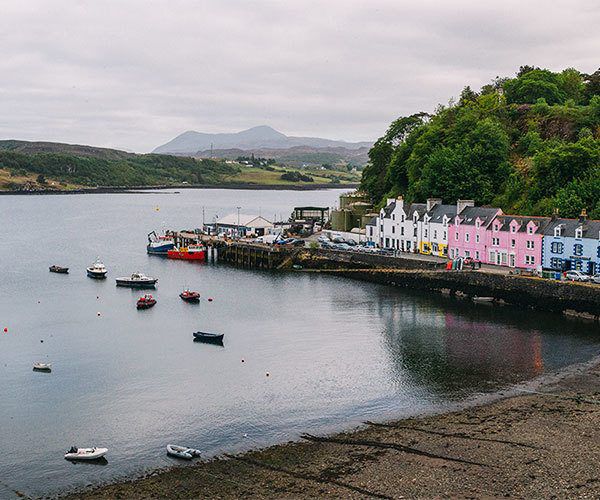
After a few hours, you approach the Skye bridge – your path to the beautiful misty island, Isle of Skye. We pass the enormous Cuillin mountains and arrive in the colorful and quaint fishing village of Portree. Although accommodations can be hard to come by in Portree, Heart of Scotland takes care of all the arrangments.
Day 2
You spend day two exploring the Isle of Skye. It turns out the Isle of Skye’s nickname – the Misty Island, is well earned. You may be greeted with relentless mist and occasional rain so be sure to dress for the weather.
Kilt Rock Viewpoint
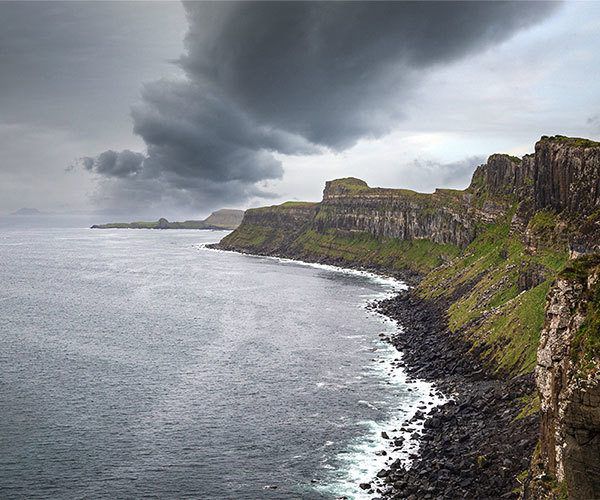
You start your day in the majestic Kilt Rock Viewpoint. Named Kilt Rock because it looks similar to a pleated Kilt, the views are stunning in every direction. And in every weather. To your right, the majestic Mealt Waterfall plummets to the rocky coast below. And to the left, endless Kilt Rock towers over the coast. The moody sky above only adds to the imposing effect.
Quiraing
Next stop is the Quiraing, a spectacular part of the Trotternish ridge situated in the north part of the Isle of Skye. Formed by massive landslides millions of years ago, the Quiraing is the only part of Trotternish that continues to move to this day. The road at the bottom requires repairs every year. You can wander amongst the imposing rocky hills and in the drizzling rain, and witness the true, severe beauty of the Misty Isle.
Skye Museum and graveyard
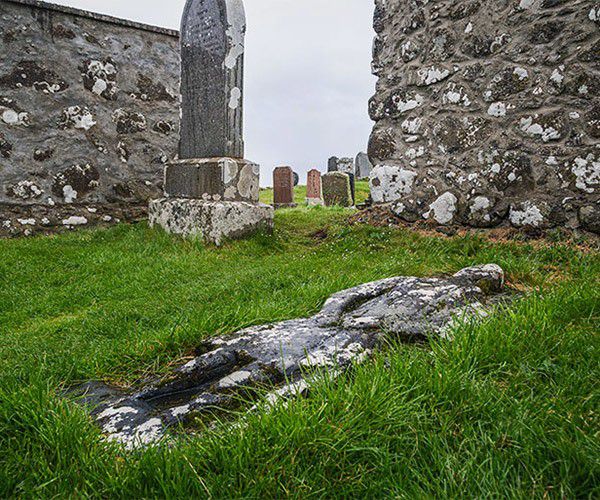
Your next stop, the Skye Museum of Island Life, is a fascinating glimpse into the traditional Skye lifestyle. Here, you find tiny thatched-roof shacks known as ” a black house,” outfitted with traditional tools. The small, self-guided museum offers a wealth of information and can take about an hour to explore.
Next, your Heart of Scotland group makes the journey to the graveyard adjoining the museum. Among the 19th-century burial grounds, you stumble onto an ancient resting stone. Here, a figure of a knight in full fighting gear lays carved in a rock. The stone is authentic but the person under it is not. It was stolen from a lost medieval burial ground and placed over the grave of someone who died in the 19th century. Although this sounds Macabre, apparently a common practice in the day.
The Dunvegan Castle
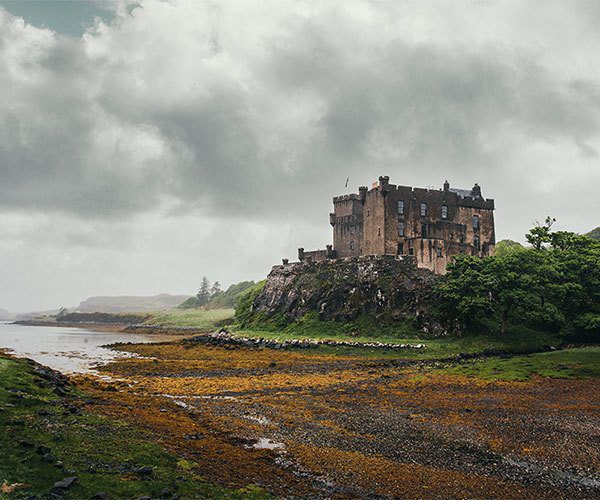
Perhaps one of the most famous attractions on the Isle of Skye, the Dunvegan castle, is the oldest continuously operating structure on the island. Inhabited by countless generations of the MacLeod clan, the castle is known as much for its rich history as its beauty.
Continuously restored by the subsequent generations who have lived here, the Dunvegan castle is richly decorated in the style of the late 19th century. The well-manicured castle grounds include several acres of gardens. It takes hours to do a proper tour of the Dunvegan gardens and castle – so this is a great place to spend an entire afternoon on the Isle Skye.
Day 3
On the third day of Heart of Scotland’s Isle of Skye tour, you travel around the world famous Loch Ness and drive past the stunning mountains of Glencoe and eventually you end up back in Edinburgh. Although the journey back to the city takes an entire day, there are plenty more rolling green highlands and sites to see along the way.
Kyleakin village
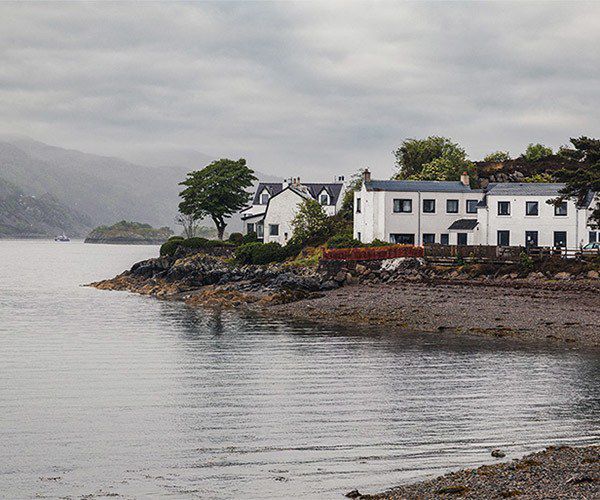
The first stop of the day is the Kyleakin Village, located on the east of the Isle of Skye. This sleepy little village is also the home of Castle Moil, an abandoned 15th-century castle. Legend says that the original structure on this site was built for a Norwegian princess nicknamed “Saucy Marry.” All day, she sat at the castle wall and required a toll from boats that wanted to use the narrow channel next to her castle. But, if she really liked the ship’s captain she would request other services as payment for passage, so legend has it.
Loch Ness cruise
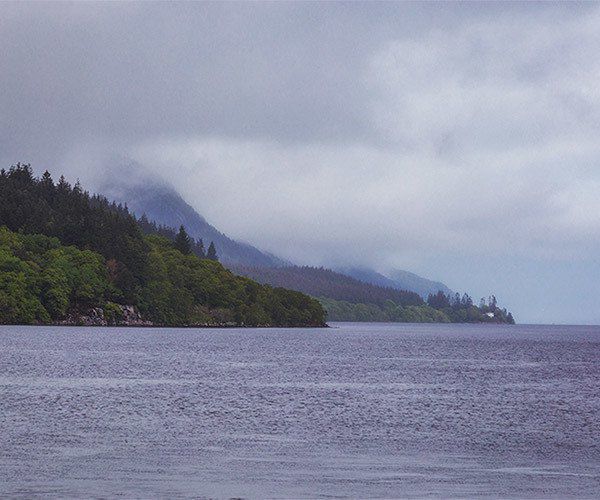
One of the highlights of Day 3, the Loch Ness Cruise is a bucket list item for many. You may believe you know all about the legend of Loch Ness. However, after you board, the crew will show you several radar images taken earlier this year. Some of the images clearly show 3 very large, moving objects on the bottom of the lake. In addition, there is also the fact that Loch Ness is located on an old fault line and that it is as deep as many parts of the ocean. The water in Loch Ness is so dark that there is no visibility only a few meters below the surface.
Maybe you’ll even be one of the lucky ones who get to see the large moving objects on the radar for yourself. Whatever is down there – whether a giant fish or a sea monster, the mystery remains.
Glencoe
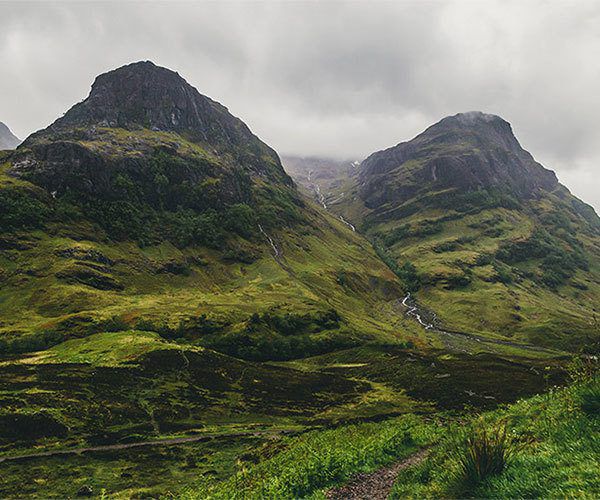
Unable to solve the mystery of Loch Ness, you proceed to your next destination – the mountains of Glencoe. Here, another legend awaits. The Glencoe Massacre is perhaps one of the best-known events in Scottish history. In the 17th century, during ongoing negotiations between the English and the Scottish leaders, the clan of MacDonald spent a few nights hosting English soldiers. The first several days passed without incident, but one night the guests turned violent and began to slaughter members of the clan in their sleep. 38 people died that night and countless others perished in the wilderness as they attempted to escape. The story of the Massacre of Glencoe has affected the relationship between the Scots and the English. Later on, the incident made it difficult to open a line of communication.
Today, the National Trust of Scotland cares for Glencoe’s pristine wilderness. Hikes of all lengths and skill levels start from the visitors center.
Loch Lomond National Park
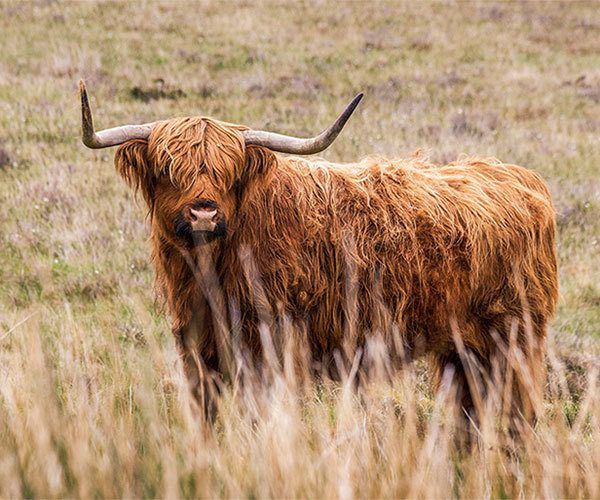
As you make your way towards Edinburgh and past the border that separates the highlands from the lowlands, you drive through the picturesque Loch Lomond National Park. After that, you will make your way back to Edinburgh with plenty of daylight left to spare.
Riding the Glacier Express through Switzerland
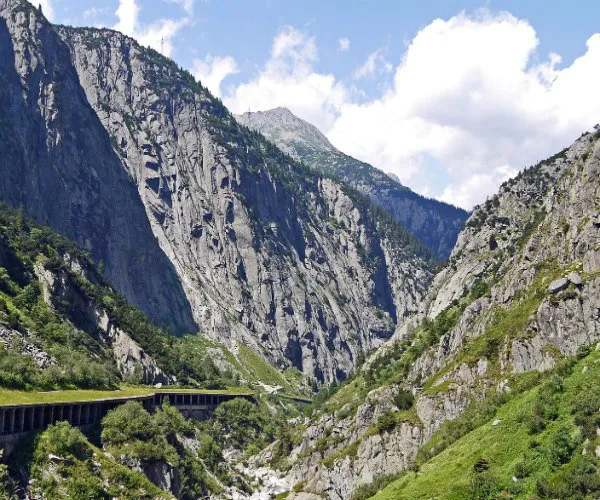
Switzerland impresses with its nature and mountains. One of the best ways to experience Switzerland is to take the Glacier Express. This is a panorama train that crosses Switzerland from St. Moritz to Zermatt. The Glacier Express runs this 8-hour route daily from May to October. Many travelers make the trip in a day, but here we show you how to turn it into a whole journey.
This trip is excellent for people who love the mountains and nature. The Glacier Express meanders through car-free valleys and leads over passes where there is still snow in summer. Let’s start the journey!
Badrutt’s Palace St. Moritz
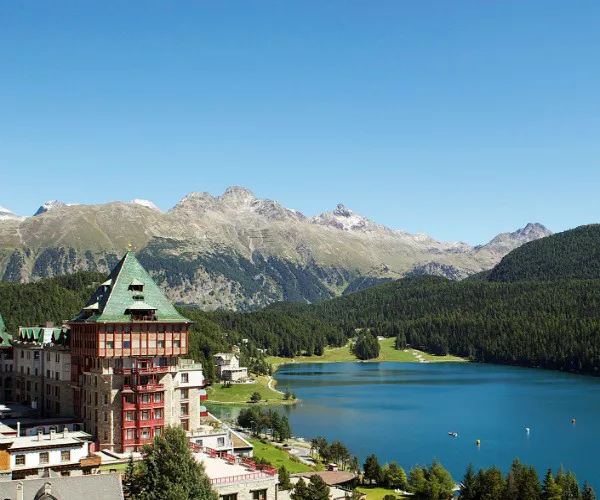
Our journey starts in St. Moritz, which is also the departure station of the Glacier Express. St. Moritz is known for its luxurious winter tourism and polo tournaments on the frozen lake. But St. Moritz also has its charms in summer – Hiking in the mountains or glaciers, mountain biking, or wellness. The hotels in St. Moritz have massively expanded their wellness offerings in recent years. So does Badrutt’s Palace in St. Moritz. The hotel with the turret is the village’s landmark for many and offers its guests 157 rooms. “Palace Wellness” is the spacious spa area that invites you to relax with a view of the mountains. Also not to be missed is afternoon tea in the hotel, a tradition in St. Moritz for more than 120 years.
From St. Moritz to Andermatt
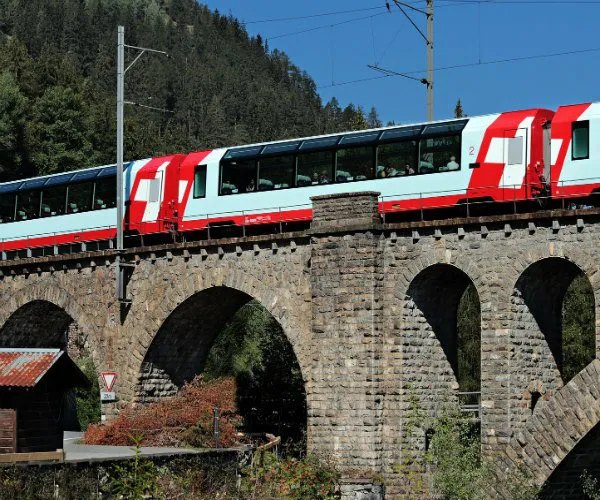
We recommend a stay of 2 to 3 nights in St. Moritz. Then the Glacier Express experience starts. The train station is only a few hundred meters from the hotel, and you get elegantly chauffeured there in a Rolls-Royce. Check-in is easy, and the seats are pre-reserved. If you let yourself fall into the comfortable seat, you can see that almost the entire roof is glazed and thus offers an eaves-like panoramic view. The compartments provide four places with a large table and full restaurant service. At 9.15 am the train starts moving. Shortly after leaving St. Moritz, you can immerse yourself in the mountain panorama. The train travels the Albula route, which is a UNESCO World Heritage Site. The highlight is crossing the “Landwasser Viaduct” – a 65 meter high and 136-meter long railway bridge. Then it goes down to Chur, where the train makes a stop.
The most beautiful part of the route
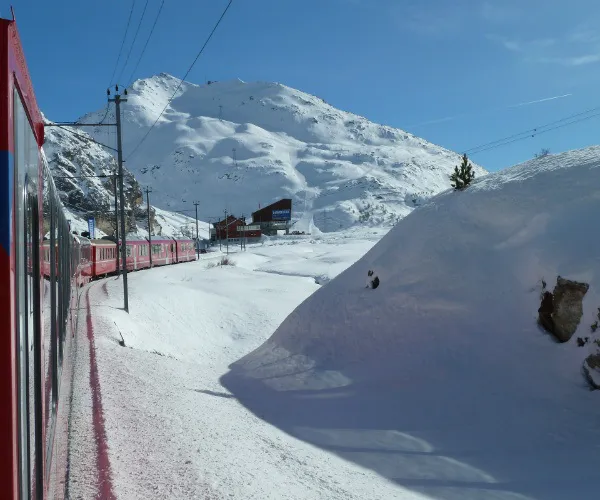
Now the most beautiful part of the route is waiting. Along the Rhine, it goes through deep valleys framed on the left and right by snow-capped mountains. The most beautiful section of the way begins, which leads to the 2033 meter high Oberalp Pass. A tunnel leads up to the pass – as soon as you come out of the tunnel, you usually find yourself in a winter landscape. The last part of the route leads down to Andermatt.
The Chedi Andermatt
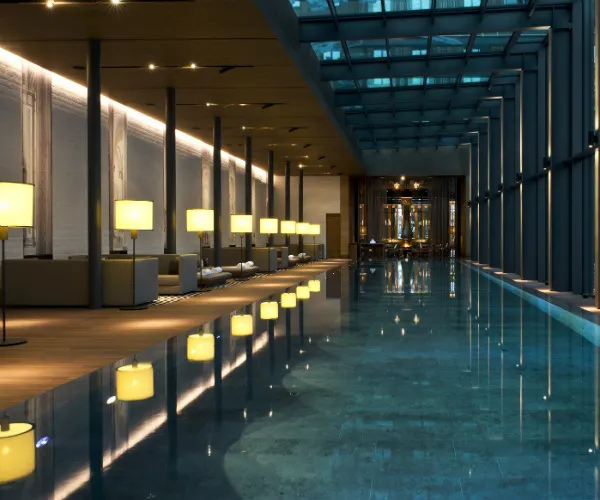
It is 2 pm, and the train is pulling into the tranquil and very traditional Swiss village of Andermatt. It is worth spending 1-3 nights here. The Chedi Andermatt is a 5-star hotel, which is located directly across from the train station. When you touch The Chedi, you immediately feel in another world. Very Asian, a lot of wood and metal and playful light effects – an absolute feel-good atmosphere and something that you don’t expect in the middle of the mountains (and in a village with 1,000 inhabitants). The hotel offers an eaves wellness area, 101 rooms, and two restaurants. In addition to exploring the small village, the place invites you to go on extensive hikes in the mountains – there is an 18-hole course available for golfers.
From Andermatt to Zermatt
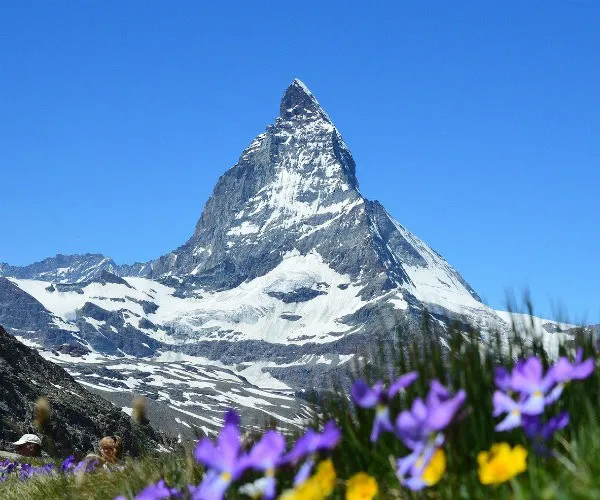
After a hearty breakfast and a few lengths in the hotel’s 35-meter pool, you cross the street where the Glacier Express is waiting for you. The last 3 hours are going to Zermatt. Enjoy a nice lunch on board the train and enjoy the mountains scenery. Then it gets dark for 15 kilometers because you drive through the Furka tunnel. After that, you are in Valais’ canton, where you cross the Mattervalley, the Glacier Express at Visp takes its course for Zermatt. The last part goes through the narrow valley along gorges and waterfalls until the train stops in Zermatt at 5 pm.
Grand Hotel Zermatterhof
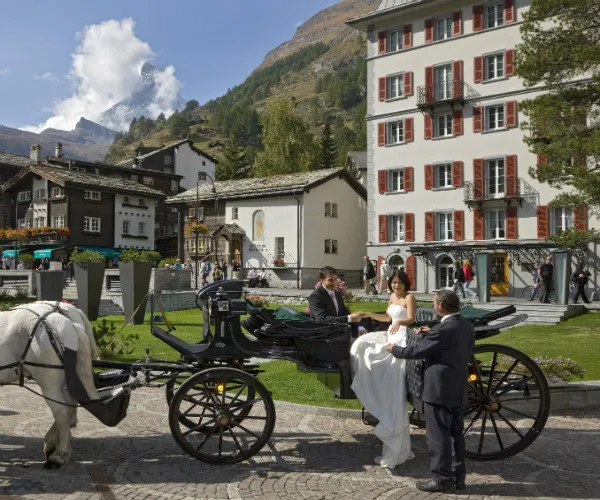
Zermatt is a car-free village – that’s why golf carts are waiting at the train station to take guests to the hotel. The 5-minute drive takes you through the main street up to the Grand Hotel Zermatterhof. As soon as you arrive at the hotel, you have the first view of the Matterhorn. The Matterhorn is the symbol of the region and also of Switzerland. The Zermatterhof has been welcoming guests for 140 years and offers 69 rooms in total. Thanks to the hotel’s central location, everything is straightforward to reach, and you can enjoy a fantastic view of the Matterhorn. It is worthwhile to stay here for 2-3 nights and take excursions to the mountains up to 4,000 meters high with the cable cars.
The journey through Switzerland
The costs of this train journey are – depending on the class – between 200 and 300 USD. Getting to St. Moritz is possible from Milan or Zurich and can also be made by train. After your stay in Zermatt, we recommend taking the train to Geneva and making stops in Montreux or Lausanne. This trip is ideal for guests who have never been to Switzerland or those who would like to experience Switzerland again from a different perspective. We will be happy to answer any questions you may have about the trip and the various possible combinations.
By Guido Graf
Explore unpretentious luxury in Brooklyn, New York
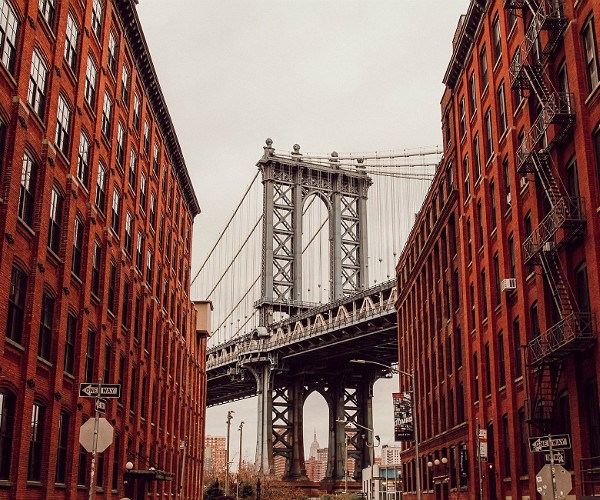
For fellow world explorers, travel bans and restrictions haven’t killed the travel bug — in fact, it’s probably “bugging” you more than ever before! But even though all the corners of the world may not be at your fingertips just yet, there’s still plenty of exploring to do. I asked my colleague, Esther Klijn, a Travel Agent Central 30Under30 honoree and intrepid world traveler, about her favorite place worth visiting that’s closer to home than international destinations. Her answer? Cultured, artsy, tasty Brooklyn, New York.
Before I go any further, I’d like to clarify: Brooklyn is not just for hipsters. Esther, who’s fluent in three languages, has a degree in wine and viticulture, and is a resident Brooklyn-ite herself, says there’s plenty of sophisticated things to see, do, and taste. However, she admits, “I do believe part of the charm of Brooklyn is that it’s not so chichi!”
Ahead, see some of her top Brooklyn experiences, hand-picked with luxury-loving travelers in mind.
Eat
Dine at Café Mogador
Brunch aficionado? Café Mogador’s award-winning brunch in Brooklyn is a must-try. And make a stop for dinner, too, to savor some of the restaurant’s authentic Moroccan food. Currently, there’s outdoor dining available as well as delivery and pick-up options.
Café Mogador in Brooklyn is the restaurant’s second location, following its initial success in Manhattan. In addition to noshing, says Esther, the spot offers “some top-notch people-watching.” “To this day, the same family runs and owns both locations,” she adds.
Indulge at Steve’s Authentic Key Lime Pie
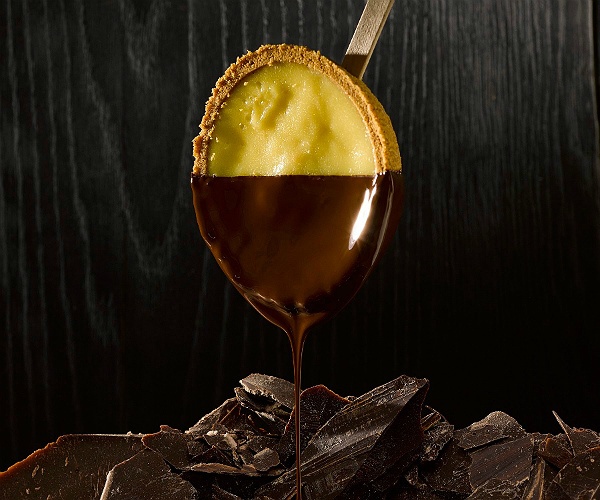
Key lime pie from a 23-year pie-making genius? Yes, please! Owner Steve hails from South Florida, where they make this tangy dessert best. Along with authenticity, he crafts his pies with only the finest ingredients, including fresh-squeezed lime juice. Shares Esther, “The single servings half-dipped in chocolate are my personal favorite.”
Drink
Imbibe at Brooklyn Social
Once the site of an exclusive club, the bar was reopened in 2004, proclaiming that all “non-members” are welcome. But while the patron policy has changed, the decor hasn’t; and inside, its tin ceiling, deco bar, and antique wall hangings have been preserved, including vintage photos of former members circa the 1920s. Above all else, “the bar has retained its friendly and cozy character,” Esther says.
There’s limited indoor seating but Brooklyn Social’s patio is still open, providing a dreamy backdrop for their legendary craft cocktails and hot pressed sandwiches. Ask about blankets if you’re chilly!
Sip at Red Hook Winery
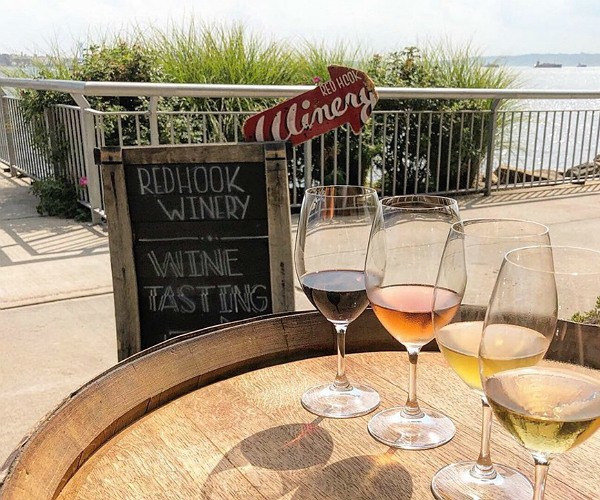
Drinks and a view! This down-to-earth winery offers scrumptious sips, plus a picturesque view of the Statue of Liberty and Manhattan from its patio.
Featuring vintages made from fruit in-state, there’s a “grape to bottle” variety for any wine drinker. Says Esther, “The tasting room offers 150 labels of Red Hook Wine that embody the salt and sea of the North Fork of Long Island and stone shale terroir of the Finger Lakes in Upstate New York.” What better way to explore the local landscape than to taste it?
Do
Stroll through Vinegar Hill
Take the F train to meander through time in this historic neighborhood. Once inhabited by Dutch and Irish immigrants, you’ll find, “19th century homes, timeworn storefronts, vintage cars, and sun-bathing cats in this 400-year-old cobblestone village perched by the old Navy Yard,” explains Esther.
Play at Royal Palms Shuffleboard Club
A taste of the tropics, right in Brooklyn! Filled with kitschy decor, along with games of shuffleboard (of course), you can sip fruity drinks and beer, listen to DJ spins, and sample the food trucks that frequent the place.
Advises Esther, “Walk-ins are welcome but for groups of 10 or more, it’s suggested to reserve one of the striped cabanas for $50/hour which includes beverage packages starting at $25/hour.” And, an insider tip: “The key is to go on a Sunday when the $50 fee is waived all together.” (Royal Palms is currently closed but add it to your list for 2021.)
Spend the Day at Domino Park
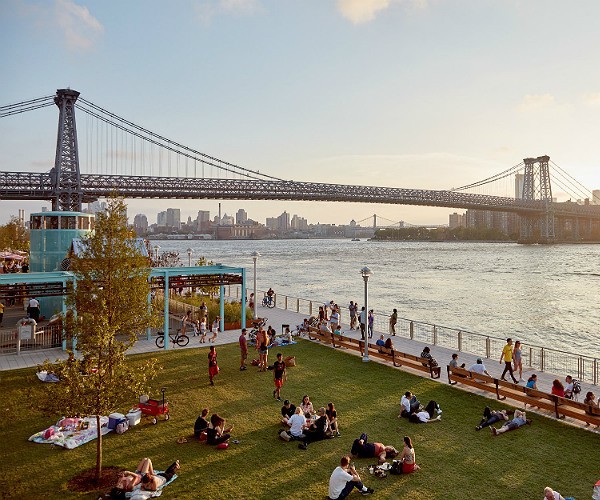
Ideal for socially-distanced outdoor fun, Domino Park is “great for a sunset stroll or morning run,” says Esther. And as a matter of fact, it’s a wonderful way to spend the entire day. This six-acre park, which features a quarter mile of waterfront views along the East River, was recently opened in June of 2018. It was built on the site of an old sugar refinery (you know, as in Domino Sugar), and now, there’s plenty to do and see.
You can meander around large-scale artifacts salvaged from the former factory, recline in one of the riverside lounge chairs, puppy-watch at the dog run, or grab grub from the onsite Mexican joint, Tacocina. As an added bonus, the park has “real bathrooms with cleaning attendants!” says Esther.
Invigorate Your Senses at Bellocq Tea Atelier
Travel the world through a teacup at this gourmet tea shop, stocked with enough brews to please even the most refined connoisseur. A memorable experience from start to finish, the enchantment begins right at the door. “Ring the bell to enter through an inconspicuous black door revealing exotic hanging plants, weathered walls lined with beautiful tea cases and antique measuring instruments,” says Esther.
Her recommendation? “Discover Marjorelle Mint and High Mountain Oolong tea alongside a curated collection of tea wares, incense, honeys, and candles,” she says.
Sleep
Kick back at the Williamsburg Hotel
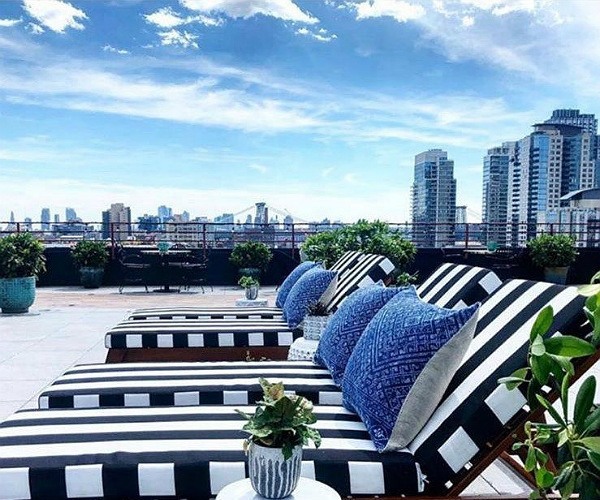
Both posh and contemporary, the Williamsburg Hotel is conveniently located in North Brooklyn, home of some of the best eats in the borough and in close proximity to Manhattan. “You’re walking distance from Bedford Avenue and all other happenings of Williamsburg,” Esther points out. “In addition, guests have access to complimentary bikes to explore the ‘hood”!
If you’d rather relax, you can lounge by the rooftop pool (currently closed for the season), dine at the onsite Seven Seeds restaurant, which serves up Mediterranean food, or sip cocktails in your room while taking in the view.
See, adventure isn’t so far away! Get your fill of lavish livin’ (minus the pretentiousness) by taking a trip to New York’s trendiest borough.
Author’s note: Some stores, restaurants, and destinations highlighted in this article may have different hours and procedures due to COVID-19, or may be temporarily closed. Because of this, I highly suggest calling or checking the websites of individual locations before planning your trip.
By Eric Hrubant
The charm of yachting on Croatia’s Istrian Riviera

On the north western coast of Croatia, the Istrian Riviera is an exceptional region sprinkled with charming villages and national parks where a blend of rich history and vibrant culture thrive. As Croatia remained relatively unaffected by the Coronavirus crisis and has been one of the first countries to reopen to yachting and international travel, this lesser-visited peninsula is an ideal location to discover the natural delights of secluded anchorages and hidden coves on a relaxed and fascinating yacht charter.
Umag
Known as the Croatian gate to Europe, and just 10km from the Slovenian border, westernmost Umag is dotted with ancient architecture, such as the 10th century town walls and ornate Venetian villas. History enthusiasts will enjoy St Mary’s Church with its baroque façade and bell tower, while the town museum, a former defence tower, displays a variety of Roman amphorae and lamps. On the coast, visit Saint Pelegrin Church, first mentioned in 1106 where folk tales state that Saint Pellagio walked here, and his steps can be seen in stone when the tide is low.
Umag town itself is backed by verdant hills delivering magnificent views over the sprawling marina where moored yachts are ringed by a long sea wall constructed in the 1800’s. Take time to wander the narrow, cobbled streets of the compact old town at ease, strewn with friendly restaurants and shops selling regional olive oil and wine. A water sports haven, the clear waters here are perfect for scuba diving, kayaking and fishing. In neighbouring Savudrija, visit the oldest lighthouse in the Adriatic or snorkel off the beach at Zambratija to view a shipwreck teeming with corals and crabs.
Novigrad

Retaining the intimate and irresistible charm of a typically peaceful Mediterranean fishing town, Novigrad is an enchanting destination, known locally as Cittanova. On the eastern side of the bay is the well-equipped Marina Nautica, offering easy yacht berthing to enjoy the delights ashore. Situated on the north side of the Mirna River, Novigrad is filled with historical sights, rich cultural heritage and preserved natural beauty. It is also a top Istrian gourmet destination offering excellent cuisine, most notably delicious fresh fish. Novigrad old town is dominated by the bell tower at St Pelagio and St Maxim’s Church, modelled on St Mark’s campanile in Venice. This exceptional three-naval basilica, with the only early Roman crypt in Istria, is set in the main square and hosts a variety of regional festivities and ceremonies. Nearby, pebbly and secluded Karpinjan Beach is bordered by Mediterranean pines in a beautiful setting, while the sandy beach at Lanterna is popular with families.
Poreč

A truly authentic Croatian town, Poreč features a tranquil harbour, protected by the island of Saint Nicholas. Home to the stunning 6th century Euphrasian Basilica, a UNESCO World Heritage site, the town’s vibrant heritage is reflected amongst the varied architecture with examples of Roman, Byzantine, and Venetian structures. Poreč’s maze of narrow, cobbled streets is a car-free zone, dotted with quaint shops, churches and restaurants, a lovely place for a relaxed stroll.
The two large bays south of the main town are Zelena and Playa Laguna, each offering a host of activities, scenery and entertainment. With a mostly rocky coastline, beaches here are generally pebbly, however, some have been artificially converted to sand for visitors’ comfort. Watersports are popular, with many bays offering idyllic spots for yachts to drop anchor and enjoy water-skiing or jet skiing, and the countryside surrounding Poreč offers thrilling bike trails and gorgeous scenery. Take a short trip to the nearby Baredine Caves, home to a breath-taking display of stalagmites, stalactites and an underground lake.
Vrsar

Made famous by Casanova’s legendary adventures in the 18th century, as he stated that Vrsar was the “town of good wine and beautiful women”, this former fishing village once became a summer residence for the bishops of Porec in the Middle Ages and now plays host to those looking for tranquil relaxation amidst natural beauty. Set hillside and surrounded by beautiful islets, Vrsar boasts legendary sunset views. Explore the atmospheric old town with winding streets and old stone houses, then take in the timeless charm of the seafront promenade and pretty marina.
Visit the entirely fascinating Dzamonja Sculpture Park, follow seaside cycle paths towards scenic Lim Bay with its stunning fjord or dive the 20+ fascinating underwater reefs off the coast. The small airport here provides the unique opportunity to take a panoramic flight over the area and admire the splendour of this region from above; alternatively, there are options for skydiving.
Rovinj

Charming and colourful, medieval Rovinj is Istria’s headline attraction, said to be one of the most romantic places in the Mediterranean. In the car-free old town, the soaring spire of St Eupehemia’s Basilica rises in majestic grandeur over the sea of terracotta-tiled roofs and cobblestone streets below. Wander through the Balbi Arch into the heart of the town where a maze of winding alleyways is adorned with gothic carvings and intimate piazzas teem with rustic seafood taverns and art galleries. Surrounded by low hills dotted with stuccoed Italian-style properties, the shoreline is framed by the beautiful islands that form the Rovinj archipelago. Sail over to verdant Katarina Island, directly opposite, offering fabulous views and hidden coves, or escape to the forest park of Punta Corrente, a sanctuary of natural calm blessed with pine-fringed walks and cycle paths.
Fažana and Brijuni Islands

A pearl on the west coast, Fažana is a charming fishing village, and the starting point to access the national park of the Brijuni Islands. In the old town, the parish church of St Cosmas and Damian and St Mary of Mount Carmel are fascinating cultural visits to understand the provincial heritage. The vibrant port and seaside promenade would normally host a variety of summer festivals, the oldest and most famous is the ‘Party of Mackerel’ renowned for fish carrying contests, while Istrian folklore dancers bring lively entertainment during ‘Fažanski Tanac’. Gastronomy is an important regional feature and restaurants serve delicious local fare, particularly fresh seafood. The neighbouring Brijuni Islands are an extraordinary blend of natural, historical and cultural beauty. This national park encompasses over a dozen magnificent islands situated across the Fažana Channel where Veliki Brijun, the largest inhabited isle, has archaeological ruins, a safari park and landscaped gardens to visit.
Pula

One of the largest Croatian towns, bathed in a wealth of ancient history, capital city Pula is located on the southern tip of the Istrian peninsula. The well-preserved UNESCO amphitheatre of Pula Arena, built in the 1st century AD, is one of the world’s largest surviving roman amphitheatres, once used for gladiator fights and now the centre of city life, hosting events and festivals. There are a wide variety of beaches found around Pula, with family friendly, blue-flagged Ambrela a popular choice thanks to crystal clear shallow waters and velvet sands.
Venture further south and the pretty coves of Kamenjak Cape natural park are a yachting paradise, dotted with quiet beaches and hotspots for scuba diving, plus a myriad of excellent biking and hiking trails. Take advantage of kayaking to explore the coastline from a different perspective. Nearby the family-oriented resort of Medulin is famed for the 1km sandy stretch of Bijeca Beach, with shallow waters perfect for children.
Rabac

Blessed with picturesque coves lapped by crystal clear waters, the small town of Rabac is an oasis of peace on the easternmost Istrian Riviera. With award-winning olive oil produced by the local Belic family, not to mention the delicious labinski krafi desert, Rabac is certainly the place to linger over a meal. The waterfront promenade springs into life every evening, with seats at an array of excellent seafood restaurants being highly sought after. The area boasts no fewer than four stunning Blue Flag beaches, with the top pick being Girandella in Kvarner Bay, fringed by fragrant pine trees and with white pebbles providing a perfect spot to relax. Popular with hikers, one of the provincial trails leads walkers through pine filled forests and past the mysterious Negri’s Cave to the colourful hilltop town of Labin. If you feel like getting back to nature, cruise over to explore the unspoiled delights of nearby Cres island, home the rare griffon vulture and a myriad of flora and fauna amidst spectacular trails.

Lesser known than some other areas of north and south Croatia, but certainly packing a scenic punch, it is clear to see that the Istrian Riviera has a great deal to offer. The history, gastronomy and activities that flourish in this understated locale make the peninsula a perfect summer yacht charter destination.
By Nicholas Dean
A coast-to-coast guide to Mauritius
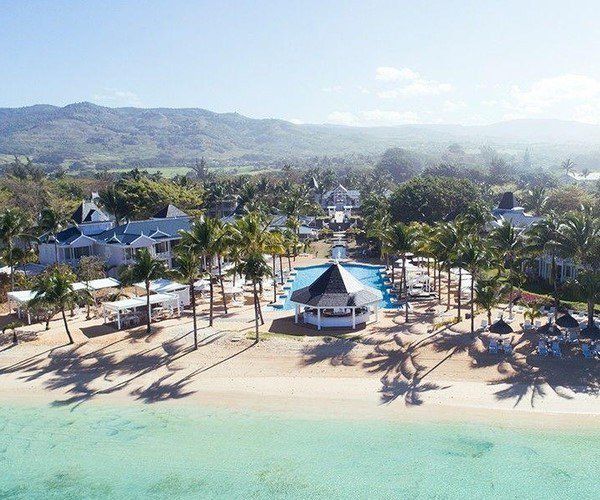
Mauritius has long been a favourite beach destination. Perfect for families and honeymooners alike. Popular with golfers and also outdoor enthusiasts, this tropical haven is alive with sun filled activities, warm water, excellent food and rich, warm, welcoming culture.
Each side of the island offers its own appeal and many argue which is the best? We believe that they are all worth a visit and there is no side of the island that will not offer a magical experience.
South coast
The south coast is known to be a quieter, more nature focussed side of the island. The landscape is lush and wild, with forests and hidden waterfalls. The ocean waters along these beaches are choppier for swimming, however the beauty of the area makes up for it. The South is the least built up of all the coasts and offers only a handful of hotels.
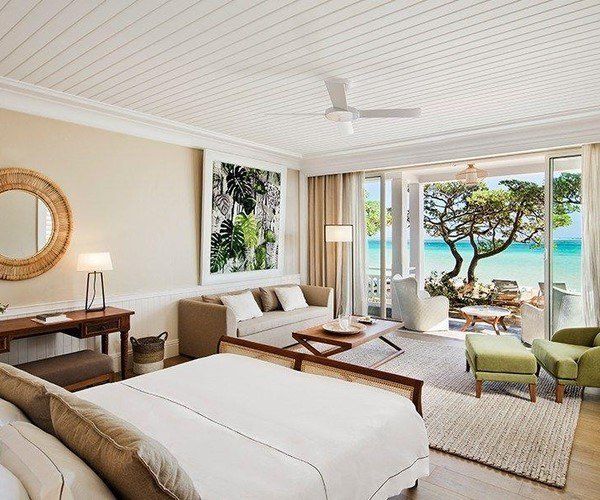
Heritage Le Telfair was the first place I evber stayed in Mautitius, and I have loved it ever since. A stay here extends an invitation to wander along the alleys of time, back to when Mauritius was a strategic stopover along the Sugar and Spice Routes.

A member of the Small Luxury Hotels of the World, the resort offers spacious and luxury accommodation combined with a decor reminiscent of olden day Mauritius, refined cuisine with a thousand and one flavours as well as an abundance of leisure activities, both on land and water.
Swim, sail, kitesurf or just relax by one of the pools. From yoga in the nature reserve to a round of golf on a European Tour branded golf course, the wide selection of land and water based activities is sure to entertain the most adventurous types.
North coast

The north coast is known as the busier, more vibey part of the island. Near to the Grand Baie hub, this town has a wonderful tourist atmosphere dotted with restaurants and pubs. Beaches of soft sands and lovely swimming and diving areas, the north is also protected from the cooler wind in the Winter months.
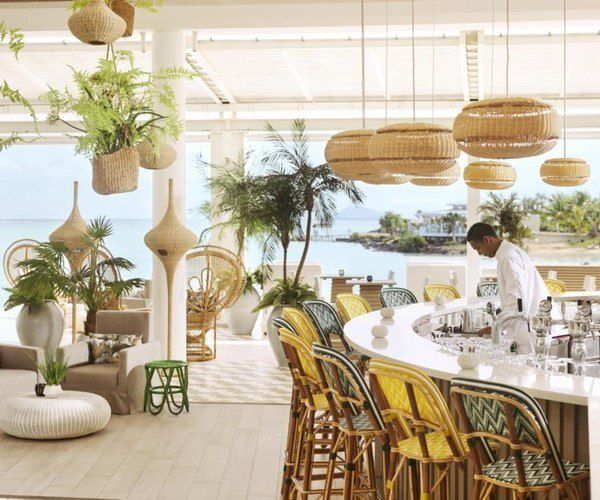
There are many great hotels along the north coast, howvere I have always been fond of the romantic and beautiful Lux Grande Gaub. A gentle stroll from a quiet fishing village on the north coast of Mauritius, Lux Grand Gaub is tucked away in one of the island’s most beautiful locations, the hotel offers spectacular ocean views.
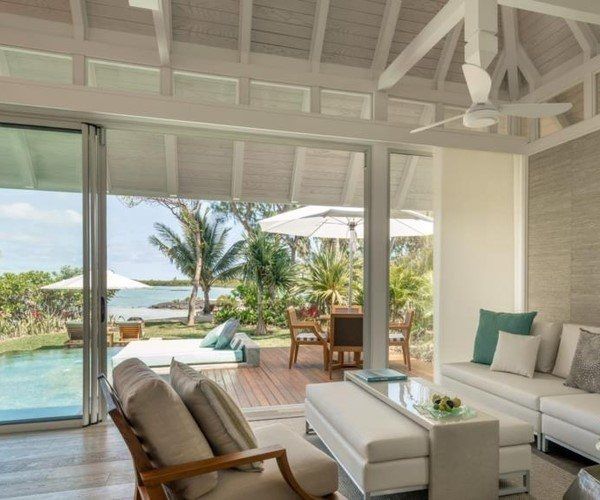
An excellent 5* PADI diving centre, allows anyone from beginner’s lessons and certification to reef diving along the nearby underwater playgrounds. From the bustling markets of Goodlands to the buzzing bars and boutiques of Grand Baie, the north of the island has many attractions. Settle in to the rhythm of Mauritian life with colourful displays of traditional music and dancing.
West coast
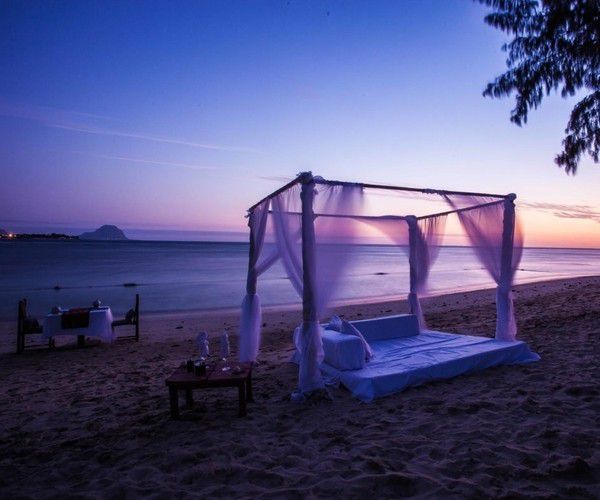
The west coast offers a warmer climate in winter months and is a haven for water sports, long beaches dotted with resorts and picturesque sunset year round.
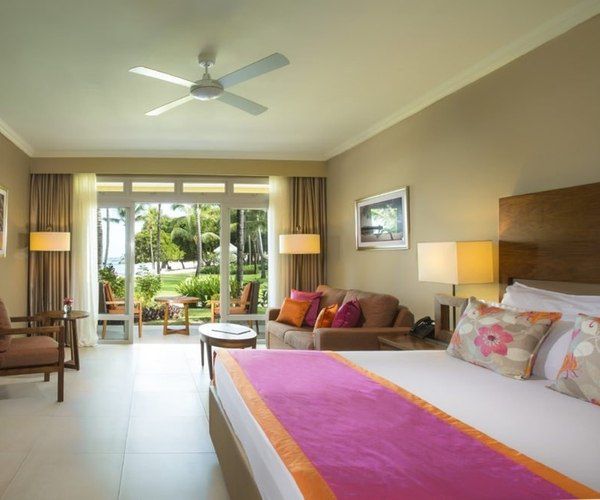
This is one of the most popular areas of the island and there are a great number of hotels to choose from along the great expanse of white sad beaches. Situated and the more secluded end of the pristine white sandy beach at Flic en Flac, the Sands Suites Resort & Spa is a hideaway for anyone seeking tranquility, comfort and personalised service.
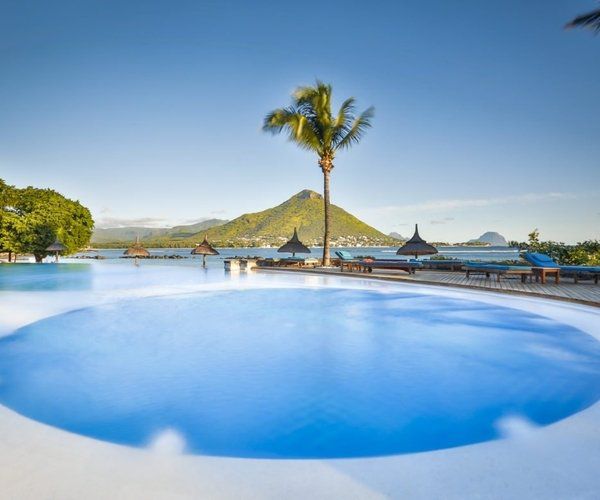
Overlooking the translucent blue and turquoise lagoon of Tamarin Bay and the legendary rock of Le Morne Peninsula, the scenic lagoon in front of the hotel is ideal for a wide range of water sports, including glass-bottom boat, kayaks – single and double – paddleboats, snorkelling, water skiing, windsurfing and sailing (laser boats). If you would rather keep on shore, the hotel also has a wonderful infinity pool with great views of Le Morne in the distance.
East coast
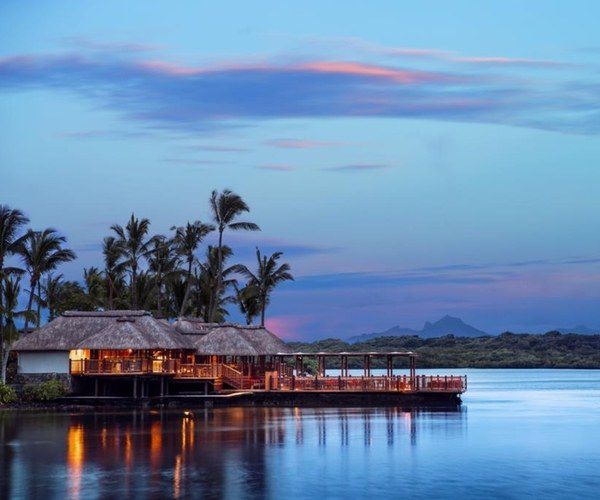
The east coast is more exclusive and has some of the islands most luxurious hotels. The beautiful white sands of Belle Mare Beach and Ile aux Cerfs make this side of the island very appealing. As the east coast offers the largest selection of luxury hotels we have chosen two for this coast and what a hard decision it was as you are really spoilt for choice here
Incomparable and distinguished, the One&Only Le Saint Geran nestles peacefully on its own private golden peninsula at the northern tip of the renowned Belle Mare coastline, surrounded by 60 acres of tropical gardens and thousands of swaying coconut trees.
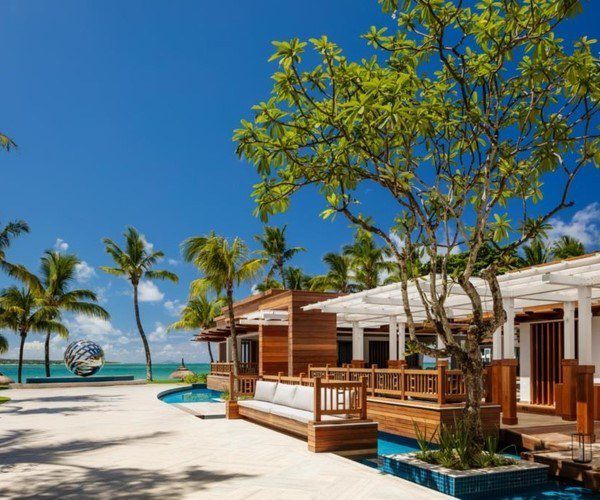
The enviable stretch of beautiful white sand is an idyllic place to relax, or a total of 3 heated pools, including a stunning infinity pool at the tip of the peninsula, offer families and couples their own dedicated spaces to unwind. The azure ocean views must be seen to be believed.
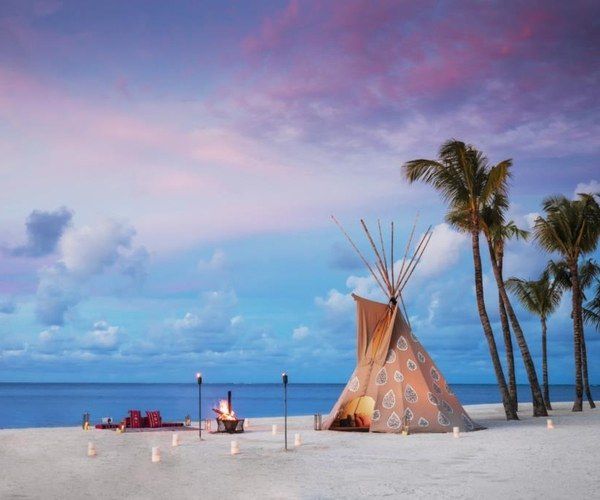
The certified PADI Gold Dive Centre offers guided diving and introductory courses, or the warm waters of the Indian Ocean are ideal for kitesurfing or laser and hobie cat sailing. The calm waters of the enchanting lagoon provide ideal conditions for paddleboards and kayaks, or experience deep sea fishing on board a professionally equipped boat.
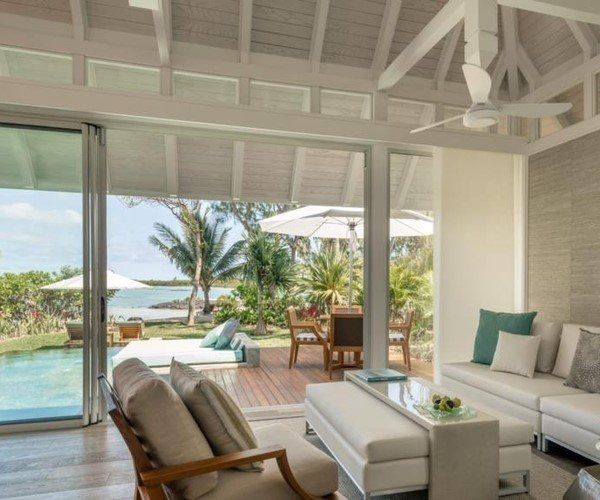
The 5 restaurants are some of the most highly recommended places to eat on the island, with each offering its own mouth-watering recipes and flavours. Chic Mauritian beach-vibes meet decadent cocktails as you take in the beauty of the views from the bars and lounges. Or indulge in an evening of private dining on silky soft sands, with no-one else in sight.
Another wonderful choice on this side of the island is the Four Seasons Resort Mauritius at Anahita. This is a secluded and spacious luxury resort where you can spend all day coasting across the water in your own sailing boat, playing golf on the oceanfront Ernie Els designed golf course, tour a former sugar plantation, make friends with a giant tortoise, and afterwards fall asleep under the stars. Your stay here invites romance and endless possibilities for adventure amid the dramatic landscape and the vibrant colours of Mauritius.
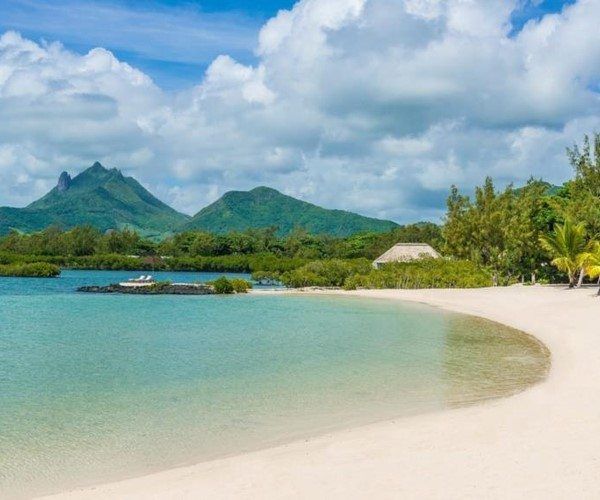
With waterskiing and all non-motorized water sports complimentary to guests, why not master a new skill? The protected lagoon waters provide a fantastic learning area, and there’s plenty of choice to keep all ages happy. Additionally, there are complimentary excursions from the Boathouse twice a day for both snorkelling tours and glass-bottom boat trips. The resort also has two secluded beaches within its 26 hectare grounds.
Guests can also enjoy exclusive access to a picturesque cove on the eastern side of nearly island Ile aux Cerfs, famous for its stretches of white sandy shoreline.
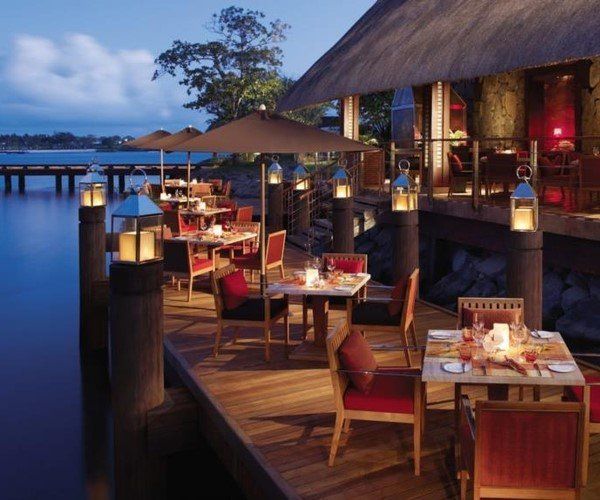
In the evening there are a range of waterside dining options where you can enjoy some wonderful food in a truly romantic waterside setting.
By Paul Campbell
The best luxury rural hotels in Mallorca with great food
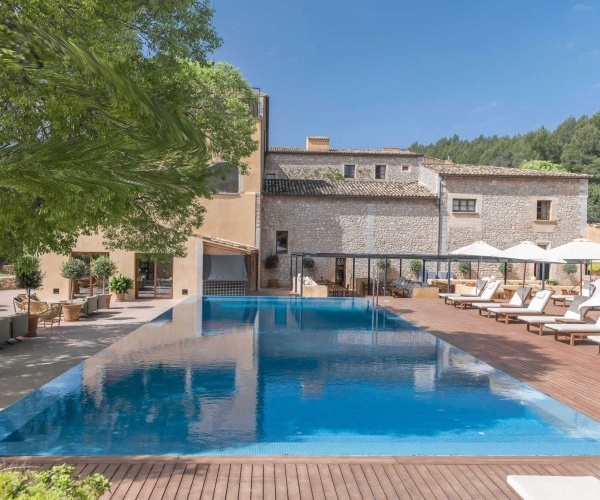
The real Mallorca has some enchanting hideaways and rural retreats set in rolling countryside, some with the World Heritage Tramuntana Mountains as their backdrop and others just a cycle ride away from the coast. There is a great choice!
A love of food is synonymous with Mallorca and there are few places in Spain where can you find so many flavours and such incredible variety of local produce in such a small area. The hotels we have selected showcase this local cuisine and local produce as well as being fabulous places to stay.
Son Brull Rural Retreat
With impeccable credentials in the hospitality sector, the Mallorcan Suau family had owned several hotels previously but Son Brull Hotel and Spa was always going to be `the one´. Housed in a restored 18th-century monastery, the Son Brull Hotel and Spa combines historic architecture with sleek modern design. The rural setting is breathtaking as you spy its ochre grandeur nestled in the landscape just minutes from Pollensa. Restaurant ´365´ headed up by Chef Andreu Segura and his team offers a local menu for lunch and dinner served either outside on the terrace or inside where you will be seated amidst it´s centuries – old olive press which has been lovingly restored.
The Son Brull team has taken on the challenge to grow as much of their own fruit and vegetables as possible to supply Rafels´s kitchen. There is even a vineyard on site supplying guests with Son Brull wine.
Predi Son Jaumell Hotel Rural
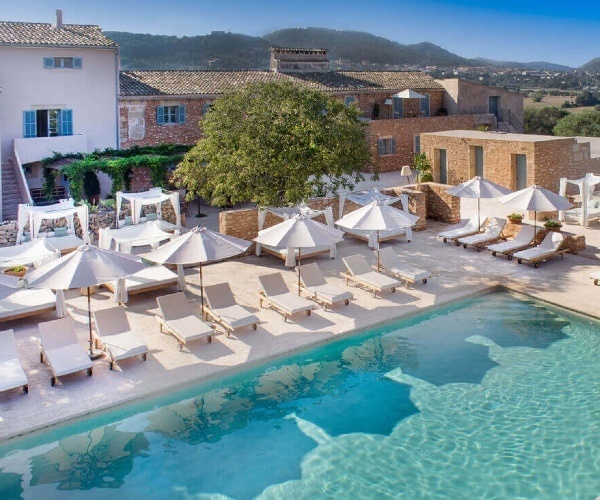
Located in the countryside in the North East of Mallorca, Predi Son Jaumell Hotel Rural is a true haven of peace and tranquility. The estate, dating back to the 17th century, has been lovingly restored and enhanced to create a stunning rural idyll. Just north of the historic hilltop town of Arta and minutes from some of Mallorca´s stunning sandy beaches, its location is hard to beat.
From hiking to horse riding around the picturesque countryside or taking one of the hotel´s bicycles to the beach for a picnic, you are spoiled for choice.
And the chef knows a thing or two about food ! Michelin starred chef Andreu Genestra is passionate about Mallorcan food and has his signature restaurant at the hotel. Cuisine of the calibre of Restaurant Andreu Genestra would normally be associated with big city locations but not so in Mallorca. A truly memorable gastronomic experience awaits you just a few steps from your hotel bedroom.
Hotel Pleta de Mar Luxury Hotel by Nature
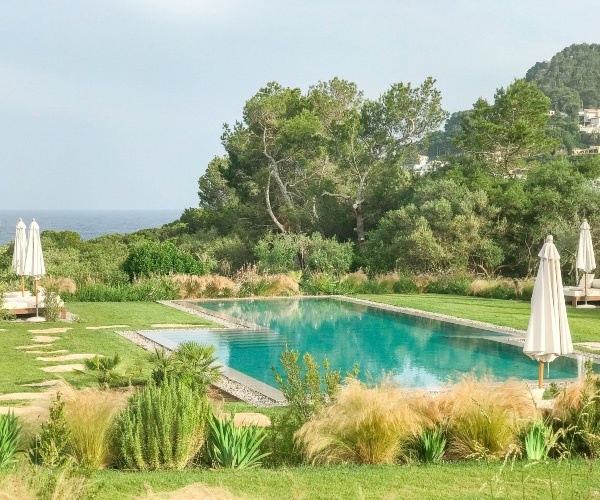
Pleta de Mar Luxury Hotel (`pleta´meaning walled shelter for sheep) is the affectionate name given to this luxury property nestled along the shores in the tranquil northeastern corner of Mallorca. On property which has been in the same family for some 800 years, the construction of this luxury hotel has been sympathetic to its location in every conceivable detail even ensuring the original walls of the sheepfold were kept intact and preserved.
This hotel seamlessly blends luxury with nature. The standalone suites are hidden amidst the natural foliage. Mature olive trees have been incorporated into the design and meadows of flowers and long grasses are the backdrop to the pool area.
Lets talk about the food. “Sa Pleta by Marc Fosh” gives rural dining a whole new meaning. Marc Fosh, the only British Michelin starred chef in Spain, offers a menu from the wood-burning grill, using local Mallorcan and Mediterranean produce bringing his own personal touch to offer a unique dining experience in this very special setting. The restaurant will be open to non – residents for the first time in 2021.
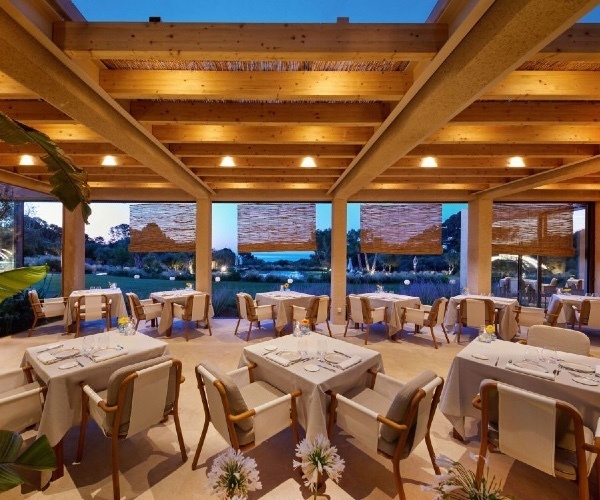
Castell Son Claret
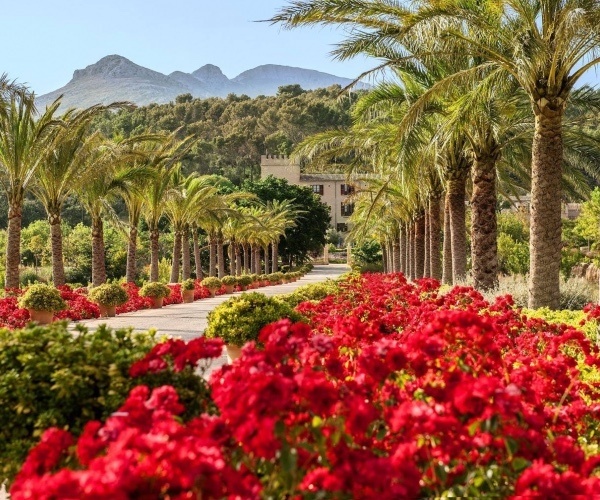
This luxury hotel, or should I say castle, is set deep in the countryside just minutes from the historic village of Calvia. Centred around a renovated 14th-century sandstone castellated farmhouse, the hotel is offering is truly romantic. This is a place where you will find the time to enjoy the tranquility of the countryside, broken only with the occasional sheep’s bell tinkling in the distance.
The hotel’s kitchen team were trained by Fernando Pérez Arellano (previous head Chef and holder of two Michelin stars) and offer an outstanding culinary experience. The restaurant is in a magical setting in the central courtyard of the hotel where the tables are laid in the warmer months. The kitchen draws on the gastronomic richness and bounty of the Balearic Islands and presents a culinary menu which is inspired and exciting.
Fontsanta Hotel and Spa
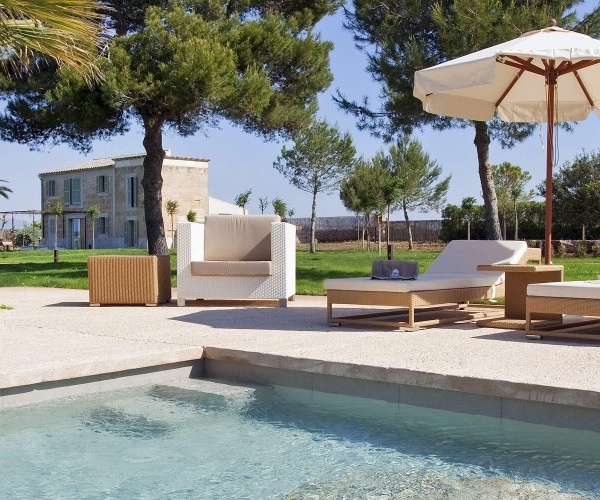
Close to the Es Trenc salt flats in southeast Mallorca, Fontsanta Hotel and Spa offers contemporary chic with minimalist decor and a very friendly welcome. The natural thermal spa is a huge draw as well as its location offering outstanding views of the countryside.
The Restaurant with vaulted ceilings and complete with open fireplace for the cooler months and extensive terrace for the warmer months offers a locally inspired traditional Mediterranean and Mallorcan menu and is headed up by Chef Jhonatan Maldonado.
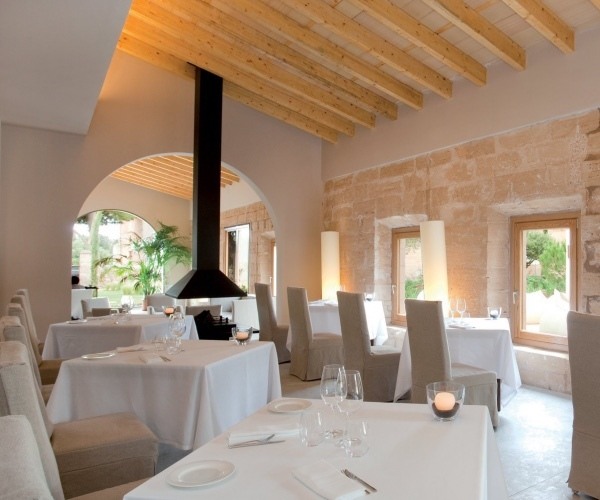
He says “The kitchen offers the possibility to brighten a person’s day. For me that is something incredible. Sit down and try the menu and something magical happens which lifts your spirits, cheers you up; for that reason I am a cook.” Its dishes are full of colour, a fusion of cultural dishes and seasoned with Flor de Sal, sea salt from the neighbouring salt flats. What could be more local.
So when the time comes to choose your hotel for your next visit to Mallorca, why not head to the real Mallorcan countryside and let the island´s best chefs look after your appetite!
By Deirdre O’Connor
Discover the best wines in Provence

Let us take you on a journey. It’s a pandemic era trip without flights, trains, suitcases or hotel rooms. And with travel banned, rather than a passport, you’ll need just a glass of wine and a little imagination to hop over borders.
The French speak of tipicité and terroir; by this, they mean that a well-made, carefully crafted wine should say (sing even) of the region in which it was made. If you are one of the many ruing a canceled trip to Provence or planning a future one, then head to your nearest wine merchant (on-line if you’d rather not venture out) and ask for any of the following wines.
They number among the finest in Provence and include a bottle of red, dubbed the Petrus of Provence and the region’s most iconic rosé. Uncork the wine well in advance, select your best glass, find a comfortable chair, pour, lean back, and relax. Take your time and inhale the sticky scents of the garrigue, wild thyme and rosemary, pines oozing amber sap, and the cooling minerality of the fierce mistral. Taste the beating sun in the spicy ripe summer fruits, with their overtones of tobacco and comforting oak. Close your eyes after every sip and picture yourself in Provence.
Domaine Tempier, Bandol, Red
Bandol reds are among the most sought-after wines in Provence. The vines of the appellation are in a sun-drenched valley behind the busy Mediterranean port of Bandol. There are numerous producers, but the best of the region remains Domaine Tempier, which produces one of the finest reds in Provence.
Bandol red improves with age for up to twenty years. Over time the tannins grow rounder, and smoky notes evolve. Bandol wines from 2015 (the last exceptional vintage in Provence) are drinking beautifully. Domaine Tempier itself is quaint. An old farmhouse sits at the end of a line of plane trees. There’s just a simple tasting room in a converted annex. Visiting is a wonderfully low-key affair, and this allows the wine to do the talking. The vineyard may offer the opportunity to sample a flight of Tempier reds going back twenty years or so.
Chateau Vignelaure, Aix en Provence, Red
The Chateau claims it is the jewel in the crown of the Coteaux d’Aix en Provence. The renowned American wine critic Robert Parker once commented that the Chateau was “one of the showpiece properties of not only Provence but also France.” All this fuss stems from the uniqueness of the wine. Back in the 1960s, George Brunet grafted Cabernet Sauvignon vines, which were used to produce the classed Bordeaux Chateau Lagune.
Skepticism of the wine establishment at the time, he planted outside Aix en Provence, with the stated aim of making wine in the Bordeaux fashion. Locals laughed as they knocked back the pastis and gossiped about the owner. They all said that the heat of the south of France would be too much for the Cabernet Sauvignon grape, predicting an undrinkable wine. However, today, Chateau Vignelaure reds top Provencal wine lists. When travel re-opens, make a point of visiting the cellars, which extend over five underground levels. As well as the thousands of bottles of wine, there is an art gallery.
Domaine du Paternel, Cassis, White
Seek out a bottle of Domaine du Paternel, and let your imagination take you to the sunny Mediterranean. In Cassis, pastel-colored houses line the port side and cafes bustle as chefs prepare the local specialty – bouillabaisse. A crescent of hills holds the town in a sheltered embrace, and the sun-burnished slopes above the port, vineyards produce Provence’s most delicate whites. The wine is so famous it frequently sells out by the end of the summer. A bottle of Domaine du Paternel, the appellation’s signature vineyard, is the perfect accompaniment to any seafood. The white wine offers a minerality that rolls across the palate as you taste and stands up to the saltiness of oysters, just as well as it accompanies the softer flavors of grilled sole.
Domaine Ott, Chateau Romassan, Bandol, Rosé
Before Whispering Angel came along, Domaine Ott was the go-to rosé of Provence. Slightly deeper in color than the young successor, it has fuller flavor and is a better accompaniment to meals. Pair it with a barbecue or some Thai food to discover the remarkable depth and fruity notes of this stand out Provencal rosé. It is made (predominately) with the Mourvedre grape, which so distinguishes the reds and rosés of Bandol. The wine arrives in a beautifully shaped bottle, tucked in at the waist like coca-cola bottles, and with curves in all right the places. In the nineties, Kate Moss was sashaying along the beach in Saint Tropez with the distinctive bottle poking from her bag. Sales of rosé took off and have not looked back since.
Domaine Milan, Saint Remy de Provence, Le Jardin, Red
One for the purists because Domaine Milan is a natural wine producer. Not only are chemicals not used in the fields (this earns you the title organic wine in France), but also there are no chemicals used in the fermentation of the wine. It is old fashioned winemaking, and a horse tills the soil between the rows of vines. Dubbed the Petrus of Provence, Le Jardin, shares the same soil (blue clay) and Merlot grape as, Petrus, its more well-known Bordeaux cousin. The wine always sells out and owner Henri Milan makes it a rule to increase the price every year to match Petrus. An excellent marketing perk is that your price is locked in for life when you purchase your first bottle.
By Jamie Ivey
Enjoy a taste of Provence at home

Here in France, President Macron has announced that there will be a partial let up of the countrywide lockdown. This will mostly apply to schools and some essential businesses but it is hoped that hotels, restaurants, cafes and museums will all be allowed to open soon after.
Perhaps then there is hope that we can all enjoy a holiday abroad before the summer is out. After weeks at home I suspect the urge to escape for a well-deserved holiday will be significant! Provence will be here to welcome you with open arms when that day arrives.
In the meantime, there is no reason why you can’t enjoy some of the best bits of Provence from the comfort of home. Take a look at a few suggestions for things to do that I hope will catapult your memory back to summer days you’ve enjoyed in Provence before. Or, if you’ve not visited give you a glimpse of what you could enjoy when you visit us here in this most idyllic corner of France!
Find a sun-drenched corner from which to enjoy a good book
Perhaps one of the saving graces of lockdown is that the weather in many countries has been good with plenty of sun. Not only is this great as it helps top up vitamin D levels that have been depleted during the winter months in the northern hemisphere, but exposure to the warm sun is also intensely relaxing. One of the many luxuries on holiday is having the time to curl up with a good book.
Whilst you might not be able to do this by a pool, moving a chair near a window to catch the sun’s rays, or, if you have one, setting up on a long chair outside in your garden with a book is a luxury you deserve, especially during lockdown!
Suggested reading: A Year in Provence by Peter Mayle
Enjoy some amazing food

Food plays an integral part of life in Provence and is one of the many things that so delight visitors who return year after year. With abundant local ingredients, talented chefs and a foodie culture that goes back decades, Provence is without doubt a gastronomic delight.
One lovely thing about Provencal food is its relative simplicity. As such, many recipes are ideally suited to home cooking and lockdown gives you the perfect excuse to spend some time in the kitchen coming up with a few wonderful dishes to enjoy.
Simple lunchtime dishes like Courgette and goats cheese ciabatta are the perfect types of food to give you a quick fix of Provencal flavours. Or why not try serving up a full Provencal dinner feast! I wrote the perfect blog just for this. Check out ‘A Provencal dinner party’ for some recipes and inspiration!
Pour some wine

With wonderful food you need fantastic wine. You are spoilt for choice in Provence which is a major wine producing region in France thanks to the high levels of sunlight it receives throughout the grape growing season. Now is no time for scrimping and as we’re all saving money on travel at the moment why not redirect some of those funds to some special bottles such as a Châteauneuf du Pape red (available for around €25 up from wine merchants).
If red isn’t your thing then try a rosé. This delicate pink coloured wine is well regarded in Provence which produces some spectacular vintages of this wonderful wine.
Take a bike ride

Provence is a sizeable region which is criss-crossed with a brilliant road network. Rural roads in particular are often fairly traffic free which makes them perfect for biking. With lockdown in force, roads around the world have seen huge drops in traffic levels which have resulted in many more people dusting off their bikes and heading out for the daily dose of exercise (whilst of course adhering to their local lockdown restrictions!).
Whilst perhaps a spin around your local town might not quite feel like cycling past lavender fields it will at least help build up your fitness in anticipation of a biking holiday later in the year!
Grow some sunflowers

Sunflowers are something that are truly reminiscent of Provence. During June and July, whole fields can be covered with this incredible 5 foot tall flowers with their large yellow heads that gently track the sun from dawn til dusk. Whilst it’s going to be hard to replicate such an expanse at home, planting a few sunflowers to watch grow over the coming months can be a therapeutic activity. Sunflowers actually grow really quite easily and you don’t even need a garden, just a pot with a little compost and a packet of seeds.
For those of you with children this is the perfect lockdown activity. Task your children with the responsibility to keep them watered and you’ll buy yourself at least a few minutes peace and quiet each day!
Take a deep lavender bath
Sunflowers are not the only fabulous plant you’ll find in Provence. Equally (perhaps more) famous is Provencal lavender. Whole landscapes become covered in the most amazing purple hue as row after row of lavender springs forth filling the air with a stunning aroma.
Whilst you can’t recreate the visual aspect of lavender in Provence you can at least enjoy the scent by running yourself a deep, luxurious bath and topping it off with some lavender bubbles or essential oils. If you’re feeling stressed by being confined to your home, this is sure to help ease away those worries.
Learn the language
For many of us, lockdown has given us the gift of time. With no long daily commutes and perhaps a reduced workload, now might be the ideal time to learn a language (French perhaps!). There are several great apps that you can use to get you started such as Duolingo and Babbel and many have special offers on at the moment that allow you access to their ‘Premium’ content for less. So, who knows… a few weeks concerted effort and you could find yourself enjoying speaking the local language on your next holiday!
Watch “A Good Year”
Being continually at home is tough and sometimes we all need to enjoy a bit of escapism. Guilt free Netflix binge watching is perfectly acceptable at a time like this! But, if you yearn to remember the feeling of enjoying a French summer holiday then there is no better movie to catapult the mind back to summers of past years than “A Good Year”.
Featuring Russel Crowe, this romantic comedy really captures the essence of a Provence Summer and is well worth watching!
However you are managing during lockdown I wish you and your family the very best. Stay well!
By Su Stephens
SuperCar Week 2021

Palm Beach celebrated the 11th Annual SuperCar Week, January 2-10, 2021, and each year, both Palm Beach County and the City of West Palm Beach proclaim the second week of January as SuperCar Week. Due to COVID, the waterfront event was changed: join the Supercar Week team on the beautifully redesigned $30,000,000 Downtown, West Palm Beach, Flagler Drive Waterfront on Sunday, April 18, 2021 for one of the most incredible car shows in the world.
For a full schedule, please visit http://supercarweek.com/event-info/
Determined to make Palm Beach County the premier travel destination for auto enthusiasts around the world each January, Supercar Week is South Florida’s largest and most significant exotic, luxury and collector car showcase. The Supercar Week Sunday Grand Finale on the West Palm Beach Waterfront is a free public event that celebrates the 9 days of Supercar Week’s public and private VIP auto enthusiast events. All events are planned as media events and multiple production crews shoot each event with professional photography and video to broadcast television network specifications.
Last year over 100,000 general public and 1000 VIPs attended SuperCar Week. “This year, even with the Supercar Week COVID ACTION PLAN in place, we are expecting approximately the same attendance. Especially, since everyone seems to want to come out of their homes these days to the beautiful outdoor West Palm Beach Waterfront and take a stroll with their family and enjoy our locally produced community event.” Said Neil London, Supercar Week President and Executive Producer. “Supercar Week is more of a grass roots community economic impact initiative, than it is an entrepreneural car show production. It involves the entire South Florida car community and is probably the only car show that invites other car shows into it for them to promote their shows throughout the year. And there are some great ones” London added.
SuperCar Week includes: A spectacular VIP Sponsor’s Kick Off Event, this year held at Presenting Sponsor’s EAU Palm Beach Resort and Spa Palm Beach, the SuperCar HorsePower exhibition, opening day of the International Polo Club Palm Beach season in Wellington, Florida, the Supercar Week Race Experience at Palm Beach International Raceway in Jupiter, this year with road course sessions with HOD Hooked on Driving, dragstrip action with Clean Culture, car show, music and entertainment and other events held throughout Palm Beach County in Palm Beach Gardens, Boca Raton, Delray Beach, Palm Beach Island and West Palm Beach. Supercar Week Vice President Gina Palmer says “My favorite is always the track event at Palm Beach International Raceway http://racepbir.com.
Introducing new people to motorsports is so rewarding. Seeing the smiling faces of our friends, associates and sponsors, after having had some time on the track with either their vehicle or one of ours, with professional drivers giving them thrill-rides, never ceases to amaze me. I like seeing that women have been taking more time on the track than ever before and celebrity women race car drivers like Jet Dragster Elaine Larsen and Larsen Motorsports LMSJets.com comes out to inspire women to the excitement of motorsports. Neil also curates a special art exhibition paying tribute to the top women in racing called Women in Wheels / Women in Motorsports, sort of our own Women’s Hall of Fame. Elaine Larsen is one of the most recent inductees it pays tribute to. Lyn St James, Milka Duno, Kim Morrell, Lisa Matthews, were among the first ten in 2012.”

On Sunday, April 18, 2021, the one mile length of the Downtown West Palm Beach Waterfront District is laid out as an auto enthusiasts city-scape of vehicles including designated areas for local and regional dealers, brands and car clubs such as: Lamborghini, Ferrari, McLaren, Porsche, Bugatti, Pagani, Aston Martin, BMW, Mercedes Benz, Rolls Royce, Bentley, Jaguar, Lotus, Land Rover, a SuperCar Street for supercars, hypercars and exotics, Muscle Beach, Memory Lane for vintage and classics, Green Street for Electrics, Corvette Court, Viper Blvd., Mustang Manor, ArtCar Ave., the Race Village of race teams, race tracks and displays of race vehicles, the SuperJeep Village and some of the world’s most unique privately owned vehicle collections, representing over a hundred years of the world’s most significant automobiles.
“This year, is our 11th Anniversary.” said Tim Byrd, co-founder and Vice President of Supercar Week. “It’s been extremely gratifying and rewarding to see that Florida’s entire state of car culture has recognized Supercar Week as a world class and significant car show, on a landscape of so many other great car shows in the United States. Cars and people come in from all over the country.” Palm Beach is no stranger to great car shows either. The Boca Concours d’Elegance, Cavallino Classic, Barrett Jackson, The Palm Event and the largest monthly Cars and Coffee event in the world according to the Guinness Book of Records, all reside here.
But it’s the people and relationships that have built a solid foundation around Supercar Week that has enabled it to not just last, but to grow each year. “Our first year in 2011, we only had 150 cars and 15,000 people showed up. It was amazing, since there were only three weeks to produce the first waterfront event. This year we’ll have over 1500 vehicles and more than 50,000 people attending.” Said Thomas Clarke, Executive Vice President of Supercar Week. “A lot has to do with our group’s, passion, dedication to excellence and our internal marketing motor. Let’s just say, we’re a finely tuned machine.” Clarke said. London added, “This year’s newest features include, the all new “Larry Goldman Marine Village” a tribute to one of the world best and most beloved off-shore powerboat racers and builders (see detail at http://supercarweek.com/larrygoldmanmarinevillage and the “Concours Palm Beach http://concourspalmbeach.com display on the West Palm Beach Waterfront’s Great Lawn.
Don’t forget your mask, but if you do, we’ll have some there for you and hand sanitizers too. Supercar Week developed an outdoor event COVID ACTION PLAN to ensure your good time and safety.
Join the Supercar Week team on the beautifully redesigned $30,000,000 Downtown, West Palm Beach, Flagler Drive Waterfront Sunday, April 18, 2021 for one of the most incredible car shows in the world. They come by car, train, yacht or plane. Flying into West Palm Beach or cruising in by yacht or driving in on I-95 or the Florida Turnpike is easy peasy. Mom and dad bring the kids and kids, bring your mom and dad. You’ll be glad you did. By land, air or sea… Vroooom ! It’s Supercar Time !
April 16: Palm Beach Island VIP event, *Secret Venue* and “SpeakEasy Password” will be announced privately.
April 17: Boca Raton Signature Flight Support VIP Hangar Party with Music & Entertainment, Runway Fashion Show.
April 18: SuperCar Week’s West Palm Beach Waterfront Sunday Finale Event and VIP Pavilion.
For a full schedule, please visit http://supercarweek.com/event-info/
SuperCar Week Website: http://supercarweek.com/
GPS Address 101 S. Flagler Drive, West Palm Beach, FL 33401
For Sponsorships please contact: AirGuide Media Network
For Hotel Reservations see our hotel partners for special rates at http://supercarweek.com/hotels
and Neil London 954-296-5204 Neil@supercarweek.com
100 coffins discovered at Saqqara Necropolis

Saqqara Necropolis has not failed to surprise us more than once with many concealed secrets. One hundred coffins that are intact, sealed and painted have been unveiled inside three newly discovered burial shafts of 10 to 12 meters deep, dug more than 2,500 years ago. The Saqqara Necropolis has kept hidden for all these centuries the royal and noble tombs.
This marks the discovery of over 150 coffins uncovered so far, including the first discovery in October of 59 coffins. This number exceeds all expectations and with that being that, the excavation work has not even finished! The latest discovery dates back to the Late Period of ancient Egypt and the Ptolemaic Period. There was also a discovery of over 40 statues of deities, funerary masks, gilded masks and two wooden status, in addition to the coffins. These discoveries will be distributed amongst a number of different museums, and they consist of: The Grand Egyptian Museum, the National Museum of Egyptian Civilization and the Egyptian Museum in Tahrir and the New Capital Museum.
One of the reasons the new findings are so well-preserved is believed to be because they belonged to people of a higher class, as the designs and paintings are still visible even though they were interred more than 2,500 years ago in burial shafts. Some of these coffins contained mummies and they were put on display at the Saqqara Necropolis shortly after their discovery.
One of Ancient Egypt’s biggest discoveries
This ongoing excavation is truly exciting and quite exquisite as we are learning more and more day by day about some of the most important findings that history has to offer. Archaeologists opened one of the coffins to x-ray the mummy inside and demonstrate how it has been preserved. The X-ray showed the mummy was a male around 5’4” to 5’7” tall and was in a good health condition during his life-span. The X-ray also showed that he most likely died between the age of 40 to 45. The Egyptologist who performed the scan said that the deceases was perfectly mummified with his arms crossed over his chest in a position known in ancient Egypt as the ‘Osiris Shape’.
With the artifacts moved to several museums across Egypt, we are given the opportunity to be a part of this by having the ability to visit any of the aforementioned museums to discover more about the Saqqara Necropolis findings. Whether you reside in Egypt or anywhere else in the world, there is no question that visiting and learning about all these newly discovered coffins will be quite the experience that you shouldn’t miss.
El-Anany has informed us that archaeologists will continue to excavate the grounds and that this discovery will not be the last of its kind. In having said so, he also said that a new archaeological finding in Saqqara Necropolis will be revealed before the end of this year.
In April, the first batch of mummies was discovered in a shaft at Saqqara. The initial discovery was very important because it proves that Saqqara was the main burial of the 26th Dynasty. September marks the month when they had discovered 13 coffins piled up on top of each other in a well. Later in October, researchers discovered a large number of unopened sarcophagi at the site. Dating back to Egypt’s First Dynasty, the vast burial ground was once the royal capital of Memphis and is also home to the country’s oldest surviving pyramid.
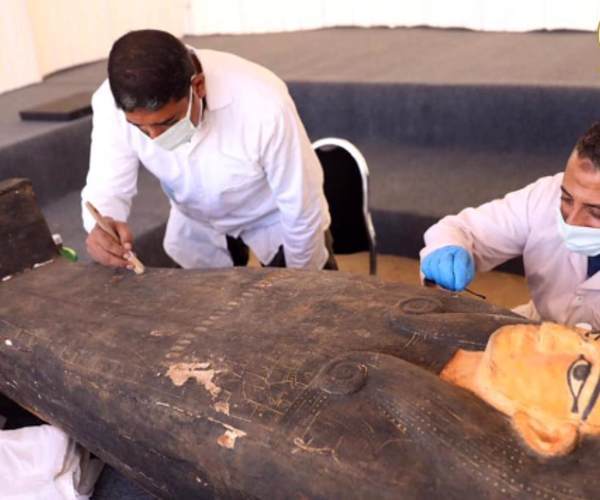
With the Coronavirus pandemic putting tourism on hold and it being an integral part of the economy, Egypt has been eager to attract visitors back to its archaeological sites, and these findings are a big step in that direction.
A press conference was held on October 3rd in Saqqara Necropolis, where Egypt’s Minister of Tourism and Antiquities; Khaled El-Anany opened of the coffins in front of ambassadors and media representatives. This group of foreign ambassadors come from 43 countries and also 200 media representatives were present who were introduced to a new part of Egypt’s great civilization. El-Anany mentioned how proud he is of these discoveries having been made by Egyptian teams on Egyptian soil and that the pandemic did not stop his colleagues from unearthing more treasures in the Saqqara Necropolis. At the press conference was acclaimed Egyptian Egyptologist Zahi Hawass who said to the Secretary General of the Supreme Council of Antiquities Mostafa Waziri, “You brought me back to action”.

Another announced discovery for the Egyptian archaeological mission headed by Mostafa Waziry is a carved bronze statue of the God Nefertum in Saqqara Necropolis. The statue is inlaid with precious stones, red agate, turquoise and lapis lazuli. The statue stands 35 cm tall and has the name of its owner engraved on its base; BadiAmunis. Mostafa Waziri added that the bronze statue was laid beside the newly discovered coffins and is one of several statues that the mission discovered during the excavation work inside an 11-meter-deep burial shaft.
The Saqqara discovery houses the largest number of coffins in one burial since the discovery of Al-Asasifcachette. You can learn more about this discovery through a docu-feature available only on Netflix by the name “Secrets of the Saqqara Tomb” as it documents the discovery of the one-of-a-kind tomb at the archaeological site in Egypt.
By Sherif Khalil
The must-see attractions in Luxor, Egypt

Luxor is a famous tourist location in Egypt, known for its oldest and most ancient Egyptian sites. If you ever decide to visit Upper Egypt and discover Luxor and Aswan, we have curated a list of the places you cannot miss when you are in the beautiful and ancient city of Luxor.
Even though the pandemic has minimized our adventures throughout the world, we must always keep an eye open to discover the wonders this world has to offer and plan our next possible journey to explore, while of course, staying safe and keeping our distances.
1. Valley of the Queens
Initially a burial ground for the royal Queens of ancient Egypt, this valley holds over 90 tombs and is open for visitors from around the world. The first ever tomb known to be built in the valley was that of Princess Ahmose, daughter of King Seqenenre and Queen Sitdjehuti. Even though the construction and entrance are not very impressive; rocky and scattered with stone, it is certainly worth taking a closer look at. The best of all tombs in the Valley of the Queens is the tomb of Nefertari, beautifully decorated with paintings on the wall describing Nefertiti’s life and her husband.
2. Valley of the Kings

Much like the Valley of the Queens, you will find the Valley of the Kings; built to hold the tombs of Pharaohs, such as Tutankhamun, Ramses II and more. The valley is found on the Nile west bank near Luxor and is evidence of preparations for the next world.
The tombs contain all the goods a Pharaoh might need in the next world, such as treasures, furniture, clothes and even pets have been found buried nearby. Even though there are over 60 tombs that have been discovered, archaeologists have confirmed that there is at least one late Ramesside Pharaoh’s tomb that is still undiscovered, alongside other possible discoveries lying in the same area.
3. Medinat Habu Temple
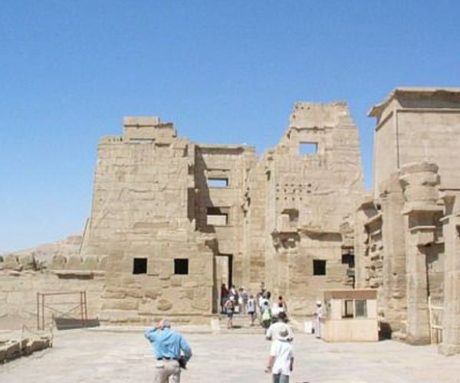
Medinat Habi is Ramses III’s memorial temple and it is considered one of the most underrated sites. Madinat Habu holds temples, storage rooms, workshops, a royal palace and more. It was once the center of the economic life of Thebes for centuries. The temple is of orthodox design and is 150m long. With well preserved walls and massive mudbrick enclosure surroundings, it resembles the nearby mortuary temple of Ramesses II.
4. Deir el-Bahari

Part of the Theban Necropolis, the Deir el-Bahari is a complex of mortuary temples and tombs. The first ever monument to be built at this site is the Mentuhotep II of the 11th Dynasty and during the 18th Dynasty, Amenhotep I and Hatshepsut were also built at the site.
Deir el-Bahari is one of the most distinctive temples in all of Egypt, due to its design and decorations and so you can’t possibly miss it. The temple was built to contain the achievements of Queen Hatshepsut and work as a funerary temple for her.
5. Tomb of Tut Ankh Amun

The tomb of the young Pharaoh Tutankhamun is found in the Valley of the Kings, discovered in 1922. The tomb is home to Tutankhamun’s mummy, model boats, statues, gold jewelry, chariots and more. It was one of the most important discoveries in the history of archaeology. The tomb took eight years to empty due to the state of the tomb and its contents have all been transported to the Egyptian Museum in Cairo, but alas, the place where it all began is still magnificent to visit and take a look at.
6. Hypostyle Hall

The architectural site is an interior space with a roof that rests on pillars and columns, creating a magnificent structure that seems like it would go on forever. The word ‘Hypostyle’ literally means ‘under pillars’ and its design allows for construction of large spaces such as temples and palaces without the need for arches. It contains 134 giant sandstone columns and is considered a colossal forest that after 3300 years, remain substantially intact to this day.
7. Luxor Temple

The Luxor temple was believed that it may have been a place where many Pharaohs were crowned. It’s found in the east bank of the Nile River in Luxor and was constructed in around 1400 BCE. Luxor temple is one of the primary cult’s temple, alongside the Karnak temple.
The Luxor temple is dedicated to the rejuvenation of kingships. You can also find the chapels built by Amenhotep III in the rear of the temple. During the Roman period, a chapel inside the temple was dedicated to the goddess Mut and was later transformed into a Tetrarchy cult chapel, then finally into a church.
8. Karnak Temple

Holding a mix of decayed temples, chapels, pylons and more, the construction of the complex began during the reign of Senusret I and continued into the Ptolemaic period. Karnak temple was considered the main place of worship of the 18th Dynasty with the God Amun as its head.
Karnak temple also happened to be a treasury, administrative center and palace for the New Kingdom pharaohs. With different purposes than the Luxor temple, they were both primary cult temples. Many of the Pharaohs contributed significant additions to the temple, such as Hatshepsut, Tuthmose III and Ramesses II. The complex is divided into 3 compounds, but while the precinct of Amun is the largest, it is most of the time considered enough for visitors as it’s quite a complicated layout.
Even though there are many more amazing places to visit in Luxor, you couldn’t possibly enjoy the full experience of this amazing city in a day or two. Make sure to make the most of your stay in Luxor; a most precious inheritance of Ancient Egypt. Stay safe during your stay and discover the beauty and history of Ancient Egypt in Luxor and while you’re at it, in Aswan, as well.
By Sherif Khalil
The delights of chartering a luxury yacht in Turkey
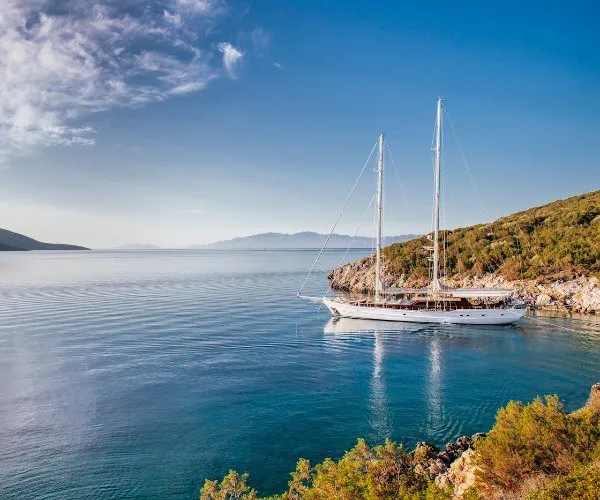
Endless days of sunshine and warmth beckon in the Eastern Mediterranean even as we head into winter, but you can start planning your next spring or summer holiday and take your friends and family to Turkey on a beautiful luxury gulet adventure in 2021. Now is the time to book one for this summer.
Gulets are traditional wooden-hulled vessels that are locally built and offer ambient surroundings great for celebrations: Many are used for weddings and birthdays but generally, Gulets offer a fantastic option for vacations for friends and family. The stunning Turkish Riviera, also known as the Turquoise Coast, is filled with beautiful wonders such as the Lycian Tombs which can become the scenic backdrop to your festivities. Pack the hours with golden sand beaches, crystal clear snorkelling and Scuba diving sites, and plenty of history and culture in Bodrum and beyond.
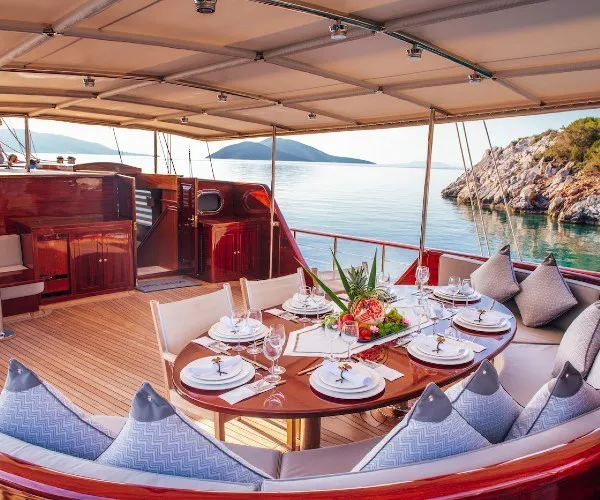
Highly coveted luxury yachts – whether brand new or with established reputations – come with an abundance of space onboard for the size of your group, a large and varied selection of water toys, generous cabins with TV entertainment, a well-stocked bar to accompany all those delicious meals, and a talented crew which might include a Dive Master, masseuse or even a Michelin-trained chef.
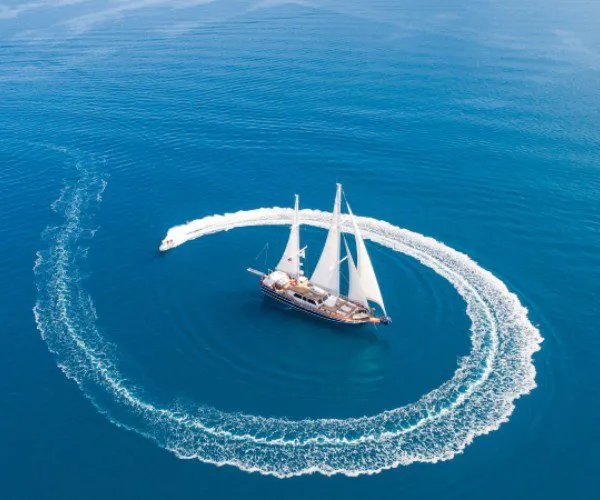
Luxury gulet HIC SALTA offers timeless surroundings in rich mahogany with every space efficiently used aboard this 43m/141ft vessel. Dine alfresco in the shade and cool down with fruity cocktails and desserts that will disappear the moment they arrive at the table. The sunbeds covering the foredeck will see much use from all 10 guests, and the air-conditioned interior offers one last place for a nightcap before bed. Another exceptional choice for celebrations is NURTEN A, designed with an outdoor bar close to large alfresco dining areas, and plenty of plush seating and sunbeds to make the most of each sunny day.
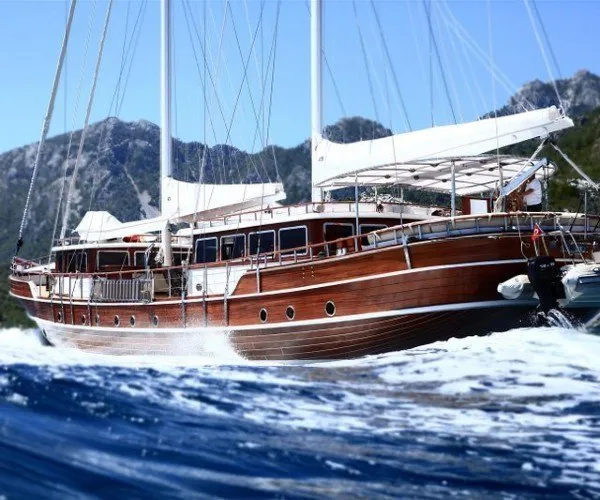
For those who prefer more modern surroundings, KAPTAN KADIR and UBI BENE both have a deceptively traditional exterior that gives way to a burst of contemporary colour and textures both outside and within, and other luxury gulets such as PERLA DEL MAR II, OGUZBEY and ELARA 1 have a Jacuzzi to unwind together over cocktails and the scenery. NAUTILUS not only has a Jacuzzi but a fireplace for added ambience, and a voluminous Master suite ideal for a bride and groom, while aptly named LOVE BOAT has accommodation for up to 32 guests across 16 en-suite cabins – significantly more than the usual 12 guests.
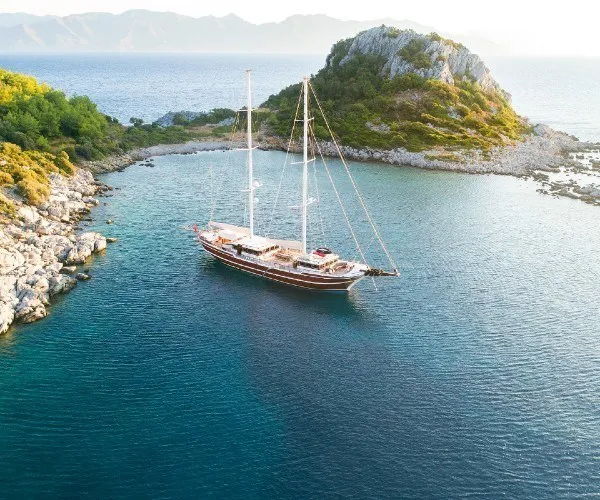
Water sports enthusiasts will want a vessel similar to CANER IV or DIDI, both of which have a fantastic selection of water toys ranging from jet skis to fishing equipment and towable toys to suit thrill-seekers as well as those who want to stay high and dry on board.
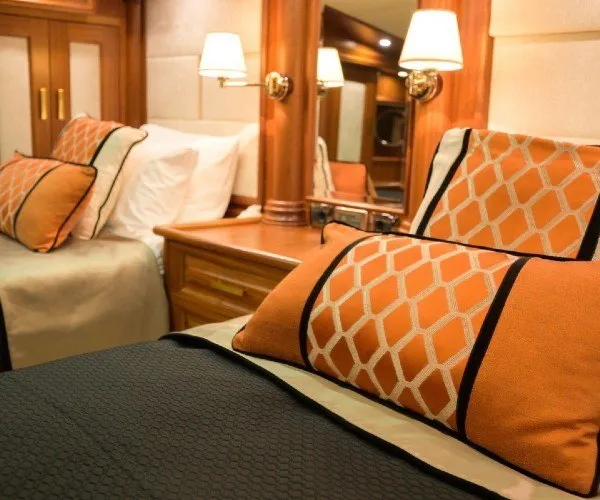
Kaş is a sensational destination for Scuba diving because of the wreck dives, caves and relics within the area. These natural sites are alive with colourful corals and fish of all shapes and sizes that create a mesmerizing sight for visitors of all ages. Guests heading ashore for culture will find Fethiye replete with offerings and landmarks such as the Hadrian Castle Gate into the historic Old Town, the Düden Waterfalls and the Antalya Museum. Shopping opportunities abound with shopping centres and markets for top-end gifts and authentic souvenirs. Bodrum, meanwhile, is home to one of the Wonders of the Ancient World – the Mausoleum at Halicarnassus.
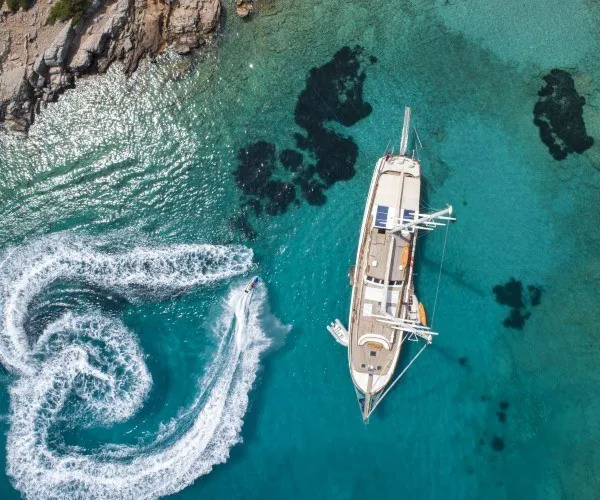
After a full day in these busy metropolises, sail away to a quiet anchorage to listen to the sounds of nature under clear starry skies. Sailing yachts ATALANTE and DEA DEL MARE are two smaller gulets ideal for accessing these shallower places, and the modern amenities onboard complement the traditional surroundings for an inviting and homely environment with everything guests could ever want.
By Trina Howes


